Visitor's Guide to the Opera Garnier in Paris
19th-Century Historic Building
:max_bytes(150000):strip_icc():format(webp)/profilepic-CTraub-5b6ff65d46e0fb00505577c1.jpg)
TripSavvy / Taylor McIntyre
Seating 2,200 people, the imposing Opera Garnier in Paris —also known as the Palais Garnier or simply the Paris Opera—is an architectural treasure and essential spot for the city's ballet and classical music scene.
Designed by Charles Garnier and inaugurated in 1875 as the Academie Nationale de Musique—Theatre de l'Opera (National Academy of Music–Opera Theater)—the neo-baroque style Opera Garnier is now the home of the Paris ballet. This does create some confusion for many tourists (ballet in the opera theater).
For anyone hoping to enjoy a Parisian Opera rendition of La Traviata or Mozart's The Magic Flute, the city's official opera company relocated to the starkly contemporary Opera Bastille in 1989.

Location and Contact Information
The Palais Garnier is located in Paris's relatively central 9th arrondissement, more or less directly north of the Tuileries Gardens and the adjoining Louvre Museum. It's one of the crowning attractions of the Opera-Haussmann neighborhood; one of Paris's most coveted shopping districts and the hub of major department stores like Galeries Lafayette and Printemps.
To make a morning or afternoon of it, you can visit the Opera, take a stroll around the old department stores, and have lunch in one of the gorgeous old 1900 brasseries in the vicinity (such as Cafe de la Paix, right across from the Opera). Then wander through the grand old streets in the vicinity—an area that's considered one of the crowning jewels of Haussmann's remodeled Paris.
- Address: 1, place de l'Opera, 9th arrondissement
- Metro: Opera, Pyramides or Havre-Caumartin
- Website : https://www.operadeparis.fr/en
Access, Opening Hours, and Tickets
Visitors can tour the main premises of the Opera Garnier during the day and visit the site's museum, either on an individual basis or as part of a guided tour.
Opening Hours
10 a.m. to 4:30 p.m. (September 10th to July 15th); 10 a.m. to 5:30 p.m. (July 15th to September 10th). Closed January 1st, May 1st. The cashier closes 30 minutes before the official closing time.
Ticket prices for ballet and other performances vary. Current performances at the Opera Garnier change so be sure to check to see what is upcoming.
Food and Dining
A recently opened restaurant situated on the Palais Garnier's eastern side (simply called "L'Opera") offers good-quality cuisine for breakfast, lunch, or dinner. Fixed-price menus are available at limited times.
Like This? Read These Related Features
Make sure to read our complete guide to Paris for music lovers , which gives you an excellent overview of the city's best venues, annual festivals, and more.
Music fans of all persuasions will love the Philharmonie de Paris, the latest newcomer to the city's art landscape and offering an eclectic program of musical performances, from classical to the world to rock. Meanwhile, if you want to enjoy contemporary opera in Paris, check out the boldly modern charms of the Opera Bastille.
Finally, for traditional French "chansons," dance, and late-night reveries check out our guide to the best traditional cabarets in Paris, from the Moulin Rouge to more avant-garde (and less expensive) revues like the Zebre de Belleville.
Top 15 Monuments and Historic Sites in Paris
All About the Jardin des Tuileries in Paris
Top 15 Things to Do at Night in Paris
Taking the Roissybus to or From Charles de Gaulle Airport
Luxury Shopping in Paris Boutiques and Stores
9 Places for Jewish History in Paris, From Museums to Memorials
A Self-Guided Tour of Parisian Architecture
May Events in Paris: Festivals, Sports & More
All About the Yves Saint Laurent Museum in Paris
Paris for Music Lovers: A Complete Guide to Venues and Festivals
Les Invalides in Paris: The Complete Guide
Review of Context Travel Walking Tour: The Making of Modern Paris
The Best Markets in Paris (For Every Type of Traveler)
The Top 15 Things to Do in Bordeaux, France
18 Best Free Things to Do in Paris
The 7 Best Places for Shopping in Paris
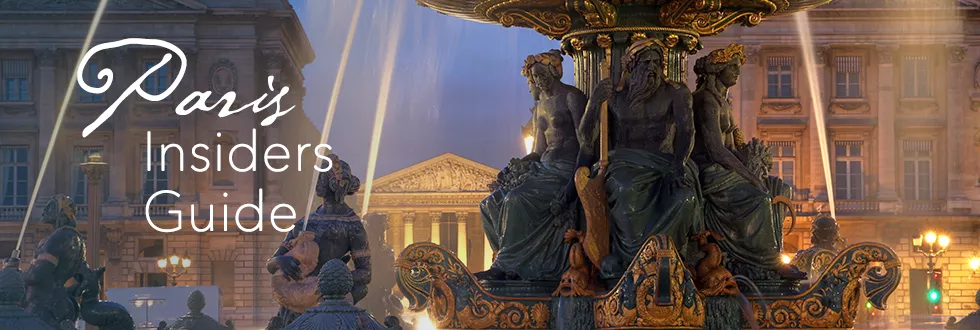
What's On in Paris
Performances.
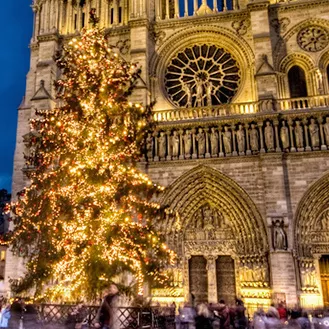
- Christmas in Paris
- The Eiffel Tower
Monuments in Paris
Historic churches, history museums.
- The Louvre Museum
- Musée d'Orsay
The Top Paris Museums
Artist museums, more paris museums.
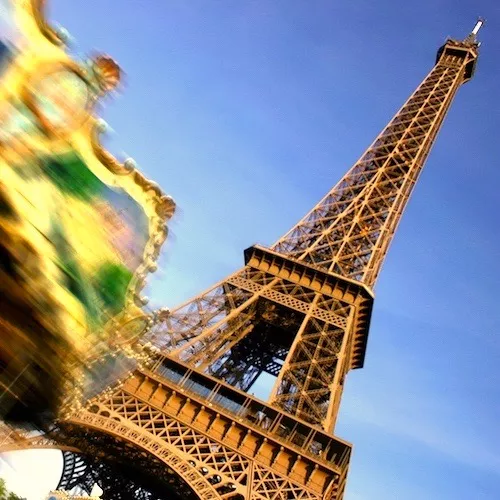
Eiffel Tower Skip-the-Line
The 6 essential day trips, 10 more iconic day tours, what to do in paris, seine river cruises, night in the city of light, paris city tours, walking tours, your own private paris.
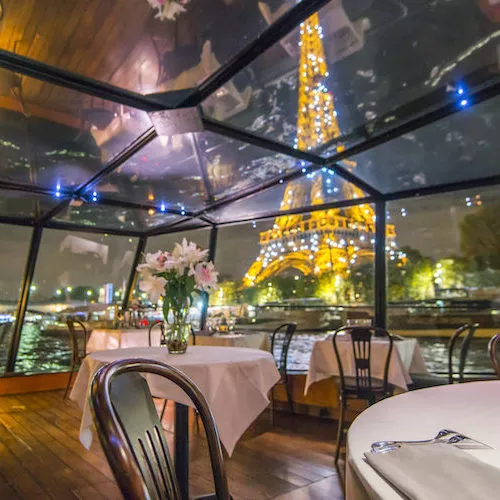
- Romantic Dinner Cruises
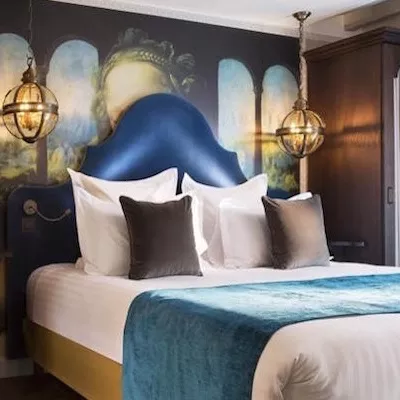
The Top Left Bank Hotels
The best hotels in paris, boutique & romantic, top hotels near…, preferred 5-star hotels, the palaces of paris, affordable hotels.
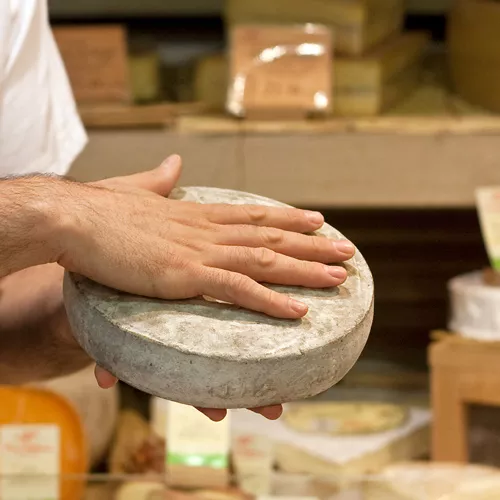
Le Marais Food & Wine Tour
Food & wine activities, the foods of paris, memorable paris dining, best paris restaurants, paris restaurant guide.
- Bistros & Brasseries
Top-Rated Restaurants

- Visit the Champagne Region
Paris Attractions
You ask, we answer, visiting burgundy, paris miscellanea, top ten lists, unusual paris sights, paris gardens & parks, the paris explorer.

- What's On When You're Here
Airports & Transfers
Getting around paris, paris travel guide, paris essentials, train travel, paris arrondissements, palais garnier – the belle époque ballet & opera house of paris, palais garnier – the belle époque opera house of paris.
With its gleaming golden facade and imposing columns Palais Garnier dominates Place de l'Opera in the 9th Arrondissement . Palais Garnier tops our list of things to do when we're in Paris. It's the primary venue for the Paris Ballet company and the best way to experience the sumptuousness that is Palais Garnier is to attend a performance there. We recommend you buy your tickets online before you leave home. You won't regret it!
Our Top-Rated Museum Tours in Paris
1. Louvre 2-Hour VIP Tour… This small-group option is the best experience
2. 3-Hour Louvre Semi-Private Tour… Feel like a VIP on a small group tour
3. Musée d'Orsay Impressionist Tour… The top-rated museum tour in Paris
4. The Louvre + Musée d'Orsay… The two iconic museums on a private tour
4. The Paris Museum Pass… Free entry to over 60 museums and monuments
1. Louvre 2-Hour VIP Tour…
2. 3-Hour Louvre Small-Group Tour…
3. Musée d'Orsay Impressionist Tour&hellip
4. The Louvre + Musée d'Orsay…
10 Fun & Fabulous Facts About Palais Garnier

When it was completed in 1875 Palais Garnier was one of the largest opera houses in the world. Emperor Napoleon III's vision was to create a temple to the arts, a world center for artistic pursuits, and an architectural wonder of the age.
The architect Charles Garnier faced a number of challenges during the fourteen-year construction (originally estimated to take seven years). One problem arose with the discovery of an underground lake — it took almost a year to pump out the water. Then, of course, there was that pesky Franco-Prussian War in 1870-71. Oh, and the destructiveness of the Paris Commune .
Charles Garnier's travels, his study of Greek and Roman classics, and his Beaux-Arts training is evident in the design and decoration for the opera house. He expertly employed classic principles such as symmetry and concentric forms within rectangular frames, and gave the opera house the pomp of a palace.
The front facade with massive columns references the Louvre. Garnier chose six types of stone and precious metals to reference classical temples.
The dominant interior colors are red and gold. Garnier said he chose red for the soft velvet interiors to "complement the ladies' blushing low necklines"!
Discover What's On When You're Here...
Discover what's on when you're here.
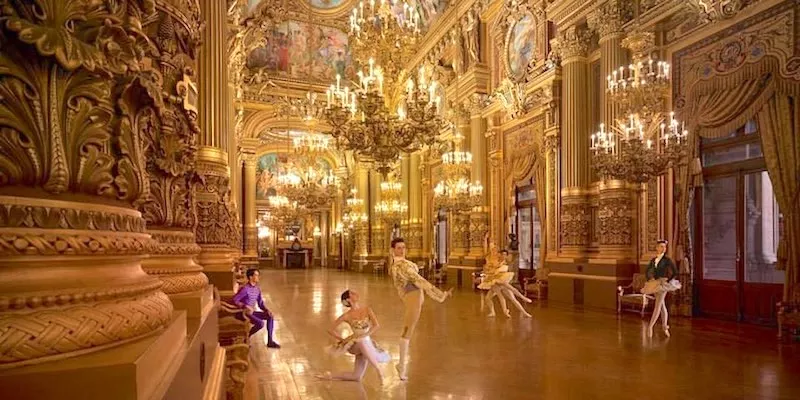
Garnier's goal was to make everyone who entered the opera feel as if they were the stars of the show. He achieved this with the lavish Neo-Baroque style — grand marble staircases, elegant corridors, and hidden alcoves.
The six-ton chandelier was a marvel for its time, although critics complained (as they will) that it obstructed the views and that the light was too bright. There is a persistent rumor that it was this chandelier that specifically inspired Victor Hugo's classic novel, The Phantom of the Opera .
One hundred sculptors and painters worked around the clock to complete the artwork. (But not, we assume, for the entire fourteen years.) Most of the interior and exterior statues portray Greek deities.
The facade is ornamented with seven archways, each decorated with two marble columns, sculpted statues, and a pair of gold statues.
Look for the gilded bronze busts of great composers, located between the columns on the front facade — you'll find Gioachino Rossini, Daniel Auber, Ludwig Beethoven, Wolfgang Mozart, Gaspere Spontini, Giacamo Meyerbeer, and Fromental Halevy.
Charles Garnier's design would go on to inspire architects around the world. You can see influence from his design for the Palais Garnier in the Warsaw Philharmony, the National Opera House in Kiev, the Thomas Jefferson Building of the Library of Congress in Washington DC, the Hanoi Opera House, and the Theatro de Rio de Janeiro.
Romantic Dinner Cruises In Paris
The history of palais garnier.
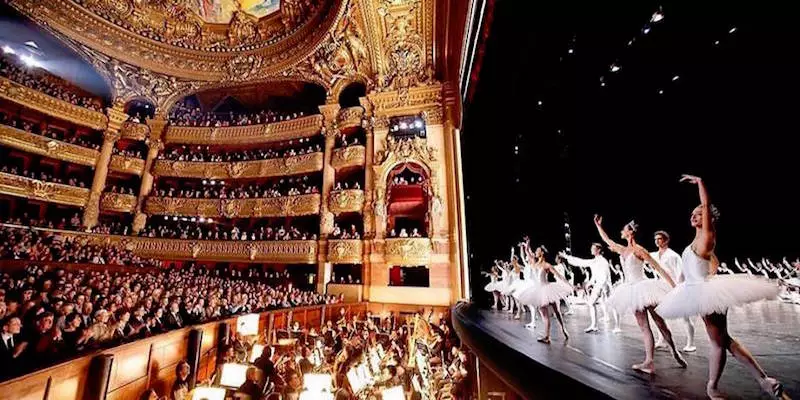
The story of the Palais Garnier Opera House takes in the demolition and rebuilding of Paris as well as the attempted assassination of an emperor. From the middle to the end of the 19th century, Paris was transformed from a city of narrow, unclean, and unsafe medieval streets into a well-lit modern city with broad boulevards and a great sewer system!
This was the period when Baron Haussmann , under the direction of emperor Napoleon III, undertook the modernization of Paris — demolishing existing buildings, rues, and avenues; replacing them with straight, broad streets, flanked by uniform five-story buildings. When the emperor was nearly assassinated in a narrow street outside the then-current opera house, Napoleon III decided enough was enough and commissioned a new opera building to be located in an imposing spot on one of the new-created places .
Experience the Splendor Of Versailles

Charles Garnier
The commission was awarded to a then-unknown architect, the young Charles Garnier, and building began almost immediately. Construction was delayed, however, by the disastrous Franco-Prussian War and the aforementioned Commune in the period 1870-71. The grand opera building finally opened on January 5, 1875.
Palais Garnier became the center of Paris cultural life during the Belle-Époque period of the late 19th and early 20th centuries. It continued on as France's most prestigious opera house right through the World Wars and into the 1960s.
Over the decades — through the wars and with the advent of the automobile — the exterior of Palais Garnier became dull and grimy. But a recent multi-year cleaning and renovation has restored it to its original glory. The interior is just as breathtaking, and it's a must-visit place — particularly to attend a performance of the Paris Ballet Company , small opera productions, or other special performances.
Two Of The Most Popular Paris Experiences
The most popular paris experience, the history of paris ballet & opera.
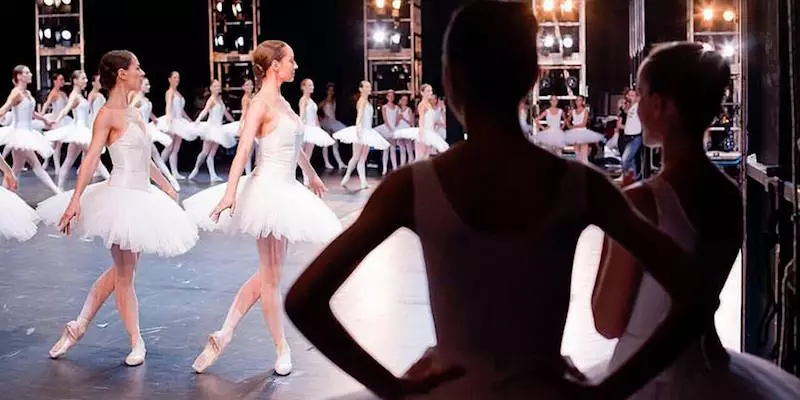
Paris has been mad about opera & ballet since the mid-1600s, during the reign of Louis XIV (AKA the Sun King) who founded the first Paris opera house in 1669. Since then there have been no fewer than thirteen buildings that have housed the Paris Opera Ballet company. Through kings and revolutions, emperors and presidents and wars there have always been ballet and opera playing in Paris.
A surprisingly number of the Paris ballet houses were destroyed by fire — others have simply outlived their usefulness and been razed. For instance, there was the Théâtre de la Porte Saint-Martin built for Marie Antoinette in 1781, abandoned during the Revolution, and destroyed in a fire during the Commune of 1871. Luckily for us, however, Palais Garnier, the grandest example of them all, still exists and it as glorious as ever.
Find Hotel Deals for Your Dates in Paris
Palais garnier resources.
- If you want to look and feel part of the scene — dress up!
- It's recommended that men wear a sports jacket and women wear a dress or an elegant outfit.
- Arrive for your opera or ballet performance at least 15 minutes before the show starts.
- Once the show starts, the doors are closed until the end of the first act.
- Metro – Opera
- RER – Auber
Paris Planning Guides
Copyright © 2010-2023 Voconces Culinary Ltd, all rights reserved. Original photos © Mark Craft, all rights reserved.
- • May 2024 in Paris…
- • June 2024 in Paris…
- • July 2024 in Paris…
- • August 2024 in Paris…
- • September 2024 in Paris…
- • October 2024 in Paris…
- Paris Activities Month by Month
- Paris Olympics 2024
- Paris Events Calendar
- Museum Exhibitions Calendar
- Paris Ballet Calendar
- Paris Opera Calendar
- Christmas Day in Paris
- New Years Eve
- New Years Day in Paris
- Easter in Paris
- Valentines Day in Paris
- Bastille Day Celebrations
- Skip-the-Lines at the Eiffel Tower
- Visiting The Eiffel Tower
- Eiffel Tower Information
- See all…
- The Arc de Triomphe
- The Panthéon
- The Bastille
- Notre Dame Cathedral
- La Sainte Chapelle
- Sacre-Coeur Paris
- Chateau de Versailles
- Palais Garnier Opera House
- Hotel de Ville – The City Hall
- Get the Most from Your Visit
- Masterpieces of the Louvre
- Paintings of the Louvre
- Top 10 Van Goghs at d'Orsay
- Musée de l'Orangerie
- Centre Pompidou
- Musée Picasso
- Rodin Museum Paris
- Cluny Museum Paris
- Arts et Metiers
- Guimet Asian Arts Museum
- Galliera Fashion Museum
- Versailles the VIP Way
- Versailles History & Highlights
- D-Day Landing Beaches
- Monet's Gardens at Giverny
- Mont Saint-Michel
- Monet + Van Gogh
- VIP Private Day Trips
- 10 Ways to Skip the Lines
- 9 Most Romantic Things to Do
- 5 Top Activities In The Marais
- Lunch & Brunch Cruises
- Cruises with Extras!
- The 6 Best Evenings In Paris
- Moulin Rouge
- Paris at Night
- Hop-on, Open-Top Buses
- The 6 Best City Tours
- Private Tours of Paris
- Champagne & Shows
- Top 10 Walking Tours
- Mysterious Walking Tours
- Shangri-La Paris
- Hotel George V Paris
- The Royal Monceau
- Le Cinq Codet
- Peninsula Hotel Paris
- Hotel Le Burgundy
- See all …
- 10 Best 4-Star Hotels
- Top 3-Star Hotels
- Best Airport Hotels
- Latin Quarter Hotels
- Left Bank Hotels
- Romantic Paris Hotels
- Best 2-Star Hotels in Paris
- Ibis Hotels
- Les Hotels de Paris
- Best Western Hotels
- Saint-Germain-des-Prés
- Top 10 Food Experiences
- Paris Wine Tastings
- Chocolate Tours
- 10 Best Cheese Shops
- The Best Baguette in Paris
- Food Markets of Paris
- Le Jules Verne
- Jacques Faussat
- Restaurant Le Gabriel
- How to Choose a Restaurant
- The Best Paris Bars
- In the Marais
- On the Left Bank
- Historic Brasseries of Paris
- Michelin 3-Star Restaurants
- 6 Michelin-Star Restaurants
- See All…
- Best Paris Terraces
- Seine Dinner Cruise
- The Top 8 Tourist Attractions
- 5 Paris Itineraries
- Gardens & Parks
- Paris Hotels for Christmas?
- Best Restaurants in the 8th?
- Best Way To Visit Versailles?
- VIP Burgundy Wine Tour
- Burgundy Accommodations
- Napoleon's Paris
- Hemingway's Paris
- Medieval Paris
- 10 Tips For Visiting Paris
- 7 Vestiges of Roman Paris
- 13 Hidden Places In Paris
- Hidden Landmarks
- The Catacombs
- Pere Lachaise Cemetery
- Jardin des Tuileries
- Jardin des Plantes
- Palais Royal
- Rue des Barres in the Marais
- Waterfalls of Paris
- Arcades of Paris
- Airport Transfers
- Paris Airports
- Airport Taxis
- Train Travel From Paris
- Eurostar: London & Paris
- Paris Train Stations
- The Latin Quarter
- Saint-Germain-des-Pres
- Essential Facts for Visitors
- Taxes, Tipping & Etiquette
- What to Wear in Paris
- Maps of Paris
- The Paris Metro
- Paris Metro Tickets
- Paris Taxis
- Seine River Dinner Cruises
- Visiting Versailles
- Essential Day Trips

Guide to Paris’ Opera Garnier: Inside the Phantom’s Lair
Here’s my guide to visiting the glamorous Opera Garnier in Paris. The opera house is a must visit attraction in the 9th arrondissement.
A creation of Charles Garnier, it was part of Napoleon’s great makeover of Paris. It’s highly decorative, a mix of Beaux-Arts symmetry and Baroque and Renaissance elements.
Visiting Paris’ Opera Garnier is a dual-purpose immersive experience.
You can experience the incredibly opulent palace space, designed by Charles Garnier. And you can re-live the Gothic potboiler, The Phantom of the Opera , from Gaston Leroux and Andrew Lloyd Webber fame.
What could be better? An over the top Paris opera house for an over the top murder-y opera villain.
Until recently, I hadn’t been inside for a long time. I saw the famous Chagall ceiling when I was young.
Thereafter, I satisfied myself with admiring the impressive facade of what may be the world’s most famous opera house, as I strolled past it in the 9th arrondissement .

But the last time I was in Paris , I was assailed by murky recollections. And by the Phantom’s plaintive theme song playing “there inside my mind.”
I hadn’t planned on going in. But I did. It’s almost as if I was involuntarily ventriloquized by Andrew Lloyd Weber.
If you don’t want to head to Versailles and suffer through the awful lines, come here instead.
The Opera Garnier’s just as sumptuous, maybe more so, than Versailles and hence a great alternative. Truly, the opera is one of Paris’ most unsung hidden gems , a gaudy jewel box treasure.
Open the jewel box and look in, don’t just stroll by.
History of the Opera Garnier
The Opera Garnier, also known as the Palais Garnier, first sprang from the brain of Napoleon III.
It wasn’t a calculated choice. While attending the Opera of Rue Le Peletier, Napoleon barely escaped a bomb in an assassination attempt.
Right then and there, Napoleon resolved to build a new opera house that he could safely attend. One that had a private entrance just for him. Besides, Paris needed a glamorous new theater.
In 1860, Napoleon held an international competition for the design of the new Paris Opera. 171 proposals were submitted anonymously.
An unknown architect won, the 34 year old Charles Garnier , putting the seasoned Parisian architects to shame. His project was number #38, named “I aspire to much, I expect little.”
Garnier was so inexperienced that he didn’t even have his own office. He had to build one on the opera site. And he didn’t like the site overly much. It was smushed together and enclosed between four roads in the shape of a diamond.
Garnier repeatedly asked for a different venue. But the answer was always no. Haussman’s grand boulevards and Paris’ urban renewal were the first priority. Roads were more important than opera.
In 1861, Garnier began construction. His masterpiece took 15 years to finish. The opera is wholly Garnier’s creation, from start to finish. He designed everything.
Garnier also selected and guided the work of collaborating artists, many of whom were prestigious grand prize winners. In total, there were 15 principal artists, 75 sculptors, and myriad artisans who slaved away on the Opera Garnier.
It didn’t all go smoothly. In 1962, the builders discovered a lake underneath the site.
They created a stone cistern — an artificial lake — for the water and underground tunnels, as a work around. Even today, the cistern halts the rising water, though water still needs to be pumped out. The tank’s also used for Paris firefighters to practice nighttime swimming.
Construction of the Paris Opera was also controversial. Almost operatic, if you will. Everyone felt entitled to weigh in on the splashy new place.
Garnier’s plan was mocked as a labyrinth, a turkish bath, and wedding cake. Even Empress Eugenie asked Garnier what style he was aiming for. His terse response was that it was “in the Napoleon style, Madame.” Louis XIV style was passé.
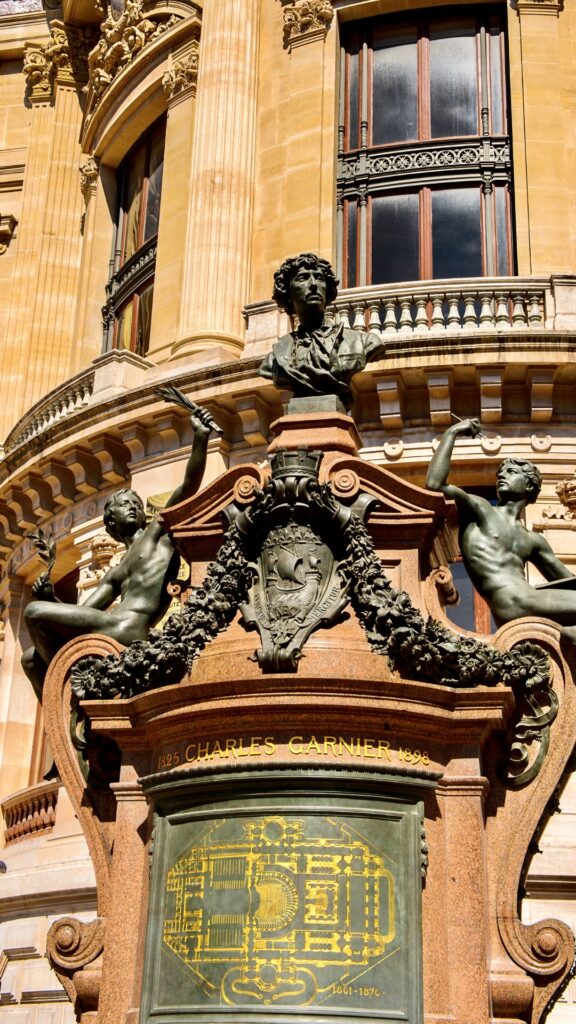
During construction, the opera facade was kept under wraps, to build tension. When the opera was finally inaugurated in 1875, the public saw the showy facade for the first time.
And they were stunned.
Tickets & Tours
The Opera Garnier is a popular attraction that you should book ahead. Click here to book a skip the line ticket. Click here to book a 2 hour guided tour.
Guide To The Opera Garnier: What To See
Here’s what you’ll see on a visit to the Opera Garnier.
Exterior Facade
The exterior is sometimes compared to a wedding cake. You can sort of see why.
It’s built in a rather bombastic Beaux-Artes style with eclectic Neo-Baroque elements. Between the grand columns are bronze busts of great composers. The two gilded figures crowning the facade on the left and right are Harmony and Poetry.
At the very top, there’s a statue of a shining Apollo holding up a lyre. He seems intent on proclaiming that the opera house is THE place for arts.
One the eastern side is the Emperor’s Pavilion, the only non-symmetrical part of the building. This was the entrance for Napoleon and wealthy season ticket holders. It’s now closed.
The most famous sculptural group on the facade is The Dance by Jean-Baptiste Carpeaux.
When it was unveiled in 1869, it caused an immediate furor because of its “obscene” nude figures. An anonymous vandal even threw black ink on the sculpture.
Carpeaux steadfastly refused to sculpt a substitute. But during the fall of the Second Empire, critics were distracted.
The sculpture was forgotten and never replaced. Now, there’s a replica on the opera facade and the original is in the Musée d’Orsay.
READ : Guide To the Masterpieces of the Musee d’Orsay
Paris Opera Interior
You enter on the left side and are greeted by a bust of Garnier.
The interior was designed in four segments: the entrance, the auditorium, the stage, and the administrative offices. As you proceed through, it’s almost a crescendo, with each room more magnificent than the next.
The acoustics were outstanding, and the stage one of Europe’s largest.
The highlights are the Grand Staircase, the Grand Foyer, and the Chagall Ceiling. You begin on the ground level and are greeted by costumes. The Opera Garnier makes all their own costumes, an impressive feat itself.
1. Grand Staircase, aka the Catwalk
Then you walk up the jaw dropping Grand Staircase. It’s made entirely of marble, and surrounded with arches, hidden nooks, statues, and gold — gold everywhere.
In the 19th century, the haughty Grand Staircase was a gossipy soap opera, the place to see and be seen.
Garnier aptly said that “The opera is the staircase.” The scandalous stairway revealed all — who was together, who was having affairs, who was favored, who was scorned.
The staircase is made of white marble from Italy, with balusters of antique red and green marble. The staircase is flanked by 36 large columns, and divides into two staircases that direct opera goers to their respective seats.
The ceiling has fresco by Isidore Pils, painted in 1869-74, that depicts the Triumph of Apollo. At the top of the staircases are large torchieres.
2. The Grand Foyer, a Mini Versailles Hall of Mirrors
The 18 foot high Grand Foyer is astonishing. It’s decidedly reminiscent of the Hall of Mirrors at Versailles.
This was the place where aristocrats strolled after they were done “acting” on the Grand Staircase or during intermission.
The room is all gold and glitter. At the top, is another impressive ceiling fresco, this one by Paul Baudry, which shows the history of music.
The foyer’s key decorative motif is the lyre. The Grand Foyer was renovated to perfection in 2004.
At each end of the grand foyer lie two salons. The Salon du Soleil (Sun Salon) has a golden sun burst and mirrored walls. The Salon de la Lune (Moon Salon) boasts a night sky adorned with silver moon rays and stars.
The sun room was supposed to represent fire and be the smoking room. The moon room was supposed to represent ice, for a cool sorbet.
But the decorator reversed the schemes to Garnier’s dismay. Opera goers were forced to traipse through the “ice room” to smoke a cigar and the “sun room” to nibble a sorbet.
3. Chagall Ceiling: A Surrealistic Gift to Paris
The Marc Chagall ceiling isn’t original. It was commissioned in 1964 and placed over the existing academic painting by Jules-Eugene Lenepveu, The Muses and the Hours of the Day and Night .
But it’s so much better. It’s the perfect backdrop for the Garnier-designed 7 ton bronze and crystal chandelier.
Legend holds that General de Gaulle and Andre Malraux, minister of culture, were attending an opera with a set and costumes designed by Chagall. The minister glanced at the ceiling and frowned in tedium. On the spot, he asked Chagall to design a new ceiling.
Chagall was a “modern” artist back then. His supernatural style work drew from the artistic movements of Surrealism, Fauvism, and Cubism.
The proposed ceiling was controversial. Some people don’t like anything new. Some thought it was garish and would clash with the opera’s Second Empire decor.
To keep the peace and as a concession to critics, Chagall proposed that Lenepveu’s work be preserved and Chagall’s be placed on a removable canvas stretched over it.
The mural took Chagall a year to complete. It consists of 12 canvas panels and a round central panel covering 240 square meters.
Chagall was 77 at the time and it was an act of love. He donated it to the opera house gratis. The mural has his trademark features — luminous prismatic colors, dreamy details, and poetic lyricism.
If you look closely, you’ll see that the ceiling is an homage to music. It features 14 composers from different musical periods, musical instruments, and Paris’ signature buildings.
Malraux is even hidden behind a window. Chagall’s ceiling helped make the opera more fashionable again.
4. Auditorium and Stage
Red is the color of glamor. And that’s what you’ll find in the opera auditorium.
If you want to actually visit the auditorium, you have to go on a guided tour. On the self-guided audio tour, you can only peek through a window and can’t properly see the Chagall ceiling.
The auditorium is very ornate, decorated in red velvet, marble, and gold leaf. Because you can never have enough gold leaf in an opera house. If you’re thinking that it’s just all too much, remember that opera itself a florid overwrought affair.
The stage is a classic horseshoe shape. The curtain is actually made of canvas, but contrived to appear like draping velvet. The stage featured many luminaries, including opera star Maris Callas and dancer Rudolf Nureyev.
The auditorium seats almost 2,000. While gorgeous, the seats don’t look terribly comfy. They were made in another era, where comfort didn’t dictate nearly everything.
The most expensive seats are the boudoir-like boxes, though they have a slightly obstructed view of the stage.
The point, of course, was to be seen by others, not to have the most ideal view of the performance. Or, to draw the velvet curtains for a tryst. The opera’s a romantic place, after all.
Phantom of the Opera: Inspired by the Opera Garnier
By today’s politically correct standards, with its clunky plot, Phantom of the Opera may seem a bit dated or patriarchal. But I can’t resist a lush high Gothic romance, even if the titular hero is a bit murdery. It’s escapism, as its author Gaston Leroux, a true crime writer and opera critic, no doubt intended.
Yet, the practical side of me always wonders where the Phantom got a horse and does he have a humidifier.
In any event, for purposes of this article, I want to explain how historical events at the Opera Garnier inspired Leroux’s 1910 potboiler. His fantasy novel is an ingenious blending of fact and fiction, with the Paris Opera as a star character.
The novel stars Erik as the phantom, a disfigured composer who wears a mask to cover his face. He takes up residence in the underground lake beneath the theater.
Erik becomes obsessed with a young soprano, Christine Daaé. He becomes her “angel of music,” giving her complimentary singing lessons.
The phantom rigs a chandelier to fall on the audience as a distraction, killing people. He then kidnaps Christine, taking her by gondola to his watery underground lair full of secret tunnels. He regales her with the title song Phantom of the Opera and Music of the Night.
Christine’s star rises, and a handsome suitor enters the picture. A jealous Phantom is furious and begins terrorizing the opera house. I won’t spoil the ending if you haven’t read the novel or seen the musical.
But many elements of Leroux’s novel, which is set in an opera house, come directly from the Paris Opera. The Phantom’s underground lake-lair is real, as I mentioned above. Though today it’s brightly lit, so not as eerily gloomy. And there are actually tunnels, just as Leroux wrote.
The Paris Opera chandelier is also featured in Leroux’s novel. In 1896, a counterweight fell from the real chandelier, killing a woman in the audience. In Phantom, Leroux also uses a falling chandelier as a major plot point, a dramatic scene (described above) of kidnapping and senseless murder.
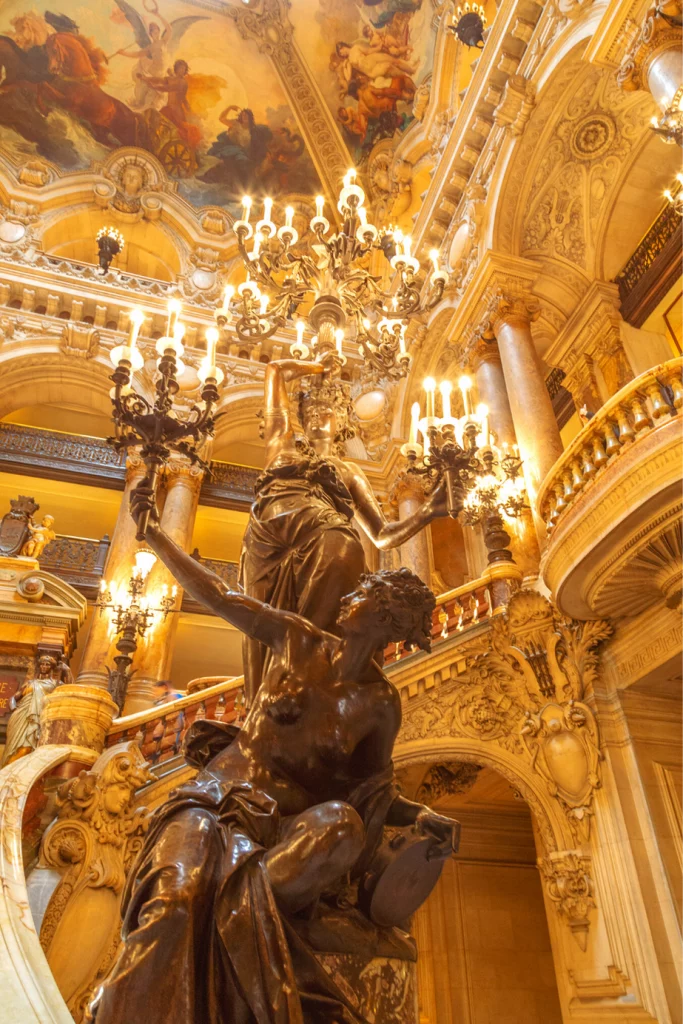
When Leroux wrote his novel, people also really thought that a pesky ghost was haunting the Paris Opera, just like the phantom haunts the opera in the novel and musical.
Paris Opera performers hung a lucky horseshoe by the stage to ward off evil spirits. Some claimed to hear ghostly whispers from Box #5, even when it was vacant.
Although the Christine-Phantom romance is fantasy, the characters of Erik and Christine may be based on actual people.
The grand masked ball they attend was set on the Paris Opera’s Grand Staircase. The Phantom appears on the staircase dressed as Red Death, carrying a copy of his new opera. His opera is then performed on a stage much like the Paris Opera stage.
Tips For Attending a Performance at the Opera Garnier
The Opera Garnier still functions as a world class performance venue. It’s the home of the Paris Ballet. So usually ballet is on the menu, but there are also concerts and operas.
You can check the schedule of performances here .
Just click on the calendar to see what’s playing that month. Click on Garnier, not Bastille. The new Opera Bastille utterly lacks the Garnier’s old world ambiance anyway.
It’s easiest to reserve online. You need to register on the website to book a ticket. Choose your seats. And voila!
Attire is mostly business-y or business casual, which makes sense because people are going to the opera house after work. You won’t need a fancy ballgown, unless you’re going to a special evening gala.
Like most US theaters, there’s a bar inside that sells champagne and snacks before the show and during intermission.
Arrive early to admire the gorgeous building and take photos on the iconic marble stairway. If the performance isn’t in English, there will be subtitles.
But don’t let the subtitles distract you from gazing, in adoration, at the sublime Chagall ceiling. If you’re not close enough, head to the orchestra section during intermission to take in the colorful centerpiece.
Don’t miss the glorious Opera Garnier. It’s an unmissable Paris site and one of the best things to do in the 9th arrondissement.
Swathed in gold, you can strain your ears to hear echos of the Phantom of the Opera. You won’t be kidnapped or killed. But you can visit the haunts that inspired the novel and bask in Garnier’s grandiose creation.
Practical Guide & Tips for Visiting the Opera Garnier:
Address: 8 Rue de Scribe, Place de l’Opera 75009 Paris
Hours: 10:00 am to 4:30 pm, Guide tours in English are at 11:00 am and 2:30 pm
Entry fee: 14 euros for a self guided tour. Not included in Paris Museum Pass.
Metro : Line 3, 7, or 8 to Opera
Pro tips: The nearest car park is Place Vendome. Access to the auditorium may be closed for technical reasons or performance rehearsals.
Virtual Tour : If you can’t get to Paris, you can explore the Opera Garnier virtually on Google Arts & Culture .
I hope you’ve enjoyed my guide to the Opera Garnier. You may enjoy these other travel guides and resources for Paris:
- 5 Day Itinerary for Paris
- 3 Day Itinerary for Paris
- 2 Day Itinerary for Paris
- One Day In Paris Itineraries
- Tips for Planning a Trip to Paris
- Tourist Traps To Avoid In Paris
- Top Attractions in Montmartre
- Top Attractions in the Latin Quarter
- Top Attractions in the Marais
- Best Museums In Paris
- Hidden Gems in Paris
- Secret day trips from Paris
If you like to visit the Opera Garnier in Paris, pin it for later.
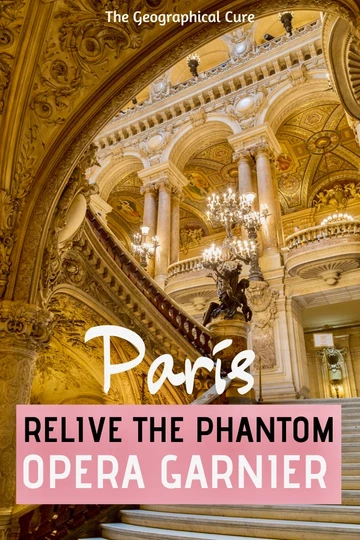
1 thought on “Guide to Paris’ Opera Garnier: Inside the Phantom’s Lair”
Very interesting many thanks for this, I would love to visit
Leave a Comment Cancel reply
Save my name, email, and website in this browser for the next time I comment.
Last Updated on January 29, 2023 by Leslie Livingston

Home > Paris Attractions > 15 Fascinating Facts about Palais Garnier (Opera Garnier Facts)
15 Fascinating Facts about Palais Garnier (Opera Garnier Facts)
Visit palais garnier, paris’ opera house.
The Palais Garnier Opera House (Opera Garnier) is one of the most unique places in Paris, France . A visit to the Paris Opera House for a show or a guided tour is one of the best things to do in Paris , so you cannot miss it! The Palais Garnier is located in Paris 9, not far from the Grands Boulevards or Place Vendôme.
The glamorous Opera Garnier was commissioned by Emperor Napoleon III as part of his project of reconstruction of Paris. To build the new Paris Opera House, a competition for the best design was conducted in 1860.
The competition winner was Charles Garnier , a young and unknown architect who presented a highly eclectic project borrowing elements from many historical sources.
The Opera Palais Garnier was completed in 1874 and today is considered a masterpiece of Neo-Baroque Architecture and one of the most beautiful places to visit in Paris. After a short introduction to the Palais Garnier history, how to visit, and what to see, we will tell you the most curious Palais Garnier facts.
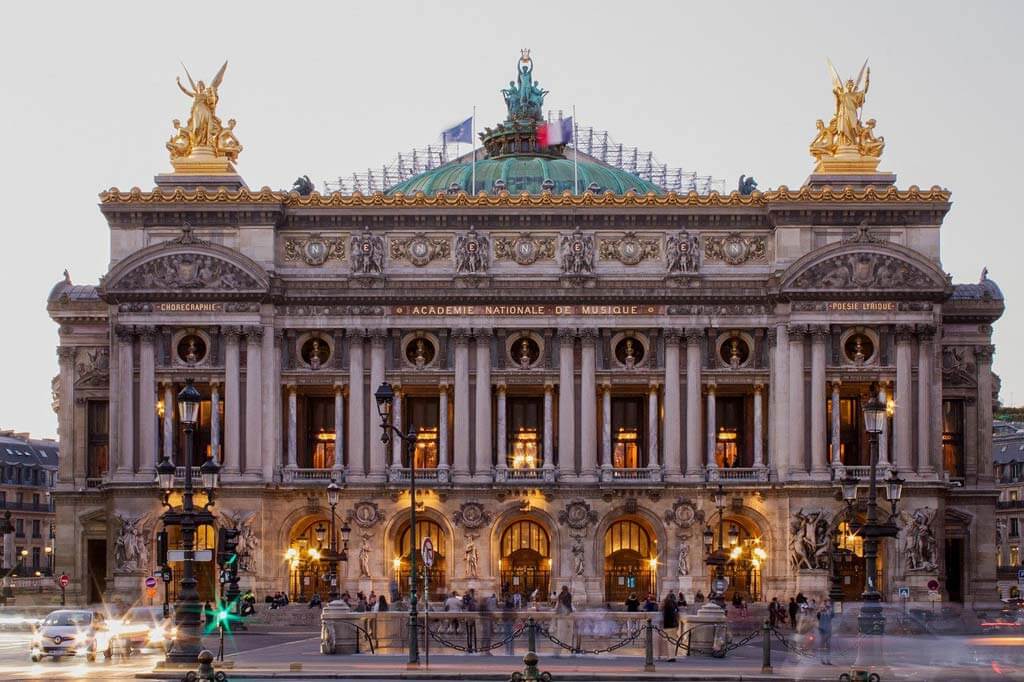
The Palais Garnier Opera House is one of Paris’s top sights to visit. We recommend visiting the Opera Garnier Paris in the following itineraries:
- 3 days in Paris itinerary
- 4 days in Paris itinerary
- 5 days in Paris itinerary
- 6 days in Paris itinerary
- 7 days in Paris itinerary

How to Visit the Opera Garnier in Paris
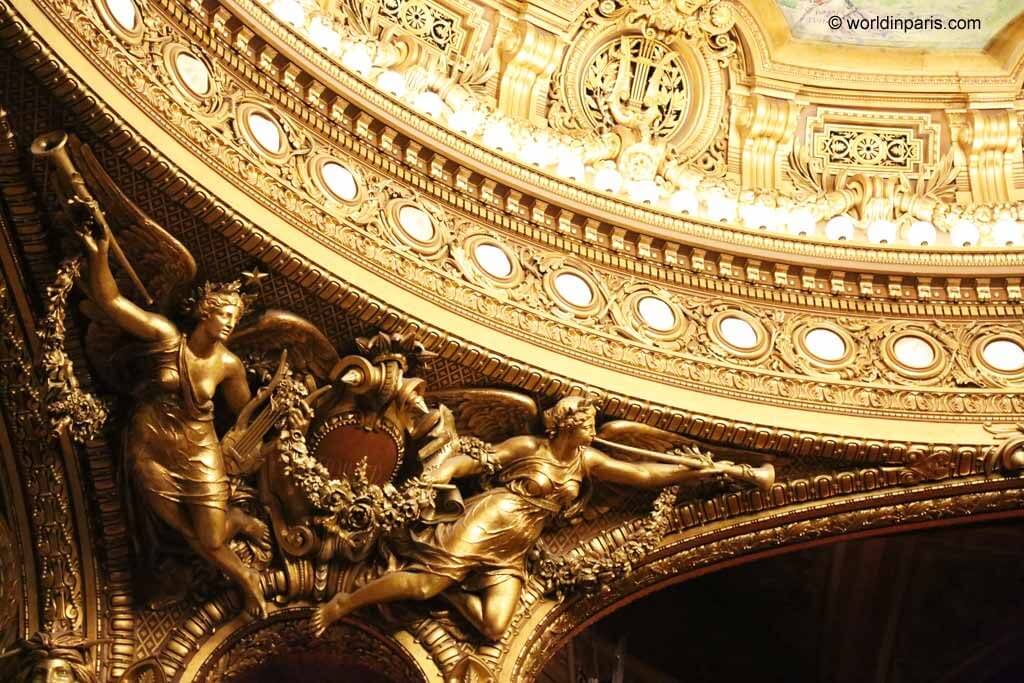
The best way to enjoy Opera Garnier is to attend a performance. The Paris Opera House proposes classical and contemporary ballets. If you want to attend a ballet at Palais Garnier, be sure to add something elegant to your Paris packing list!
GOOD TO KNOW: The Opera Paris has two sites: the Palais Garnier (Paris 9) and the Opera Bastille (Paris 10). The Opera Garnier is mainly used for ballets, while the Opera Bastille is the place to go to attend opera shows.
Take an Opera Garnier Tour
If you don’t plan to attend an opera or ballet during your trip to Paris, it is also possible to visit the Palais Garnier on a self-guided tour (with or without an audio guide) – Click here to book your Opera Garnier tour (self-guided)
Viator proposes an interesting 2-hour architecture walking tour with a guide that visits Opera Garnier and Galeries Lafayette , two of the city’s most magnificent buildings – Click here to book this Opera Garnier guided tour
If you are fascinated by the Phantom of the Opera , then book the Opera Garnier Mysteries guided tour . In addition to the history and Palais Garnier facts, this Opera Garnier tour puts more emphasis on the Phantom of the Opera story and other mysteries – Click here to book the Opera Garnier Mysteries guided tour
A Peek Inside Palais Garnier
The Palais Garnier Opera House is one of the most famous buildings in Paris . The Opéra Garnier is 154.9 meters long, 70.2 meters wide at the lateral galleries, and 101.2 meters wide at the east and west pavilions.
The Garnier Opera House has a 1,979 seating capacity, making it one of the world’s largest opera theaters!
The façade and the interior have no space without decoration and symbolize the opulence of the Second Empire. Charles Garnier, the architect, masterfully combined the colors and textures offered by different kinds of marble and stones, porphyry, gilded bronze, iron framework, and other materials.
If you plan to visit the Opera Garnier on a self-guided or guided tour, these are the three unmissable places inside Palais Garnier:
The Grand Escalier (Grand Staircase)
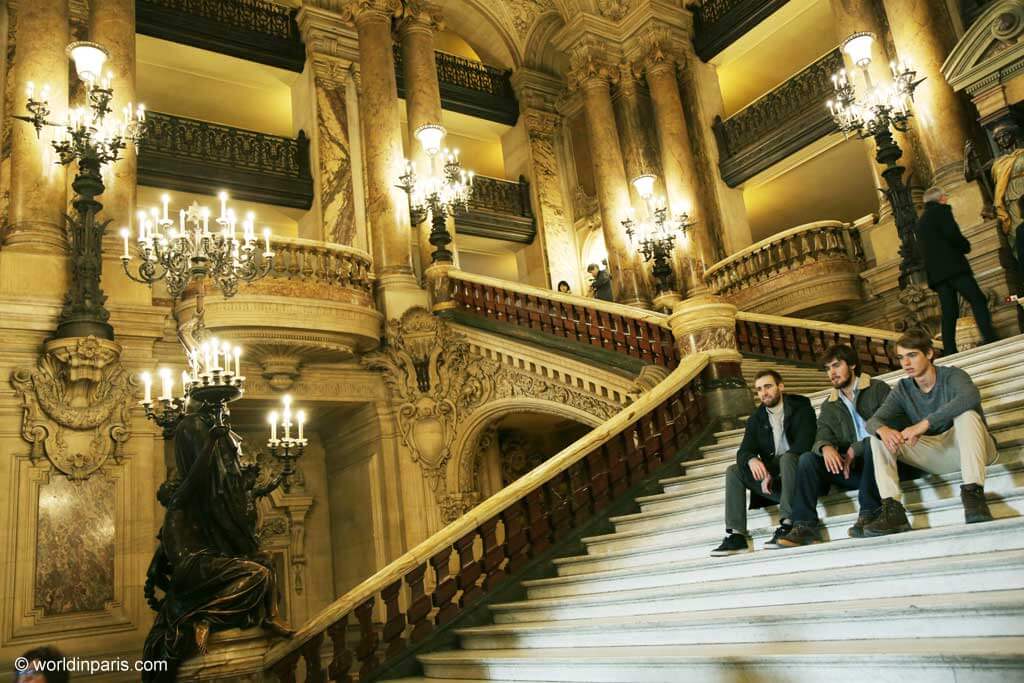
Opera Garnier’s Grand Escalier consists of a double staircase leading to the foyers of the theatre. Built with marbles of different colors, the Grand Escalier is covered by a magnificent thirty-meter-high vault. The pedestals of the staircase are decorated with female torchères who greet the spectators.
The Auditorium
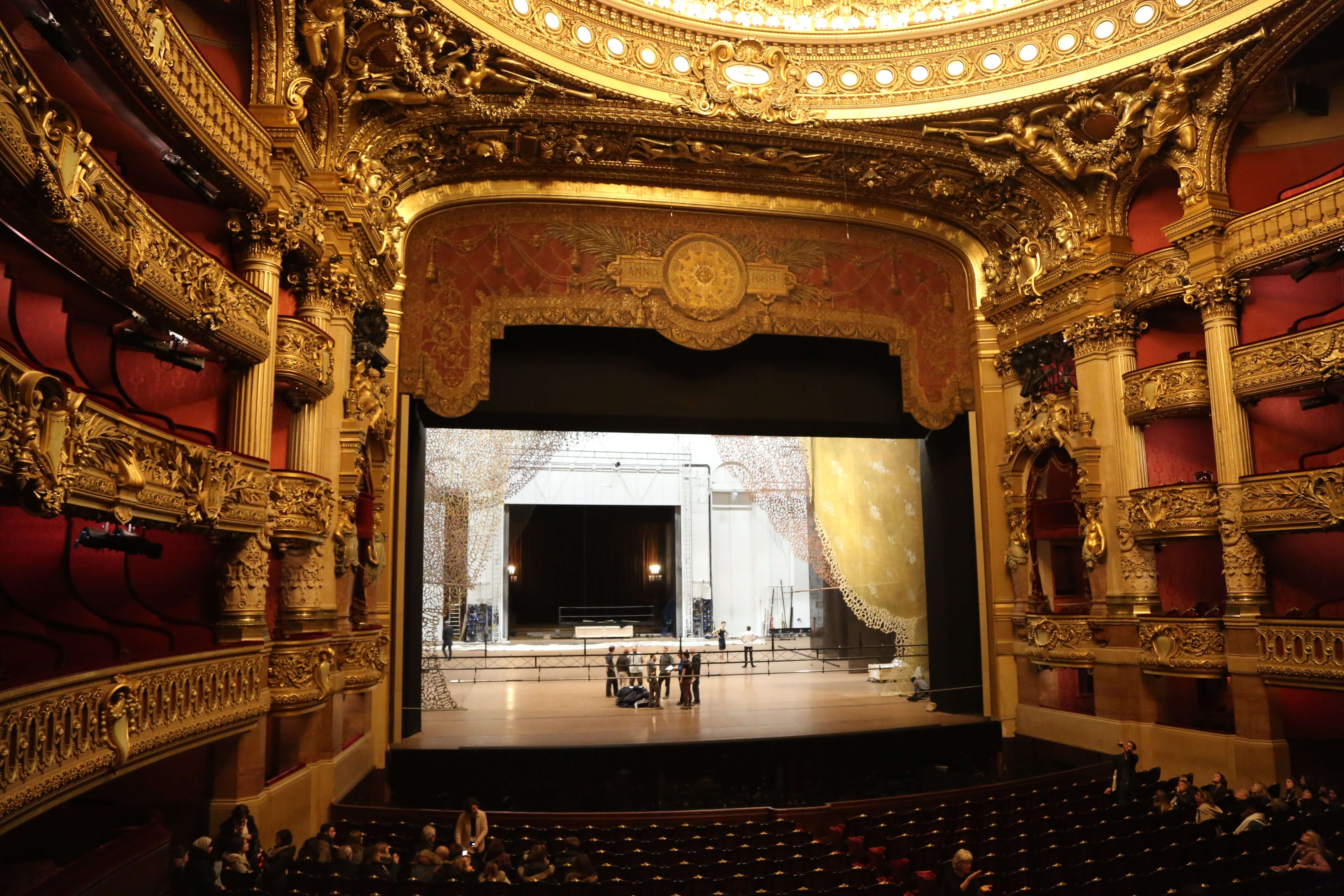
The Auditorium is the heart of the Opera Garnier, where the performances take place. The theater has a horseshoe shape, so-called for how the seats are arranged to see and be seen. The Auditorium is decorated with marble, stucco, velvet, and gilding.
The Grand Foyer
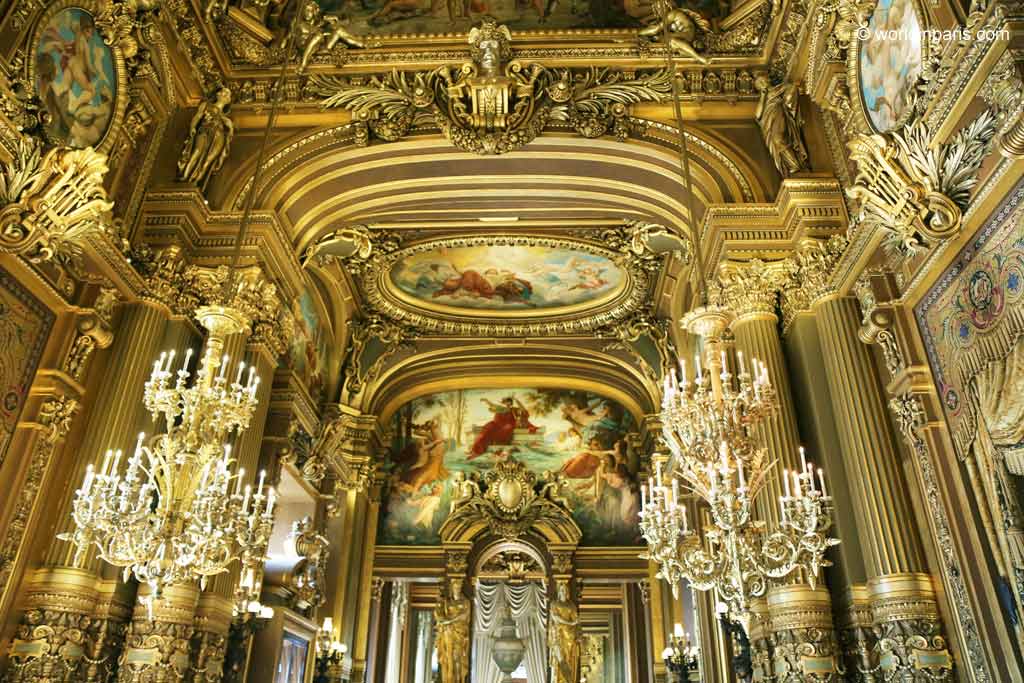
The Grand Foyer is a long room 18 meters high, 154 meters long, and 13 meters wide and has spectacular views of the Grand Staircase. This hall had an important role in Paris’ society as it was the perfect place to socialize while drinking champagne during the intermissions.
The Grand Foyer was inspired by the Hall of Mirrors inside the Palace of Versailles , with lots of natural light, gold, and mirrors. The lyre, God Apollo’s symbol, is the main decoration element, and you can find it everywhere in the room. Its ceiling represents various moments in the history of music.
15 Curious Palais Garnier Facts (Opera Garnier Facts)
The Palais Garnier history is very interesting. Amidst the countless anecdotes and legends surrounding its construction and first years, here are 15 facts about Palais Garnier – 15 fascinating things to know about the Garnier Opera House, Paris.
1. The Construction of the Opera Garnier was Inspired by a Tragic Event
The Opera Garnier history starts with a tragic event. In 1858, Emperor Napoleon III and his wife went to the Opera House that was at Rue Le Peletier. Just as the coach was parking, an explosion reached them. The imperial couple escaped unharmed, but eight of their men were killed, and several others were wounded.
After the failed assassination attempt on Napoleon III, the building of a new Opera House was declared in the public’s interest and for the safety of the head of state. The new Opera House was designed to have a private entrance and a special box where the emperor would sit.
2. A Special Request for the Avenue de l’Opéra
Haussmann’s renovation of Paris was a vast public works program commissioned by Emperor Napoleon III to bring air and light to the center of Paris. The Avenue de l’Opéra was not originally part of the plan but a personal request from the Emperor, who wanted a direct way to go to the Opera Garnier from his residence in the Tuileries Palace.
Charles Garnier, thrilled with the idea that such a beautiful avenue could enhance his monument, made an additional request: no trees were planted on this avenue so that nothing could disturb the view of the Opera House. That’s why, even today, the Avenue de l’Opéra has no trees.
3. The Palais Garnier Was a Costly Affair
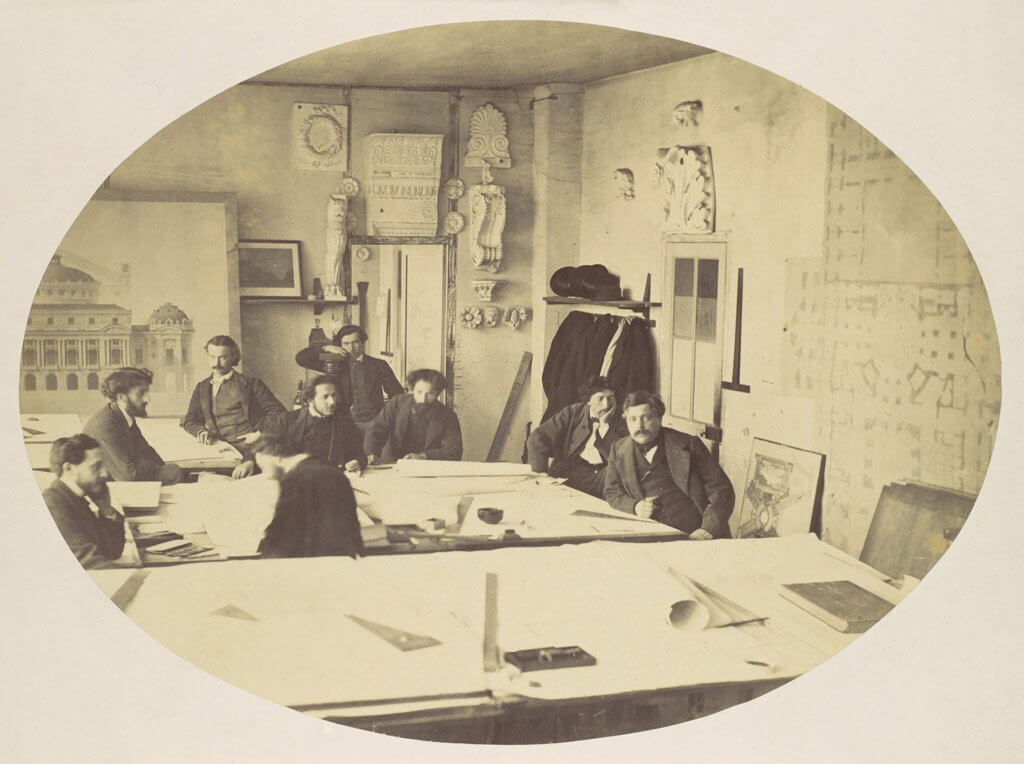
Though conceived as an opera house, Charles Garnier’s design has all the elements of a princely palace, hence the name ‘ Palais Garnier .’ The construction of the Opera Garnier in Paris involved the country’s best artisans available, carefully selected by Charles Garnier himself, and the finest materials. The budget was estimated at over 20 million gold francs, making the Palais Garnier Paris the most expensive building of its time!
4. The Opera Garnier Served as a Military Camp
This is one of the lesser-known Opera Garnier facts. The Palais Garnier’s foundation stone was laid in 1862, but the work lasted more than 10 years because of budget restrictions, the Franco-Prussian War, and the Paris Commune.
During the Prussian War, the unfinished building was converted into a camp where they stored food and straws.
The construction of the building resumed shortly after the Opera Pelletier was destroyed by fire. The building’s main façade was inaugurated in 1867, but the entire opera house wasn’t opened to the public until 1875.
5. La Danse de Carpeaux Scandal
Charles Garnier considered his building a true work of art, and during the works, the façade was totally masked by scaffolding so as not to betray his artists’ work. To arouse the curiosity of Parisians, Garnier decided to unveil the façade in stages.
In 1869, the carved groups of the facade were discovered. The sculpture representing a group of women joyfully whirling around the Dance Genius ( La Danse de Carpeaux by Jean-Baptiste Carpeaux ) caused a scandal. How could Garnier represent naked women (and so real) on a public monument?
On the night of 26 August 1869, a bottle of ink was thrown against the sculpture group.
Today, visitors can see a copy of this sculpture group; the original is displayed at the Orsay Museum.
6. The Palais Garnier is the First Signed Building
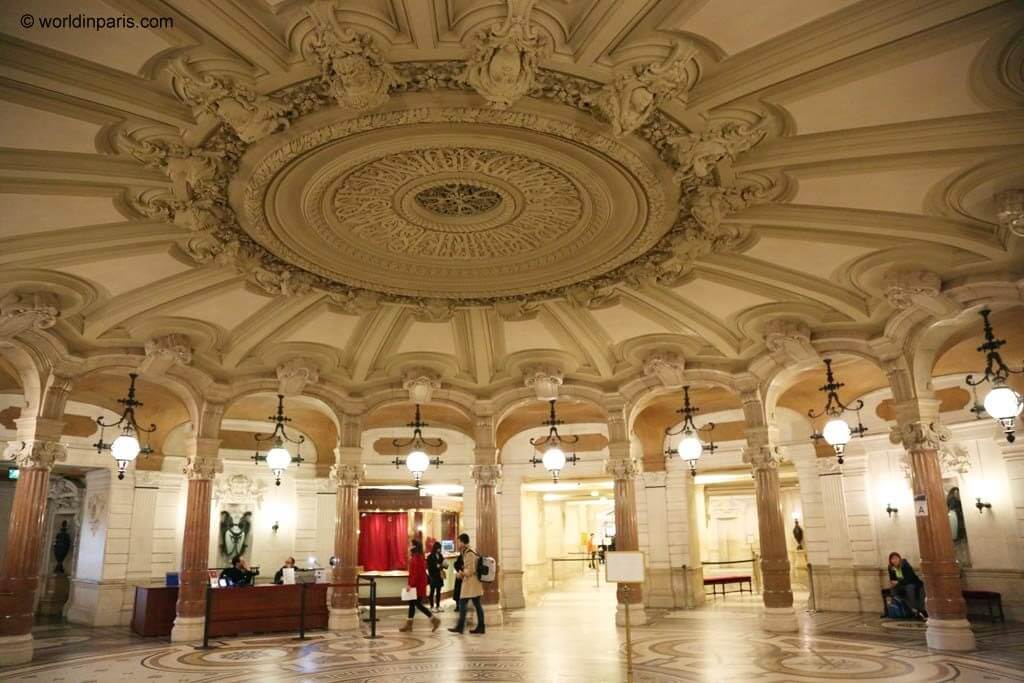
The guided tour starts at Rotonde des Abonnées, a circular vestibule that was used to accommodate spectators arriving by coach. This is a space with a rather dark atmosphere. Indeed, Charles Garnier wanted to give the spectator the impression of entering a cave before being dazzled by the Grand Escalier and other features in the theatre.
On the vestibule’s ceiling, you can see Charles Garnier’s signature, and this is the first time in history that an architect puts his signature on a building!
7. An Ungrateful Inauguration
The list of Palais Garnier facts continues with the day of its inauguration. On 5 January 1875, the Opera was officially inaugurated with a lavish performance attended by Marshal MacMahon (the new chief of the French government), the Lord Mayor of London, and King Alfonso XII of Spain.
Napoleon III, exiled in England since 1871, died in 1873 without seeing the achievement of his work.
The new government in France wanted to erase all traces of the Second Empire. Thus, Charles Garnier was not invited to the inauguration and had to pay for his own place to participate in the show. So sad!
8. The Palais Garnier Opera House is Designed to Watch the Spectators
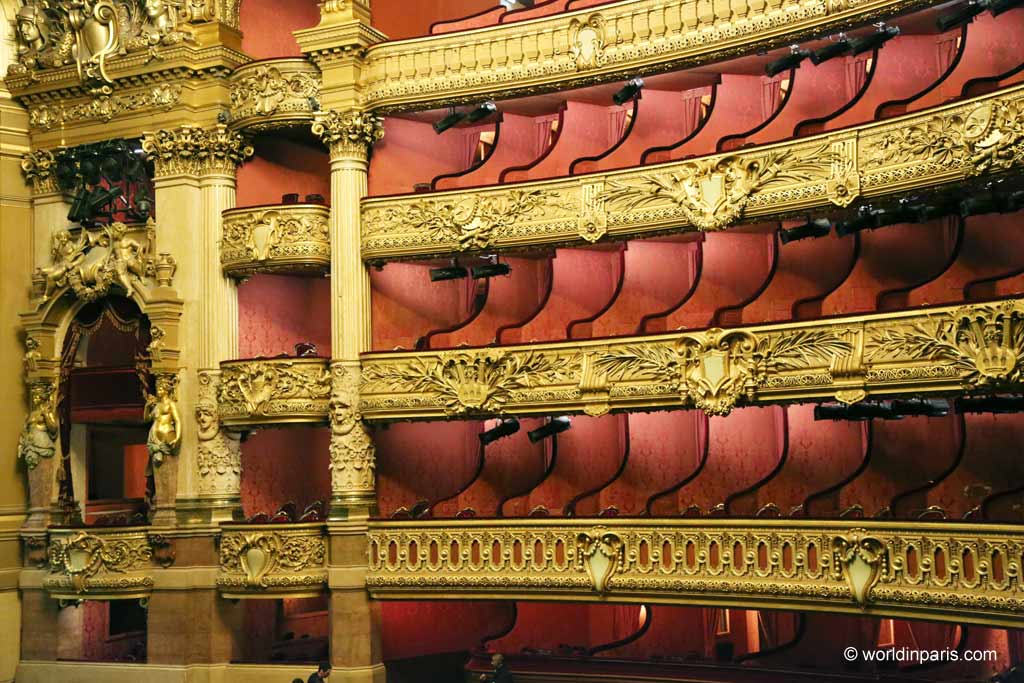
This is one of the most curious facts about Opera Garnier today, but it was nothing strange at the time when the Opera House was built. The Opera Garnier was not just about music but also a show of class, the perfect place to showcase its public.
The Grand Escalier was a triumphal entrance, with the perfect design to see and be seen. The Grand Staircase is in a great open hall, surrounded by balconies over four floors, perfect for observing and admiring the arrival of important guests. The steps are shallow, so when women would go upstairs, their ankles barely showed.
Once in the Auditorium , it is hard to miss the Emperor’s box, not placed in the middle of the hall for a perfect view and acoustic, but rather to the left, beside the front of the stage, visible from almost every seat on the Auditorium.
During the show, the lights remained lit in order to facilitate the popular activity of people-watching.
Finally, the Grand Foyer is the perfect place for socializing during the intermissions. Season ticket holders went to the opera 2-3 times a week, not because there were different performances or were opera fans, but to show off and socialize!
9. Being Surrounded by Banking Institutions Was Very Handy
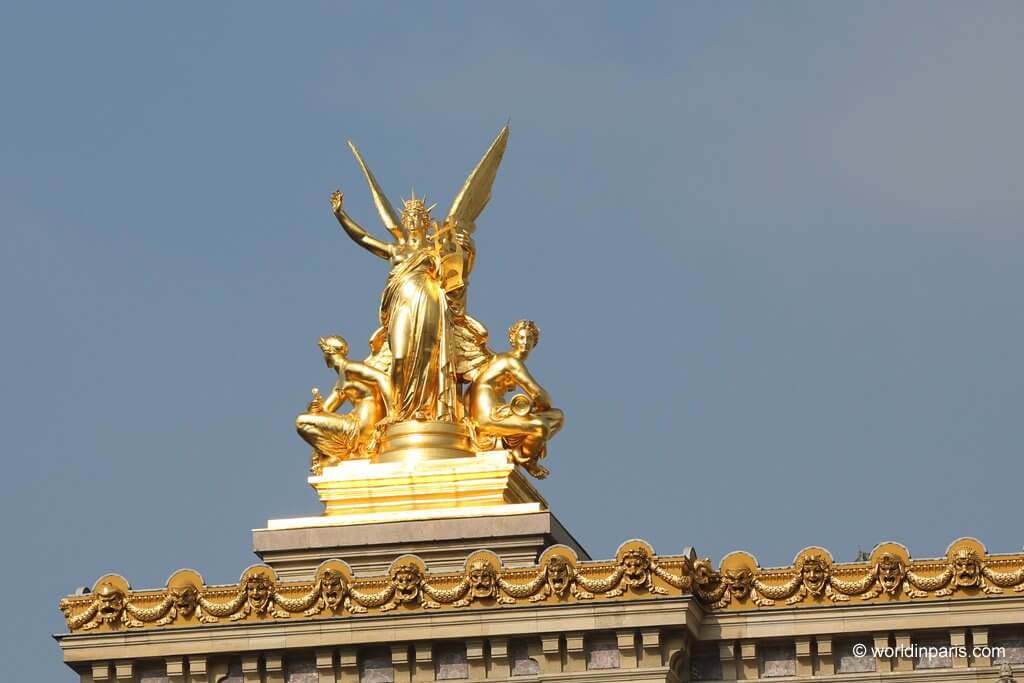
One of the most interesting Palais Garnier facts is related to its location. The Palais Garnier is located in Paris 9, a district that has always been home to the upper class and many banking institutions.
The perfect chance to be seen by the public, regular opera-goers would arrive with their best dresses and most precious jewels, usually stored in the banks’ coffers near the Garnier Opera House. As soon as the performance was finished, they would quickly return to the bank to safely store their precious jewels.
To be able to welcome their customers leaving the opera, the banks around Opera Garnier opened until late in the evening when there was an opera show.
10. The Opera Garnier Has a Mysterious Resident
The Phantom of the Opera novel, which was written by Gaston Leroux in 1910, is said to have been inspired by a true story event.
The novel tells the story of Erik , an eccentric, physically deformed genius who terrorizes the Opera Garnier in Paris. He builds his home in a fantastic palace in the middle of a subterranean lake, just beneath the Opera, and takes the love of his life, a beautiful soprano named Christine , under his wing.
Real stories and myths are blurred in Gaston Leroux’s novel, and until his very last day, he claimed that the Phantom of the Opera really existed.
For example, at the end of the 19th century, there was a mysterious individual who systematically demanded 20,000 francs every month from the board of directors and reserved every evening box no.5
Another tale is that a pianist known as Ernest was hurt and widowed in the fire that destroyed the Opera Pelletier in 1873. He went to the Opera Garnier for shelter and soon started haunting the corridors with an eerie cry.
Although nobody at Opera Garnier believes the Phantom of the Opera story, the staff won’t hesitate to blame the Phantom when something inexplicable happens …
11. Box Number 5 was (or still is?) the Phantom’s Private Box
One of the most famous facts about Palais Garnier is related to the Auditorium’s box number 5. Box number 5 was the Phantom’s box, and he demanded that every night the box was his alone, not shared with other spectators.
Today, box number 5 is sold out for every performance, and it seems to be a wonderful place to see the opera without being seen.
12. There Really is an Underground Lake
The Opera’s underground lake where Erik built his palace really exists, but it is not as atmospheric as Gaston Leroux described in his novel The Phantom of the Opera.
One of the reasons why the project took so long to be completed was the presence of a considerable amount of water in the soil. When workers attempted to lay the building’s concrete foundations, a seemingly endless flow of water bubbled up from the swampy, newly cleared ground, and no one could do anything to stem it.
After months of trying to pump out the excess water, Charles Garnier decided to incorporate a cistern into his design to redistribute the water and relieve the water pressure on the basement walls. The cistern, one of the hidden gems of underground Paris , still exists today, and it is used as a reservoir for firefighters in Paris. The lake is also the home of a family of carp.
When we did the guided tour, our guide told us that the tank’s weight also stabilizes the building. Some years ago, the Opera decided to empty the tank to clean it. During the process, the workers received a call from their boss who was in the Auditorium: they had to stop immediately emptying the tank because the building was moving!
Explore Opera Garnier’s Underground Lake with Google Curio-Cité
13. The Legendary Episode of the Fall of the Chandelier Really Happened
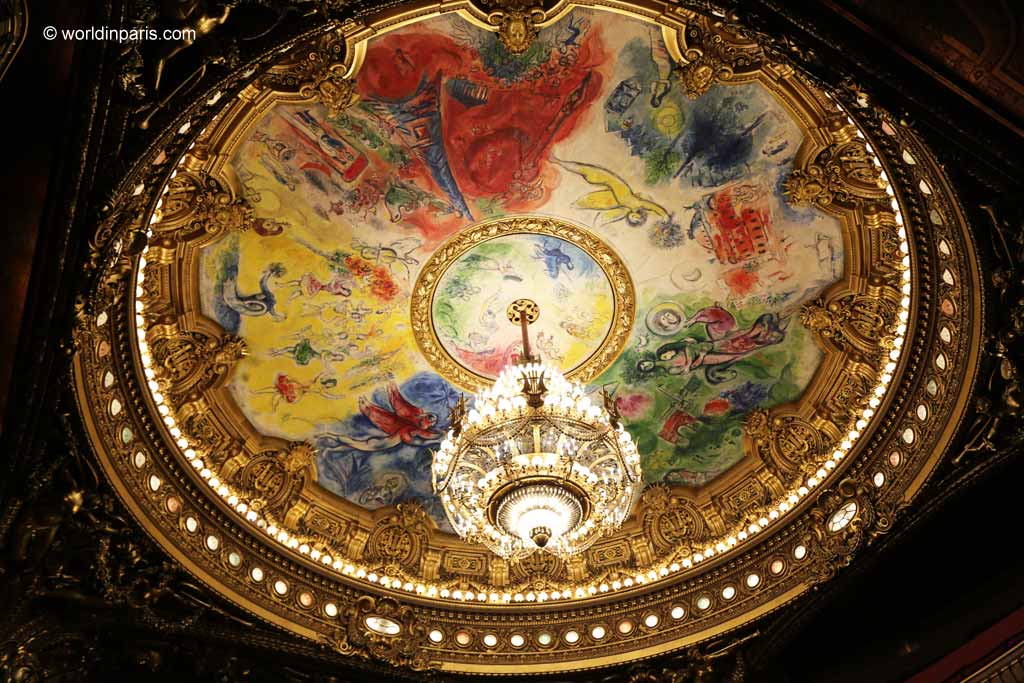
This is one of the most famous chapters of the history of Palais Garnier that Gaston Leroux also used in his novel. During one of The Phantom of the Opera’s most thrilling moments, the Phantom kills an audience member by causing the Grand Chandelier to fall during a performance. The confusing situation allows him to kidnap Christine to his underground palace.
The fall of the chandelier actually mirrors a real accident at the Opera Garnier in 1896, when one of the counterweights of the 7-tonne chandelier fell into the audience and killed one person.
When you visit Opera Garnier, don’t miss looking up in the Auditorium to admire the famous chandelier and the paintings on the ceiling , one of Marc Chagall’s masterworks!
14. The Opera Stage Can Fit the Arc de Triomphe!
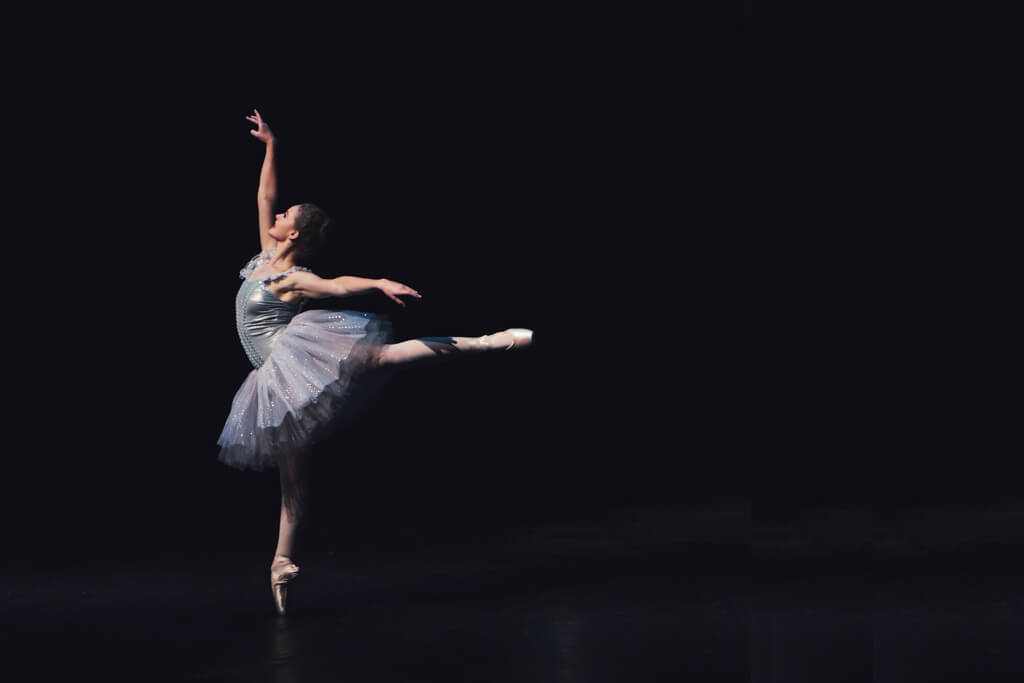
One of the fun Opera Garnier facts is the size of the building. The Palais Garnier’s vast stage is the largest in Europe, measuring 52 meters wide by 62 meters high, vast enough to fit the Arc de Triomphe!
Following a concept that already existed in other opera houses in Italy, Charles Garnier added a slight incline to the stage, allowing visitors to have a better view. With such incredible measures, the 5% incline means that the stage is one meter higher at the back than at the front. The ballet artists at the Opéra National de Paris are used to this incline, while it’s harder for other ballet dancers who perform here occasionally.
15. There Really Are Buried Phonographic Recordings
We finish this list of facts about Opera Garnier with the most incredible one. In The Phantom of the Opera novel, Gaston Leroux mentions the burying of phonographic recordings in the Opera Garnier’s cellars. He narrates that while the workmen in charge were preparing the cellar to store the recordings, they found a corpse identified as the Phantom’s.
Actually, this is a historical fact: in 1907, the Gramophone Company sealed 48 gramophone records of the greatest singers of the time in two containers and locked them in the opera house’s cellars, to be opened 100 years later. In 2007, the containers were opened, and the records were digitized by EMI Classics under the name of Les Urnes de l’Opéra . There is no record of finding a corpse, though.
And there you have it, the Palais Garnier history and most curious Opera Garnier facts & myths to make your visit more interesting!
Click here to read more Paris Attractions
Back to Homepage
Pin it now & read it later

Disclaimer: This post includes affiliate links, meaning I get a small commission if you make a purchase through my links. It costs you nothing more (in fact, if anything, you’ll get a nice discount) but helps me to go on creating incredible Paris content for you. I trust all products promoted here and would never recommend a product that isn’t of value. World in Paris is a participant in the Amazon Services LLC Associates Program. As an Amazon Associate, I earn from qualifying purchases at no expense to you.

About WORLD IN PARIS
Quirky parisian explorer with a preference for lesser-known sights, i am continuously looking for new ideas and tips to bring you the best of the city of light read more about me ., i am elisa, the travel blogger behind world in paris. quirky explorer with a preference for the local side of my city and its lesser-known sights, i am continuously looking for new ideas to enjoy the best of paris & around . do you want to go beyond the louvre museum or the eiffel tower keep clicking for first-hand information & my best tips learn more.
Guide to the Palais Garnier: How to See the Paris Opera House
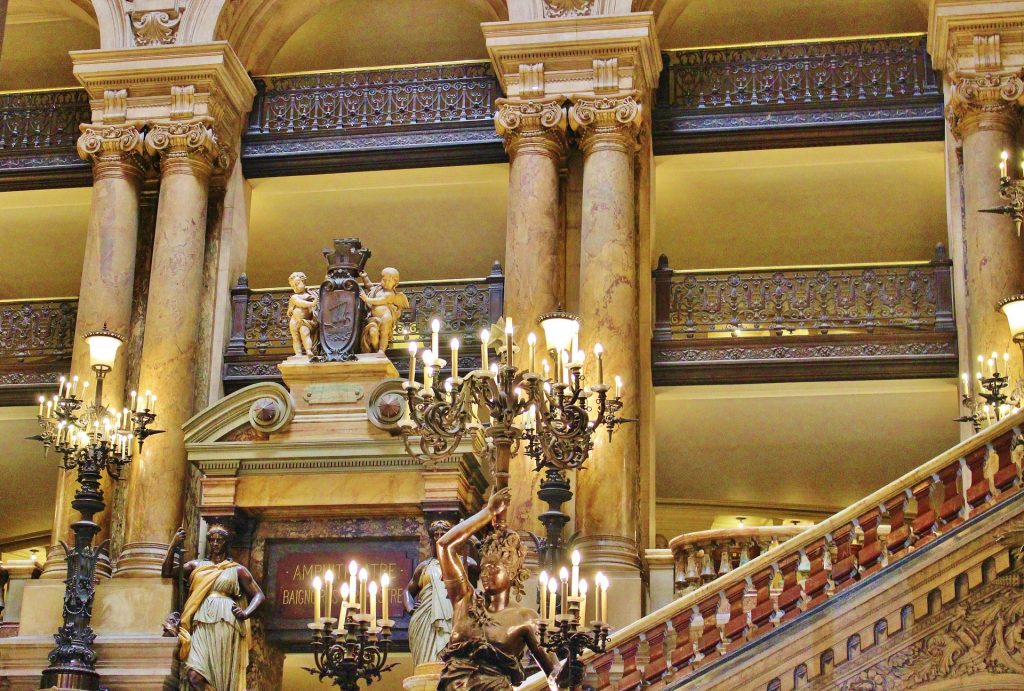
The Palais Garnier, home to the Opéra Garnier, is a place of art, beauty, and even intrigue.
You can appreciate its art and beauty in the live shows and lovely architecture that brightens the 9th arrondissement of Paris. And there’s some intrigue thanks to its connection to the famous Phantom of the Opera, which still draws adoring fans to the opera house today.
Want to see this photo-worthy landmark? Here’s everything you need to know before visiting the Palais Garnier in Paris.
Where to find the Opéra Garnier
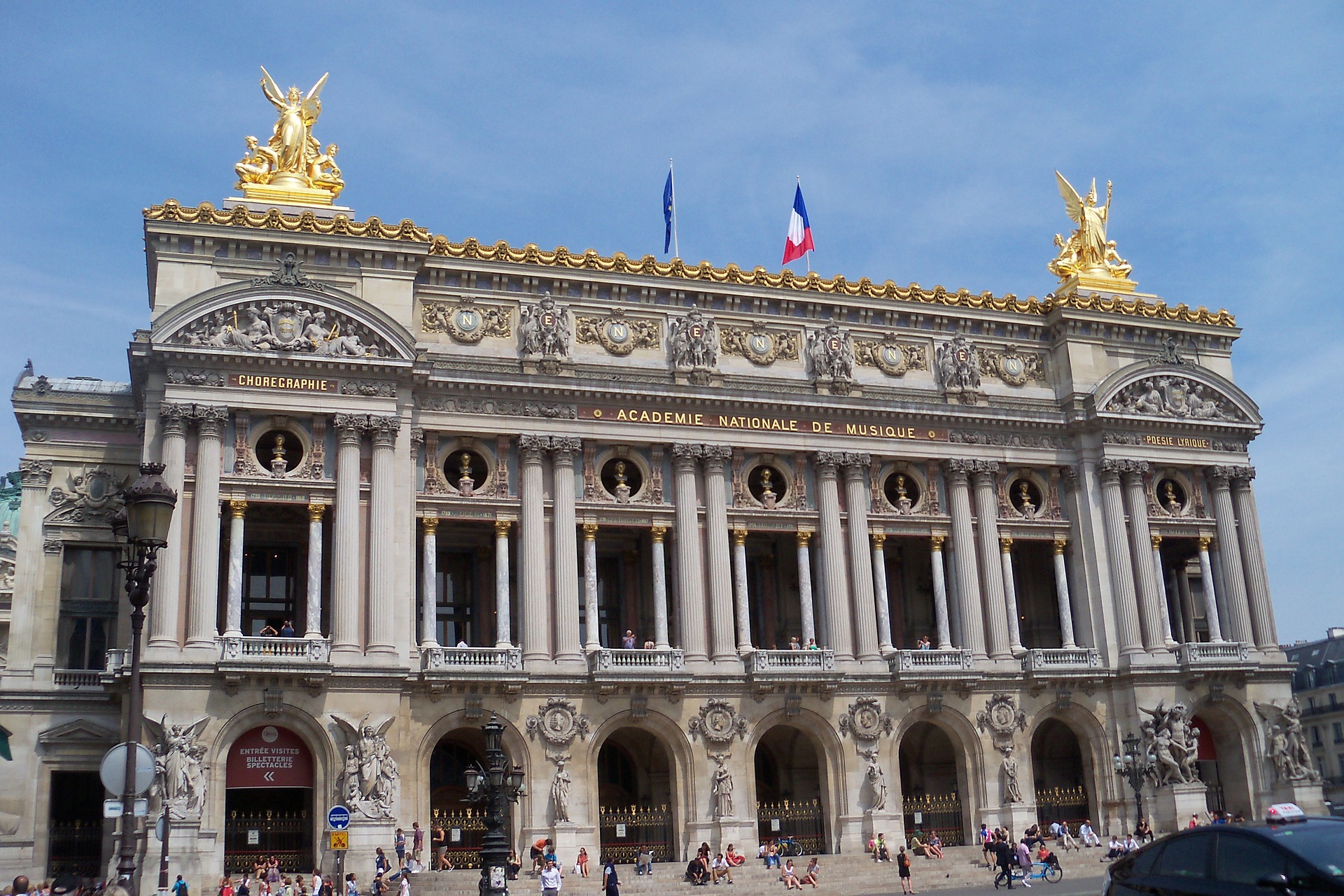
The Opéra Garnier is in the busy 9th arrondissement in Paris, right at the corner of Scribe and Auber streets. Appropriately, it holds court at the center of the Place de l’Opéra.
It’s accessible from the metro stop Opéra on lines 3, 7 and 8, or the station Auber on the RER A.
Local tip: If you like shopping, Galeries Lafayette Paris Haussmann is just a short walk away.
Some Paris Opera House History
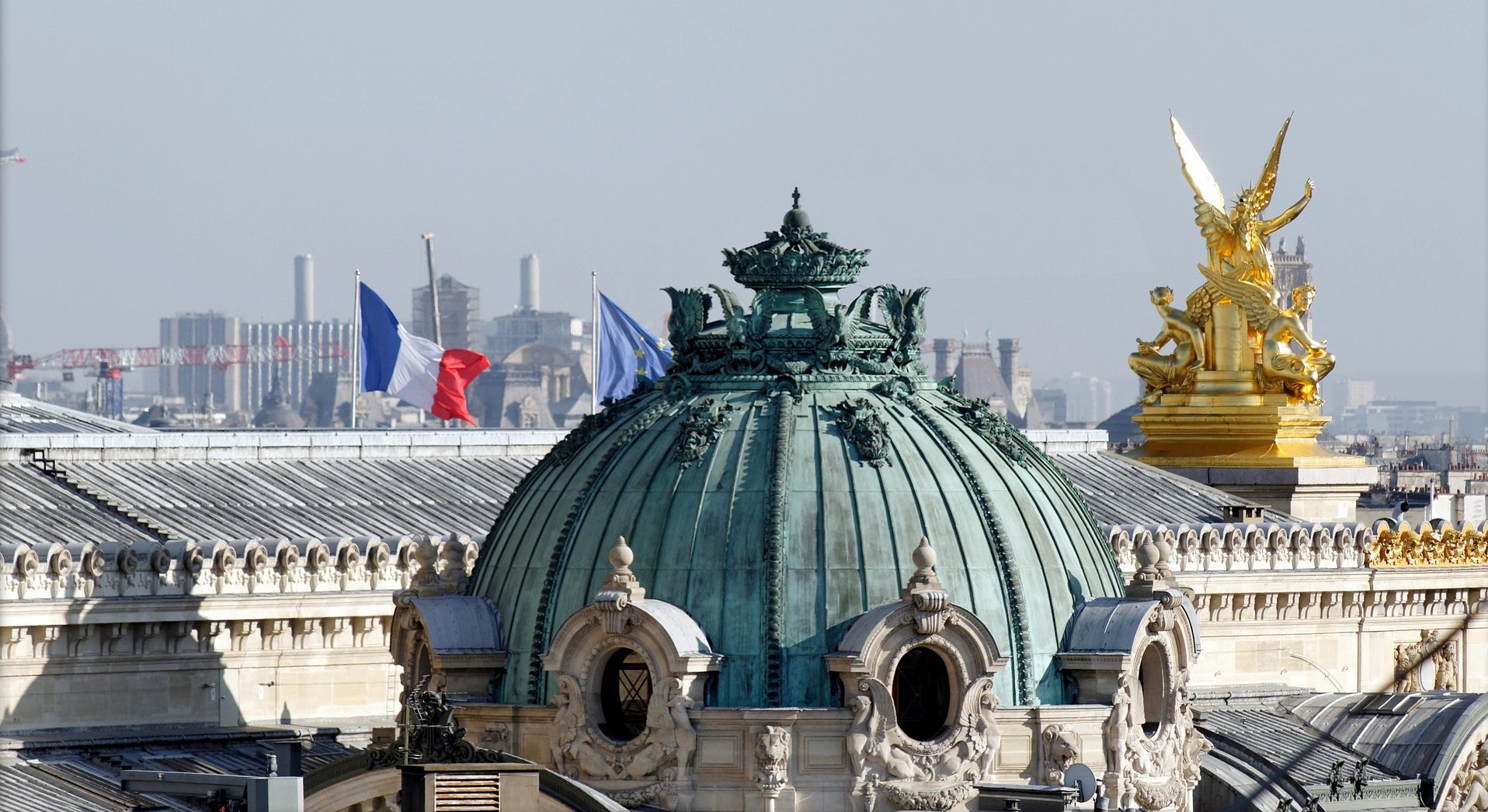
The Opéra dates back to the mid-19th century when French architect Charles Garnier designed the building in the Second Empire Style, a term used to describe architecture heavily influenced by the Italian Renaissance. It officially opened on Jan. 5, 1875. And if you were curious, the very first opera performed here was “La Juive,” a five-act libretto featuring forbidden love, vengeance, and plenty of dramatic arias.
And what about that connection to the Phantom of the Opera connection ? The famous play is based on none other than the Opéra Garnier in Paris. The famous tale of a haunting love triangle was a hit on Broadway and in England. While the story is fictional, the setting was inspired by the beautiful maze-like interior of the Paris Opéra. You can take a Phantom-themed tour of the opera house to see for yourself.
The Mysterious Underground Lake of the Paris Opera House
Yes, there’s an underground “lake” at the Opéra Garnier. Unfortunately, no one (guests and employees alike) have access to it.
Rumor has it, French firefighters use it to practice mock rescues here. What we do know is that the eerie subterranean reservoir inspired the French writer behind the “Phantom of the Opéra” novel, who decided to set the phantom’s lair there.
In reality, the “lake” is actually a cistern used to manage the groundwater below the building’s foundations.
What to Expect Inside the Opéra Garnier
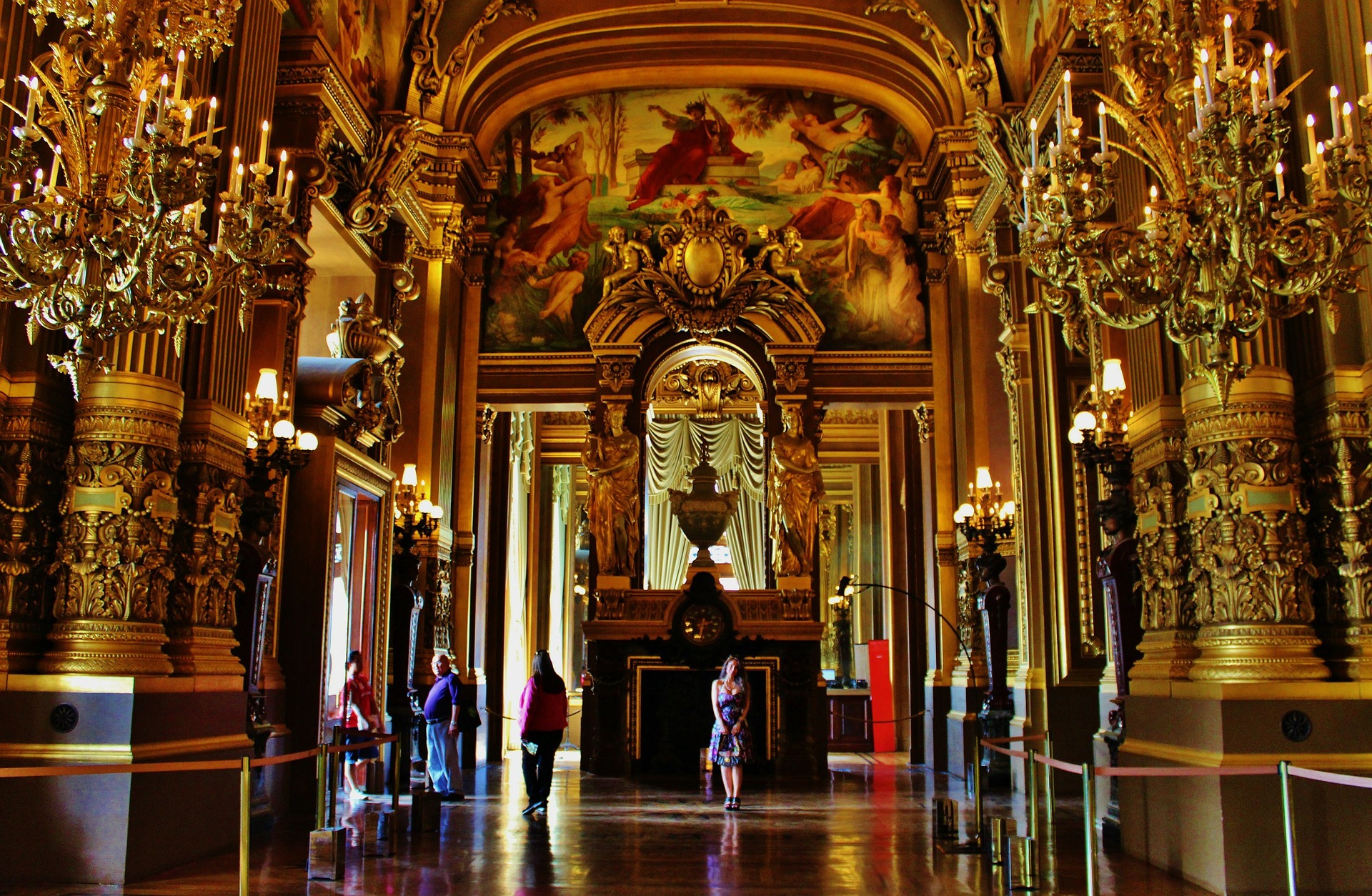
The opera house is as extravagant and imposing as the different shows you can enjoy there. It seats over 2,000 in its massive gilded auditorium. But it’s not just a theatre. The architecture and art is an experience all on its own.
Here’s what to see before you take a seat.
Rotunde des Abbonées
When you enter the Palais Garnier, you’ll find yourself at the “Rotonde des abonnés,” a glamorous rotunda with a decorative ceiling. This is where you can buy tickets, but it’s also a great place to snap photos. Look for the sculpture of the Greek goddess Pythia right underneath the grand staircase.
The Auditorium
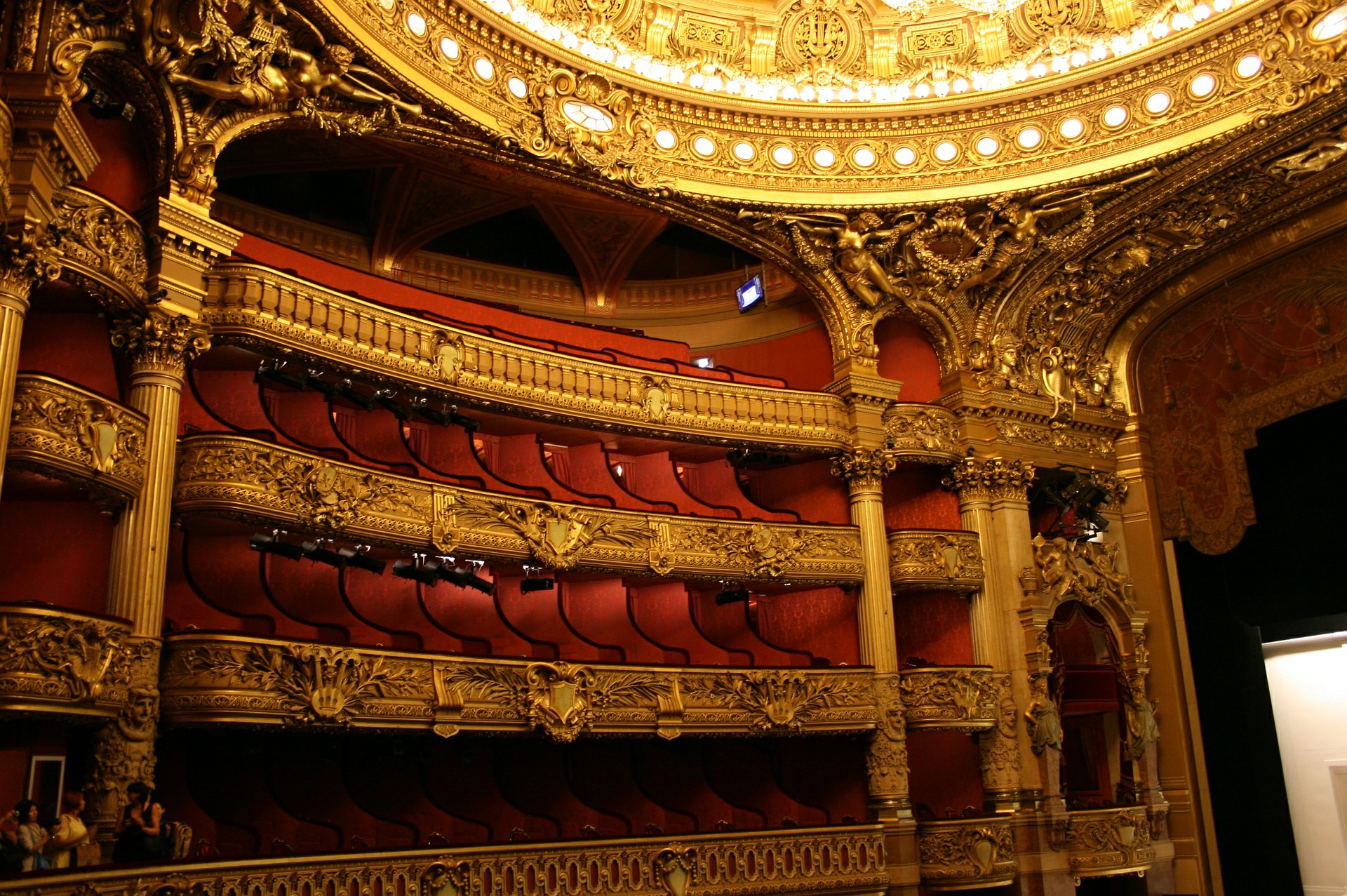
It’s the classic opera house: plush red seats and gold trimming. The auditorium is breathtaking when you see it for the first time, with a structure made of everything from stucco to velvet.
Of course, there are two stars of the theater — and I’m talking about stars on the stage. One is the 8-ton bronze and crystal chandelier, complete with 340 lights. The other is the house curtain. The original, painted according to Charles Garnier’s instructions, was replaced with a replica, first in the 1950s and then in the 1990s.
Salon du Glacier
If you are a fan of awe-inspiring mosaics, don’t skip this section of the Palais Garnier.
The long gallery has a colorful painted ceiling with themes from music history. But the main thing to look out for is the replica of Charles Garnier’s bust near a window looking toward the Louvre .
Grand Escalier
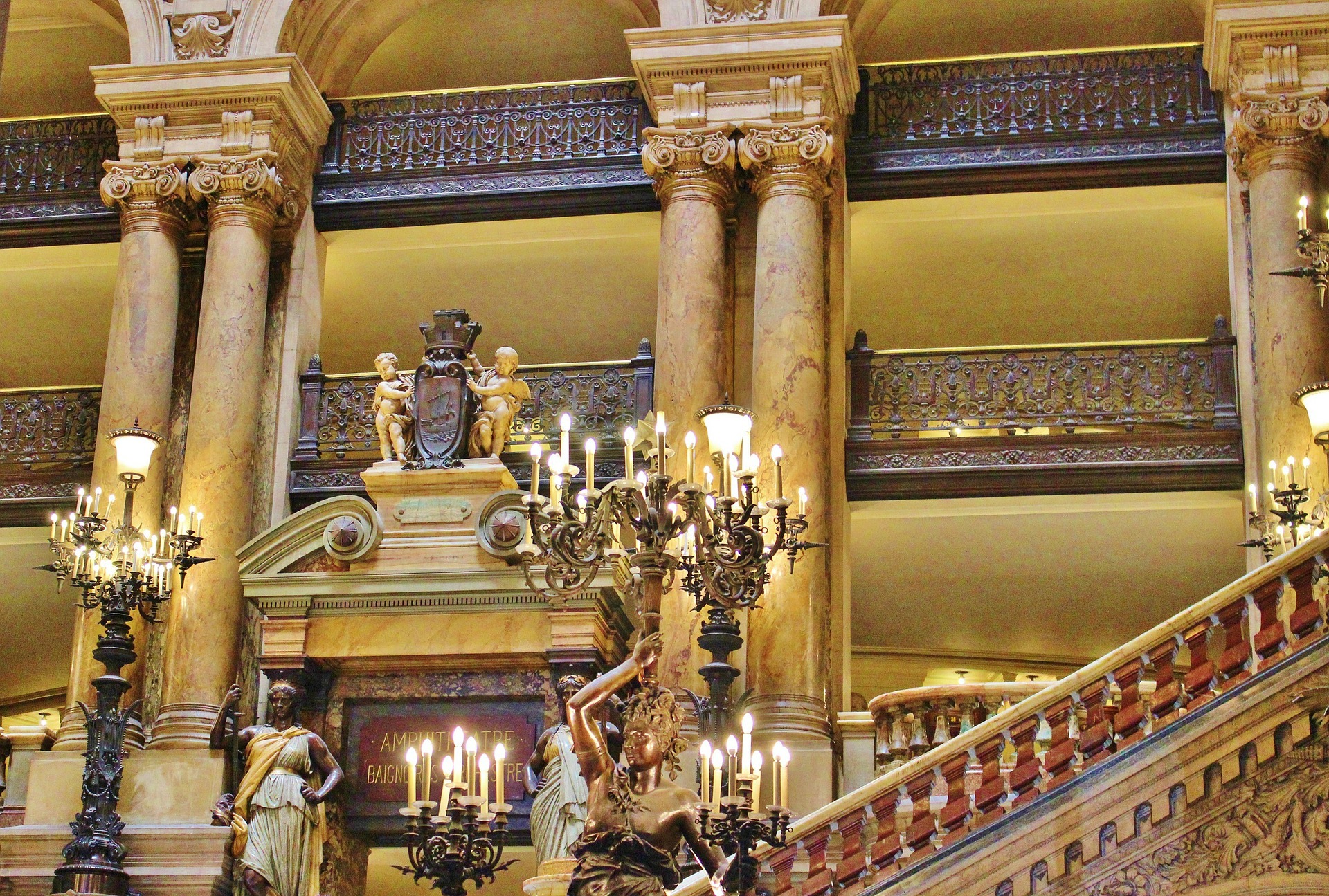
This means “grand stairway,” and it certainly is a fitting name. The marble double staircase, with various chandeliers lighting the way up each step, leads to different floors of the opera house. And it’s vault is nearly 100 feet high.
This isn’t just a library — it’s an impressive museum in it’s own right with 300 years’ worth of history. Along with books, you’ll find paintings, drawings and set models.
The Palais Garnier library actually falls under the French National Library system and is open to the public 10 a.m.-5 p.m. daily. While the reading room is reserved for researchers only, the museum section of the library is part of the opera house tour.
Visiting the Opéra Garnier (AKA Palais Garnier)
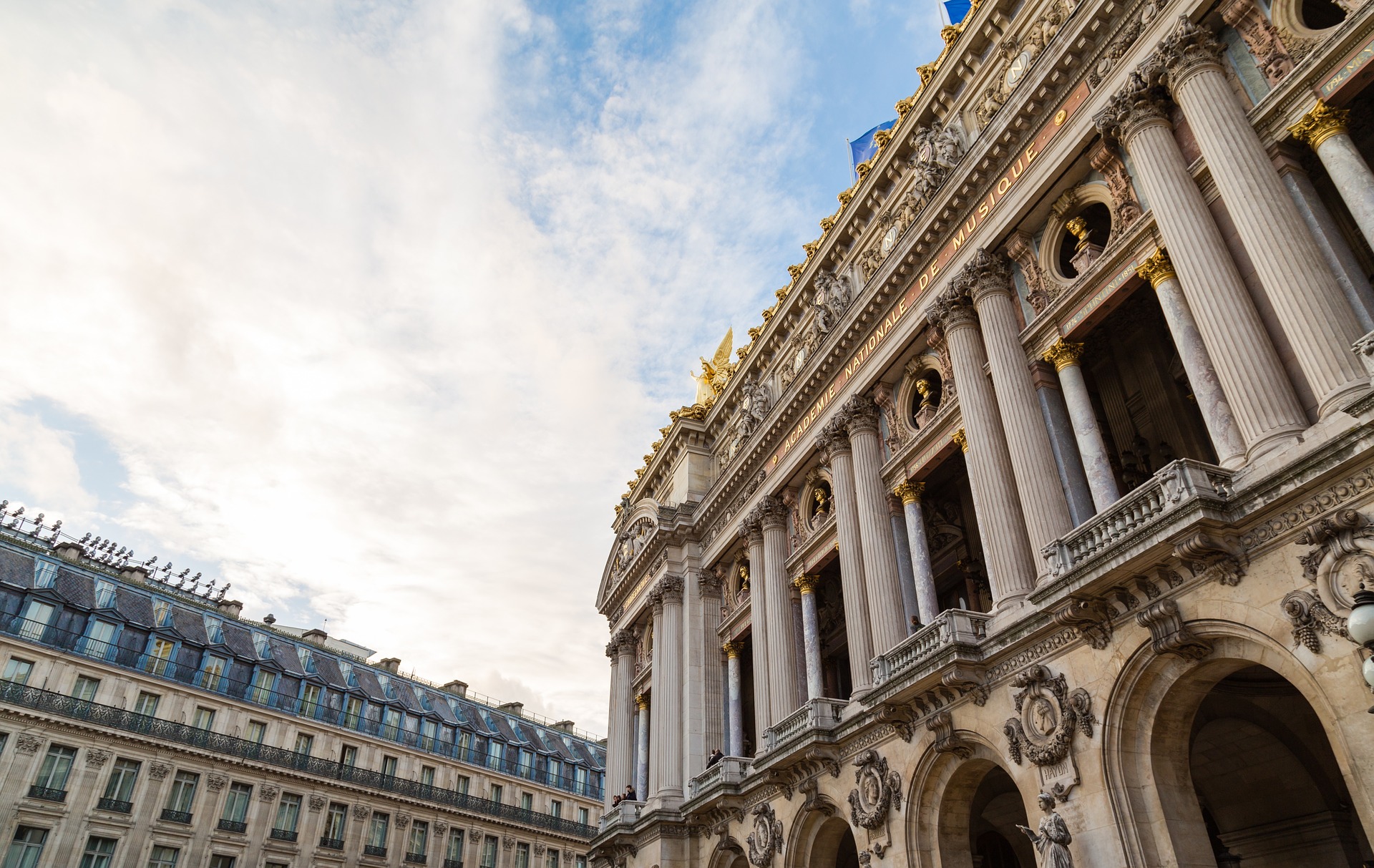
This famous opera house is too big for one name. You’ll find it referred to as the Palais Garnier or the Opéra Garnier. The name Garnier is a nod to the architect behind the building, Charles Garnier. But the building has had a few names over the years, including “National Academy of Music,” which you can see emblazoned on the front in gold letters as “Académie Nationale de Musique.”
Before going inside, take a moment to admire the exterior. It’s heavily decorated all along the many-columned facade. Besides the sculptures embedded into the front of the palace, you’ll notice gold winged statues on either side of the roof and a central sculptural group at the very top. That’s Apollo, Greek god of music and dance (and the sun and other things), holding a golden lyre with the figures of Poetry and Music by his side.
If you like classical sculptures referencing mythology and ornate, gilded architecture, you definitely should go inside the Palais Garnier.
Fortunately, there’s no need to watch a show to take in all of the Palais Garnier’s glamour. You can opt for a guided or self-guided tour of the Opéra . Group tours happen daily starting at 10 a.m., with the last tour at 5 p.m. Individual tours are offered in the afternoon in both English and French.
On a budget? You can walk inside for free, just to get a glimpse of the lobby. But to get any further and see more of this palace, you’ll need to sign up for a tour or ticket.
But a virtual tour is always free. The Opéra Garnier teamed up with Google Cultural Institute to provide an in-depth look at all the building has to offer, so opera-lovers can take the tour from anywhere in the world.
Seeing a Show
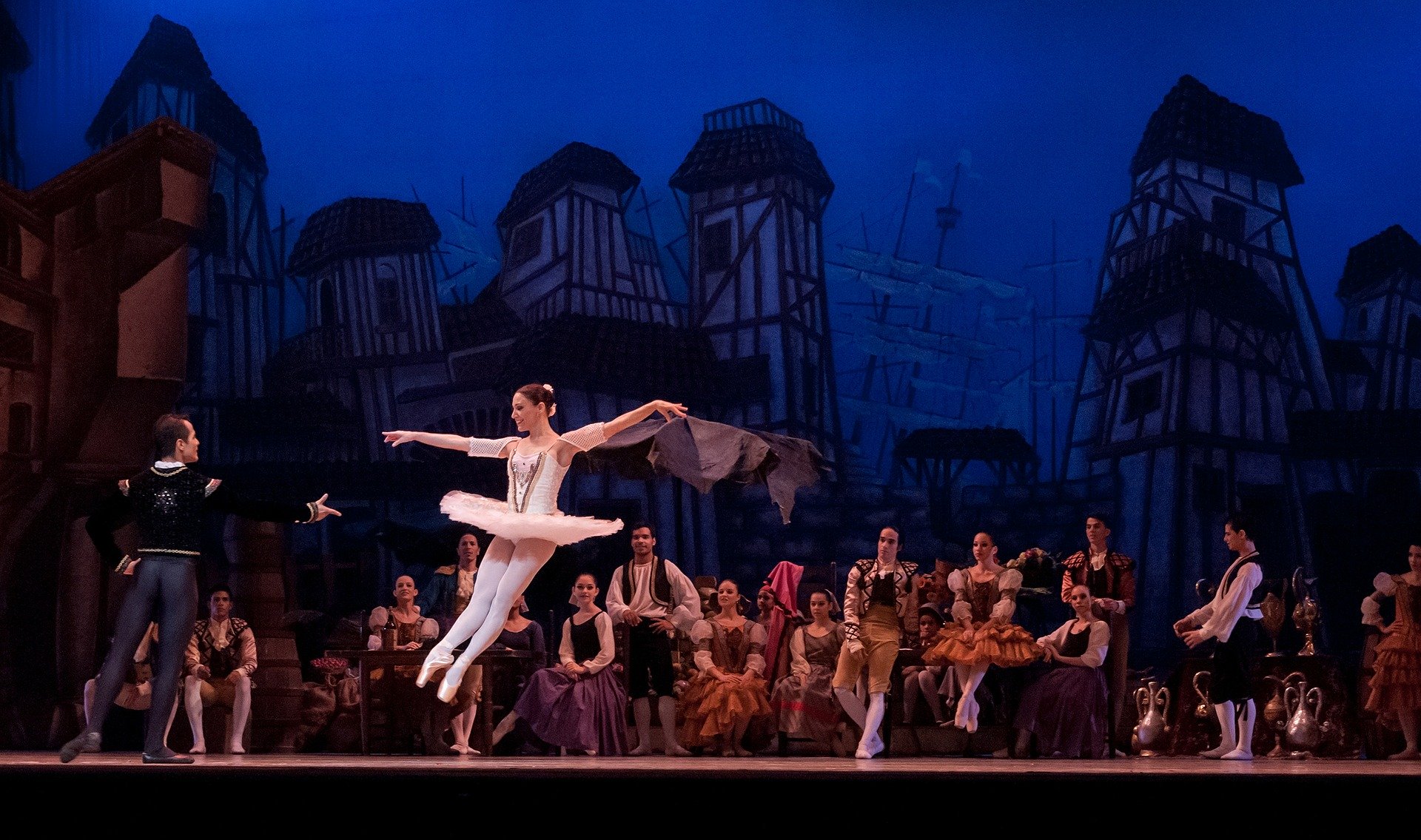
You can catch a variety of shows at this Paris opera house — not just operas.
There are certainly plenty of classic operas, often sung in Italian, but there are also ballets and concerts highlighting work from composers like Mozart, Bach, and Vivaldi.
Before you book, take a look to see if you can get discounted tickets. The Opéra Garnier offers special pricing for those under 28 and gives another discount for those under 40.
Answers to Your Questions About the Palais Garnier
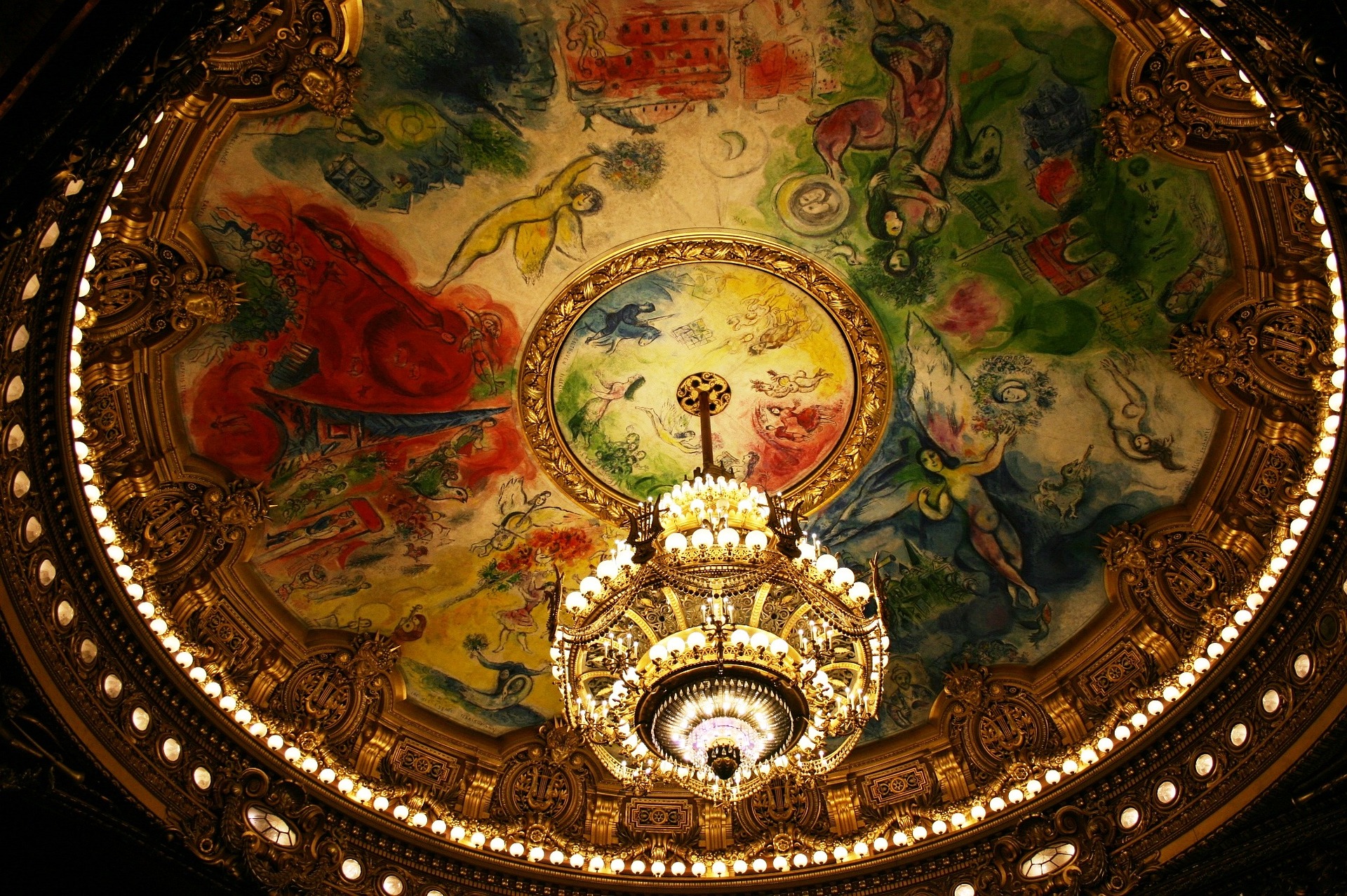
Is the Palais Garnier open to the public?
Yes, it is. You can tour it for a fee or stop into the lobby where you would buy tickets, just to take a peek inside. The opera house is open from 10 a.m. to 5 p.m.
What can you do nearby?
Hardly a block away from the Palais Garnier is the Galeries Lafayette, a shopping experience with all of the luxury brands you can think of. In fact, if you go to the rooftop of Galeries Lafayette, you’ll get a direct view of the opera house and the Eiffel Tower .
If you have a sweet tooth, you have to go to Fauchon, a high-end pastry shop a short walk away near the Madeleine metro stop on line 12, 14, and 8. They’re known for their gold-encrusted hazelnut tart. You must give it a try.
If you’d like a nice bar, check out Harry’s New York Bar, merely a five-minute walk away. It’s legendary — the bloody mary was invented at this famous cocktail joint.
Why is the Palais Garnier famous?
The Palais Garnier is one of many monuments dedicated to Paris’ rich art history. It’s Second Empire architecture captivates tourists and locals alike.
But one of the main draws — apart from the impressive concerts — are its ties to Andrew Lloyd Webber’s smash Broadway hit, “The Phantom of the Opera.”
Art, Architecture, and History at the Opéra Garnier
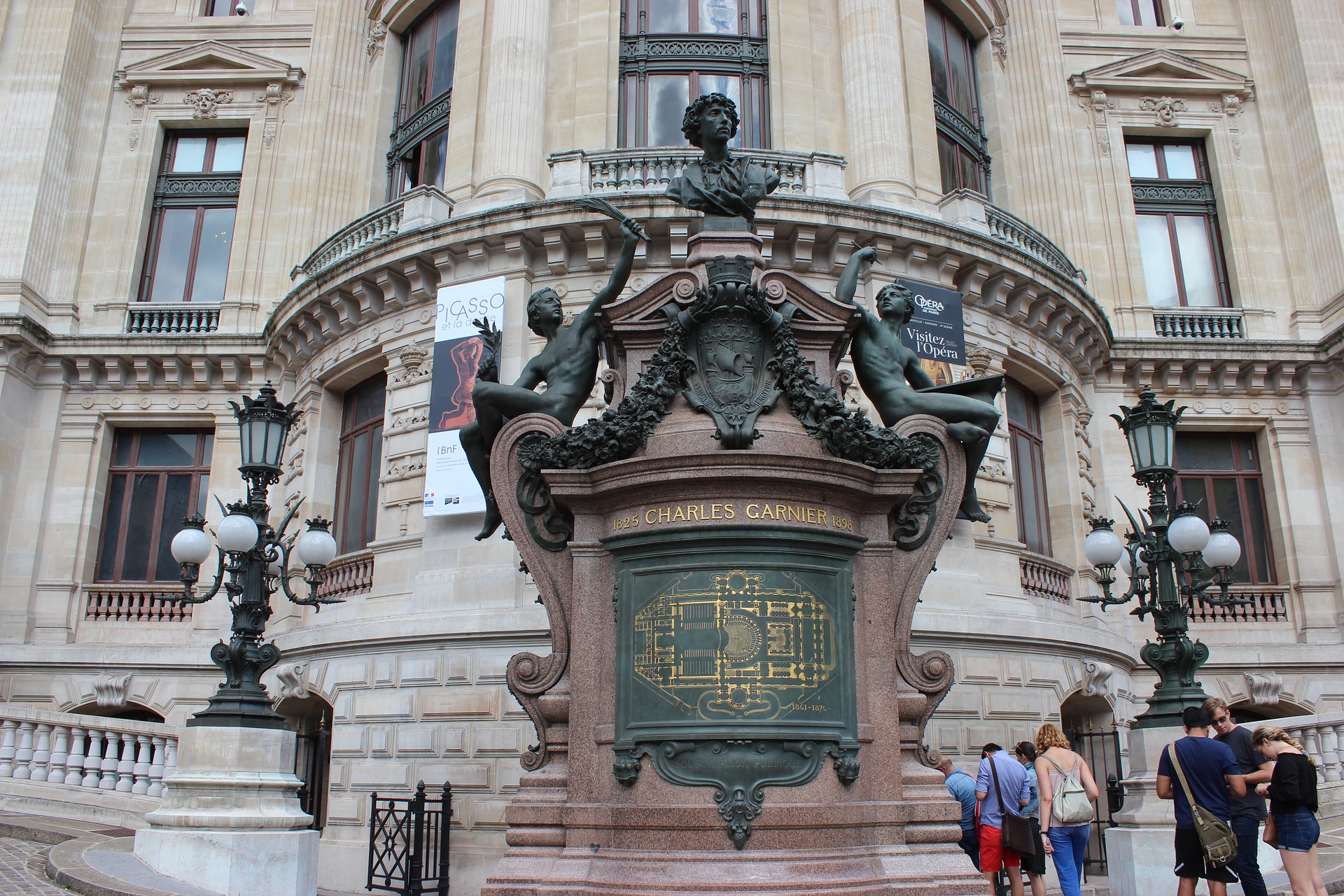
Like many Paris monuments, this place packs a lot into one location. It’s an opera house, museum, library, and architectural marvel. With nearly 480,000 visitors each year, the Palais Garnier is one of Paris’ most visited monuments. It has been listed as a historical monument since 1923.
Whether you want to enjoy the architecture from the outside alone, take a tour indoors, or splurge on a show, this is an easy add to your Paris itinerary, thanks to its central location not far from the Louvre.
Looking for another landmark that pulls double (or triple) duty? Check out our guide to the Panthéon , a monument, crypt, and art gallery all in one.
Paris Attraction Tickets
Palais garnier.
Palais Garnier, also known as the Paris Opera, is a magnificent architectural masterpiece located in the 9th arrondissement of Paris. This grand building was built between 1861 and 1875, and it is one of the most famous examples of French baroque architecture. The Palais Garnier is famous for its stunning interior, with its gilded moldings, grand marble staircases, and stunning chandeliers. The opera house also boasts an impressive stage and acoustics, making it one of the best performance venues in the world.
Visitors to the Palais Garnier can take a guided tour of the building, which will take them through its various halls and rooms, including the Grand Foyer, the Grand Staircase, and the Auditorium. During the tour, visitors will also be able to admire the beautiful frescoes and paintings that adorn the walls and ceilings. In addition to its tours, the Palais Garnier also hosts a variety of cultural events and performances, including opera, ballet, and classical music concerts.
If you're a fan of architecture, art, or music, the Palais Garnier is a must-visit destination in Paris. With its stunning architecture and rich cultural heritage, it's easy to see why this building has become one of the most famous landmarks in the city.
- Opéra Garnier → 8 meters
- FlyView Paris → 217 meters
- Théâtre Mogador → 368 meters
- THEATRE MICHEL → 476 meters
- Place Vendome → 530 meters
- Theatre des Varietes → 766 meters
- Grevin Wax Museum Paris → 768 meters
- Espace Lafayette Drouot → 788 meters
- Theatre Saint Georges → 811 meters
- Théâtre des Nouveautés → 964 meters
- Theatre Trevise → 1 kilometer

Opéra Garnier: a Parisian tour combining art, history and culture!

- Post published: 21 November 2023
Close to the Louvre Museum, the Palais Garnier is ideally located in Paris. With an entrance ticket, you can visit this magnificent Italian-style opera house. Find out all you need to know before you come.
Palais Garnier: mirroring the artistic soul of Paris
Designed by Charles Garnier and inaugurated in 1875 , the Opéra Garnier, also known as the Palais Garnier, is housed in a magnificent building. It is a historic monument, a grandiose work of art and a symbol of France’s cultural prestige.
One of Paris’s most recognizable landmarks, the opera house is on the Place de l’Opéra in the 9th arrondissement.
At first glance, you’re captivated by the building’s sumptuous architecture. Its facade, adorned with sculptures, columns, and friezes, gives a glimpse of the elegance that awaits inside. The Beaux-Arts style, emblematic of the Second Empire, blends classical grandeur with an almost baroque whimsy that evokes the glamour of the theater.
Inside, the Opéra Garnier continues to dazzle. Right from the start, the Grand Escalier greets you. This architectural masterpiece, with its marble steps, gilded balustrades, and bronze statues, makes you feel as if you’ve stepped into a fairy tale.

The tour then takes you through the opera’s various rooms. Among them, the auditorium , with its incredible ceiling painted by Marc Chagall and its Baccarat crystal chandelier, is a must see.
The Foyer , which mimics the appearance of castle galleries, with its giant mirrors, gilded mosaics, and ceiling paintings, is another room that’s sure to fill you with wonder.

But the Opéra Garnier is more than just an architectural marvel. It’s also a showplace of artistic creation par excellence. The Paris Opera Ballet, one of the world’s most renowned dance companies, makes its home here.
To visit the Opéra Garnier is to enter a world of history, art and culture.
Highlights of a visit to the Opéra Garnier
- Grandiose, detailed architecture
- The chance to attend exceptional shows
- The site’s rich history
- The Grand Staircase, an architectural gem

Disadvantages of a visit to the Opéra Garnier
- The long wait at the ticket office for those who didn’t buy the ticket in advance
- The visit is not possible when events are taking place in the palace (check before you go!)
What can you see at the Palais Garnier?
A visit to the Opéra Garnier is a feast for the eyes and the mind.
The journey begins as soon as you approach this impressive building. As the photos in my article testify, you’re transported into a world where art, history, and culture blend to perfection.

The building’s exterior is a spectacle, with its grandiose façade dominated by a gilded copper frieze depicting the various stages of musical creation. Take a moment to admire the details of the façade, from the statues to the entrance mosaic, before entering the building.
Inside, the white marble Grand Staircase is an architectural marvel that leads to the theater’s various levels and halls. The walls are adorned with sculptures and the vaulted ceilings are decorated with painted frescoes. Look up and marvel at the detail and grandeur of this magnificent staircase.
But the staircase is only the beginning of the discovery. Equally impressive is the Opera Foyer, with its painted ceiling, gilded mosaics, and glittering chandeliers. Take time to admire the murals and gilded ornaments that evoke the luxury and opulence of the period.

The auditorium is undoubtedly the jewel of the Opéra Garnier . With its ceiling painted by Marc Chagall and its massive crystal chandelier, it’s a true masterpiece. When the curtain rises, the auditorium lights up with a thousand lights, creating a magical atmosphere.
And if you’re lucky enough to attend a performance, prepare to be dazzled by the quality of the performances and the magic of the music. On a self-guided tour, the aisles of the opera house are out of reach. But with a guided tour, you can.
And don’t forget the Bibliothèque-Musée de l’Opéra, with its vast collection of documents on the history of the Opéra Garnier and the art of opera .
How much does admission to the Opéra Garnier cost?
Admission to the Opéra Garnier is
- Self-guided tour: €14
- Guided tours: this depends on the tour you choose.
Check out the current price on GetyourGuide .
How long does a visit to the Palais Garnier last?
Allow between 1h30 and 2h to discover this magnificent place.
Where is the Palais Garnier?
How do I get to the Opéra Garnier?
If you’re coming by car, you can use a nearby parking lot, such as the Parking Indigo Olympia.
For public transport, metro lines 3, 7 and 8 serve the Opéra, as do RER lines A and E at Auber station.
What are the opening hours of the Opéra Garnier?
The Palais Garnier is open every day from 10a.m. to 5p.m . However, it may be closed during performances.
My opinion of the Opéra Garnier: is it a good visit?
I hadn’t originally planned to visit the opera. But, as my visit to the Musée d’Orsay was shorter than planned, we made the trip to the Palais Garnier.
When I entered this emblematic building, I quickly realized that I wouldn’t regret my visit. The splendor of the architectural details, the brilliance of the gilding, the richness of the frescoes and moldings… Everything here speaks of a bygone era when art and aesthetics were king.

We opted for a self-guided tour, because with my fatigue I was worried that a guided tour would be tiresome. With an audio tour to complement it, it was an excellent idea.
I won’t repeat the main highlights, as I’ve already mentioned them above. To cut a long story short, we loved it, and the most impressive part is clearly the ceilings painted by Chagall.
However, not everything was perfect. I wasn’t prepared for the long queue to get a ticket. We arrived at 2p.m. and were able to start our tour at 2:30p.m. If you’re planning to visit the Palais Garnier, don’t be like us and book your ticket.
What else can you do near the Opéra Garnier?
Once your visit to the Opéra Garnier is over, the City of Light still has a lot to offer. Here are a few suggestions:
- Shopping at Galeries Lafayette
- Exploring Printemps Haussmann
- Visit to the Fragonard Perfume Museum
- Discover the Place Vendôme
- Macaroon tasting at Ladurée
- Visit the Madeleine church
- A stroll in the Tuileries Gardens
- Visit the Musée de l’Orangerie
- Discover the Palais Royal
- Visit to the Bibliothèque Nationale de France
- Visit the Musée Grévin…

You Might Also Like

The 15 best things to do in Bordeaux!

Musée d’Orsay | Visit and opinion of a non-art lover

Castel Sant’Angelo in Rome | Our Review and Photos

Visiting the Palais Garnier (Insider’s Guide)
On my latest visit to Paris, I finally made my way to the Palais Garnier, also known as Paris’ famous Opera House. While I’ve been visiting Paris for years now (it is after all my favourite city in the world), for one reason or another, I was still yet to step foot inside. But visiting the Palais Garnier has long been on my Paris to do list, and here’s why it should be on yours, too!
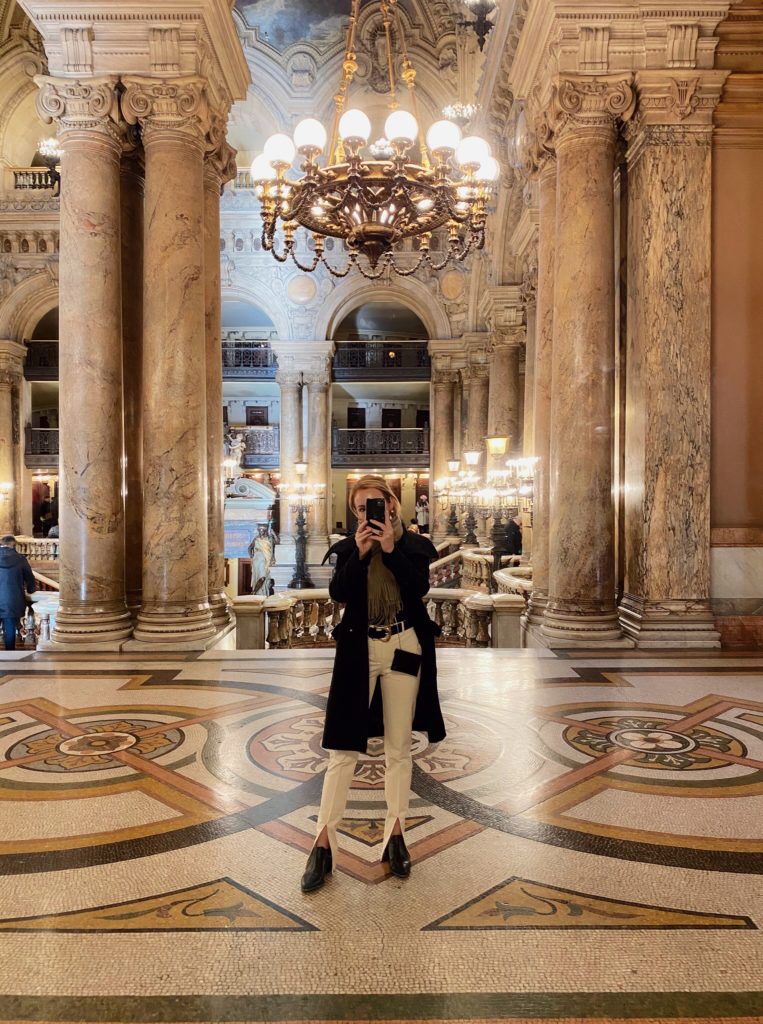
About the Palais Garnier
For a little back story, the Palais Garnier is a master piece of 19th century theater art architecture. It is without a doubt one of the most beautiful architectural structures in Paris, and one of the most beautiful theatres in Europe.
There are 1,979 seats inside the opera house at the Place de l’Opéra. While it is still operational today, tickets can be hard to come by for ballets and operas (not to mention expensive!) If you are interested in the architecture itself like I was, you can visit during the day for a guided tour. This is a great way to roam the interiors and learn the history of the opera house, without the expensive ticket price.
The Palais Garnier was built as the official Paris Opera House from 1861 to 1875. It was commissioned by Emperor Napoleon III. It gained international notoriety when it was used as the backdrop for Gaston Leroux’s 1910 novel The Phantom of the Opera.
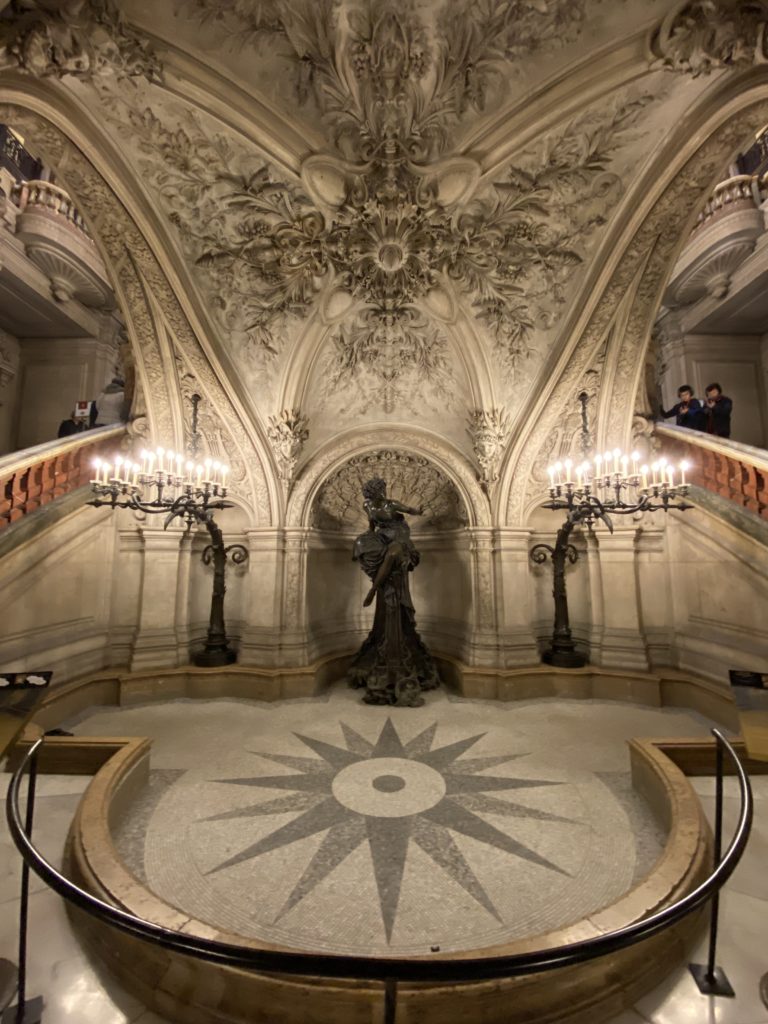
Visiting the Palais Garnier
I visited the Palais Garnier as a day guest given my interest was more in the building itself than seeing a show. This is the best way to roam the interiors at great length, as well as learning the history. In the evening there are performances, however you can expect more crowds before and after shows.
Visiting in the morning is the best time to see the Palais Garnier. There are fewer crowds and a beautiful morning light pours in through the massive windows.
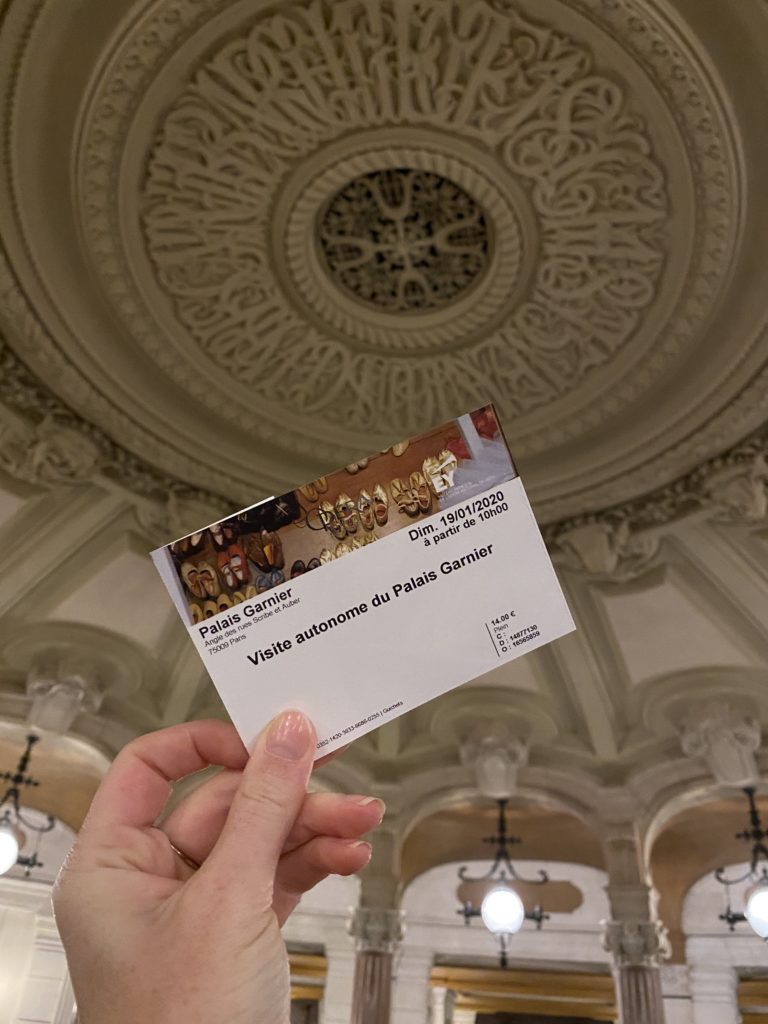
The best way to see the Opera House is to join a guided tour. We opted for a private two-hour tour to really get to know the ins and outs of the building. After all, I feel like I owed the Palais Garnier at least that after taking so long to finally visit!
This is easily one of my favourite tours I have booked in the city of Paris. While I love seeing the Eiffel Tower and Arc de Triomphe, I really felt like I got a better history of the city itself on this tour. There’s so much to learn every time I visit Paris that it just never gets old! You will also learn more about the boulevards and grandeur of the city while on the tour.
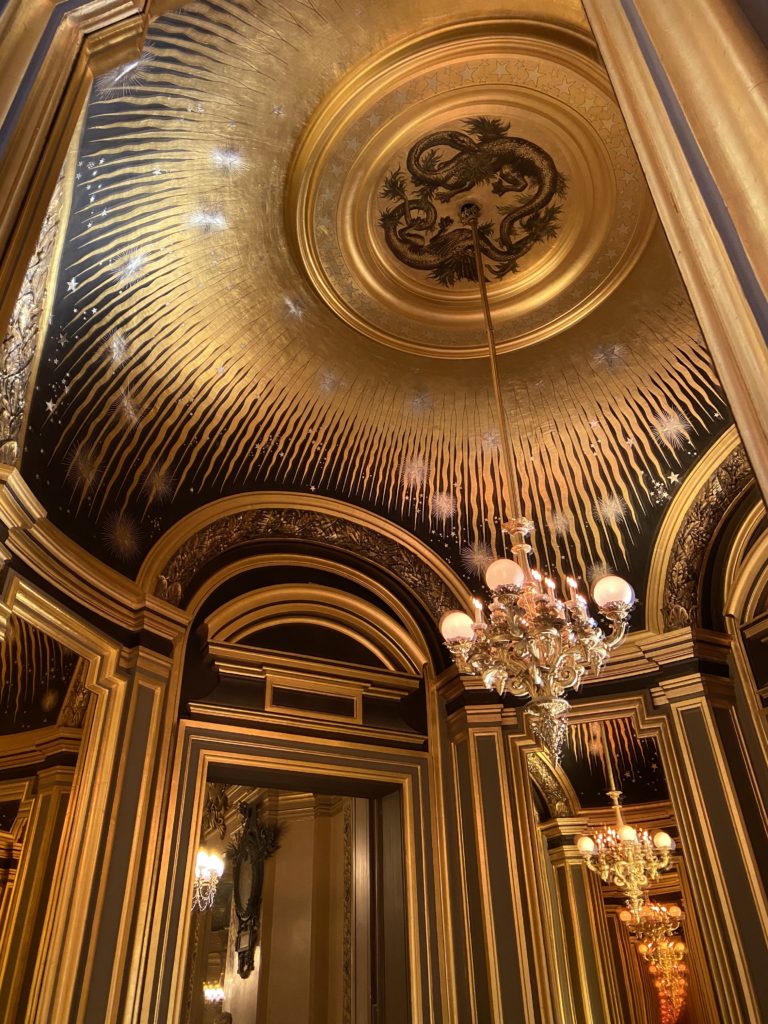
Plan your visit
Opening hours:.
From Monday to Sunday, from 10am to 7pm and until the end of performances. Access from street Havély or from the theatre public areas.
Ticket Prices:
Full rate: €14 (€12 outside exhibition periods) Reduced rate: €10 (€8 outside exhibition periods) Free admisssions (children under 12, unemployed)
We booked a private tour of the Palais Garnier for the full Opera House experience. You can book yours here through the Paris Opera House official website.
More from Paris
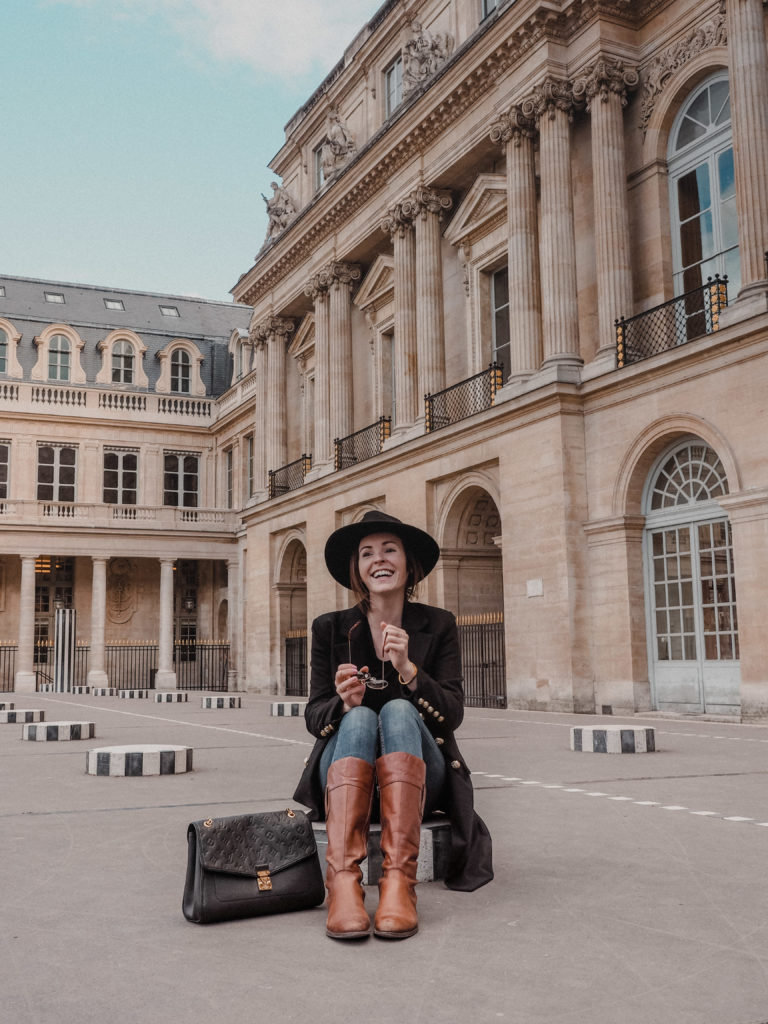
How to visit Paris like a local
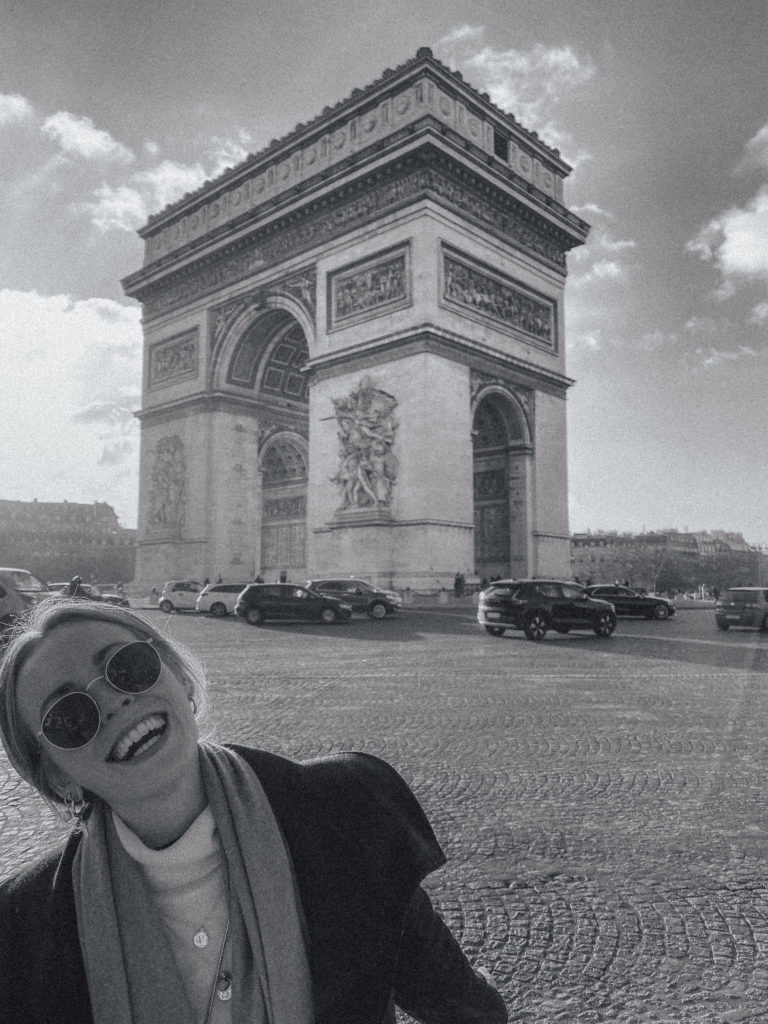
Your guide to Paris in Winter
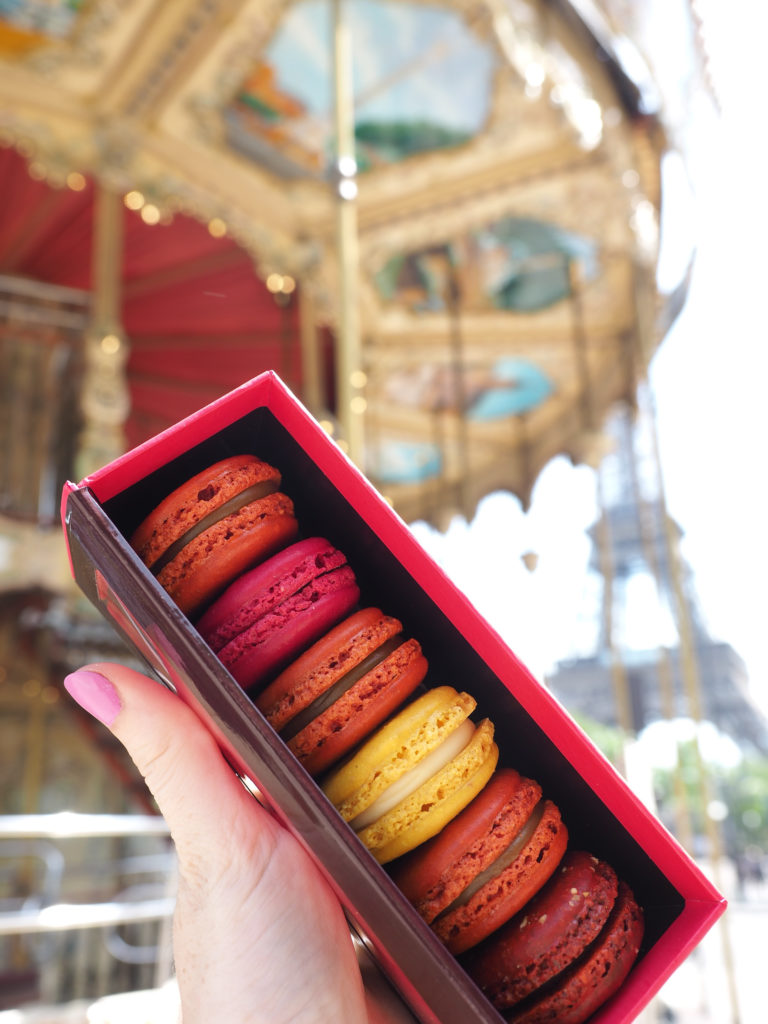
The best pastry classes in Paris
Brooke Saward founded World of Wanderlust as a place to share inspiration from her travels and to inspire others to see our world. She now divides her time between adventures abroad and adventures in the kitchen, with a particular weakness for French pastries.
Find me on: Twitter | Instagram | Facebook

Los Angeles
Plan a trip
First trip solo
Packing guide
20 Best Places for Solo Female Travel
Travel after a break up
20 Places in your 20’s
WAYS TO TRAVEL
Solo travel
Adventure travel
Luxury travel
Learn a language
Become a blogger

Experience Parisian Opera Culture at the Palais Garnier
Things to do in Paris Palais Garnier
Palais Garnier, also known as the Opera Garnier Paris or simply the Paris Opera is an architectural jewel in Paris with a fascinating history and prime status in Paris’s ballet and classical music milieu. An ode to Parisian architecture, the Palais Garnier is an enchanting inspiration for many and undeniably one of the most distinguished and grand opera houses in the world. The Palais Garnier is home to the Paris ballet, so anyone hoping enjoy a Parisian rendition of La Traviata or Mozart's The Magic Flute, you know where to head!
Before you set off to tour the opulent Palais Garnier, here are a few quick things you’d like to know. A brief history of the Palais Garnier, how to get the best Palais Garnier tickets , whether a guided tour or self guided tour works better and other details about the location, timings and how to get there.
Quick Jumplinks to Navigate the Guide
Palais garnier history, palais garnier tickets, inside palais garnier paris, palais garnier tour, self guided tour, expert guided tour.
- All You Need To Know About Visiting Palais Garnier - Hours & Directions
Palais Garnier Visitor Tips
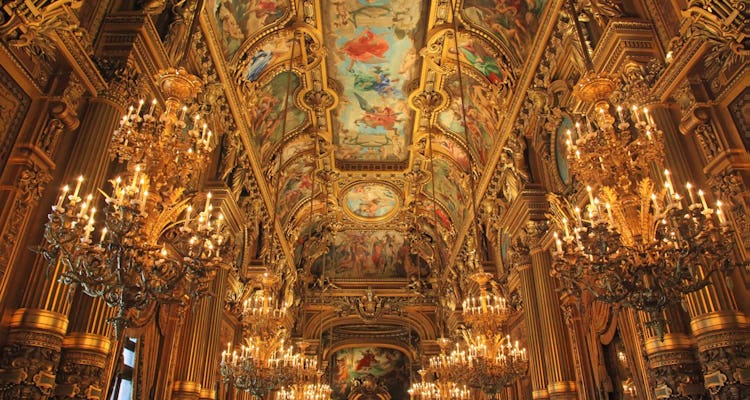
Palais Garnier’s history dates back to 1860, under the auspices of Emperor Napoleon III as a part of civic planner Baron Haussmann’s plan to renovate and transform all of Paris. A contest was organised to attract proposals for the construction of the Palais Garnier. Out of the 171 proposals submitted, Charles Garnier a little-known 35-year-old architect won the comission to build Paris’s Opera House.
Charles Garnier’s winning architectural plan devised mounting a spectacle a within a spectacle, in lieu with Napoleon III ‘s bourgeoisie tastes. The intention was to keep the Palais Garnier as a place for the wealthy and powerful where the rich would aspire to be spotted. This was keeping in mind France’s late 19th century, post-revolutionary, industrialized society. The Palais Garnier is a blend of architectural styles and the freedom endowed on Charles to experiment with a totally atypical dimension allowed this to manifest. In the late 19th century French society, one did not go to the Opera to view the mastery and grace of artists but to show off your wealth and power; to be aroused.
After 15 years of construction plagued by setbacks like the 1870-71 Franco-Prussian War and Siege of Paris, the Paris Commune, ultimate fall of France’s second Empire, and an 1873 fire the Palais Garnier was inaugurated on Januray 5, 1875. At the time it opened, Palais Garnier was the world's largest theatre and opera house. The Opera Garnier was part palace, part temple, part administrative center; a space where money was the new king, the new power, the new god.
The Palais Garnier till today remains an iconic symbol of Paris, not just for its magnificent façade and lavish interior, but for the era it represents: a France that had weathered a century of disruption and revolution. Viewed through this lens, Palais Garnier sure feels like a ‘sign’ of its time.
If you're looking for discounted tickets to the Palais Garnier, simply click on the Tickets tab below and book them via Headout. You can opt for a guided tour or simply purchase entry tickets and experience the Opera culture of Paris. A definite must while in the City of Lights!

Self Guided Tour of the Opera Garnier
• The Museum of the Opera • The sun and moon salons • Step over the grand staircase • Access the temporary exhibits of the Opera
Price - €12

Guided Tour of the Opera Garnier
• 90-minute tour of the Opera Garnier with access to the different areas. • English guided tour with official guides allowing a more interactive and educative experience.
This spectacle of this crowning attraction of the Opera-Haussmann neighborhood starts long before the curtain for the ballet rises. Here’s a summary of the emblematic areas at the Palais Garnier and a short glimpse of its elegant interiors.
The Exteriors

The exteriors of Palais Garnier is your coup d'œil into the realm of pomp and refinement that Charles Garnier manifested. Every inch of the building’s facade is a unique harmony between the sculpture, painting and architecture. The building dazzles with its balconies in onyx, golden statues of Apollo, smooth marble pillars, its delicate frescoes and rich gilding. To get the best view of its exteriors, walk further from the front steps to Avenue de l’Opéra till you can consume the whole of Palais Garnier, from top to bottom in all its glory.
Grand Staircase

The Grand Staircase is the first thing that commands your attention upon entrance. It is an exquisite piece of engineering marvel endowed in pink, green and white marble. Charles Garnier said it best when he proclaimed, “The opera is the staircase”. The staircase is flanked by 30 large single piece marble columns. Follow your eyes from the columns to the ceilings and meet the stunning fresco painted by Isidore Pils.A real high point of the visit, this staircase brings undeniable modernity to the building and contributes to making it an outstanding monument.

While you can’t go onto the stage, you can access the auditorium and take in a splendid views of the horseshoe shaped theatre. The Paris Opera stage is the largest in Europe and can accommodate as many as 450 artists. While the auditorium on the whole is overwhelmingly beautiful, the show stealer is the Marc Chagall ceiling and 8-ton chandelier hanging down from it.
Grand Foyer
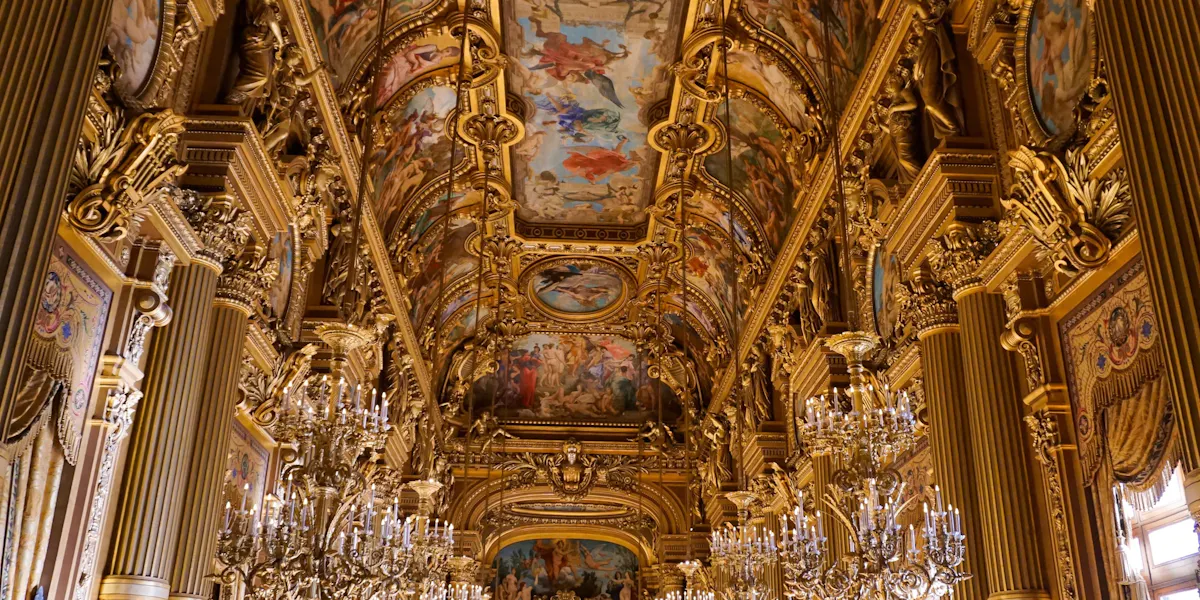
The Grand Foyer boasts of an 18 meters high, 154 meters long and 13 meters wide hall, covered in gold and gold paint. A space intended to take stroll, take a break and mingle, the foyer is strategically located right outside the highest paying boxes. Amidst the gold and glitter, is an impressive ceiling fresco painted by Paul Baudry. Each of these frescos have some connection to art and music. The central painting is an allegory of Music flanked by smaller paintings in oval frames on either sides, one representing Comedy, the other Tragedy.
Those of you who have been to the Hall of Mirrors at the Palace of Versailles , may see a resemblance. However, the Grand Foyer is definitely more visually appealing and far less crowded than the Palace of Versailles.
Opera Library-Museum
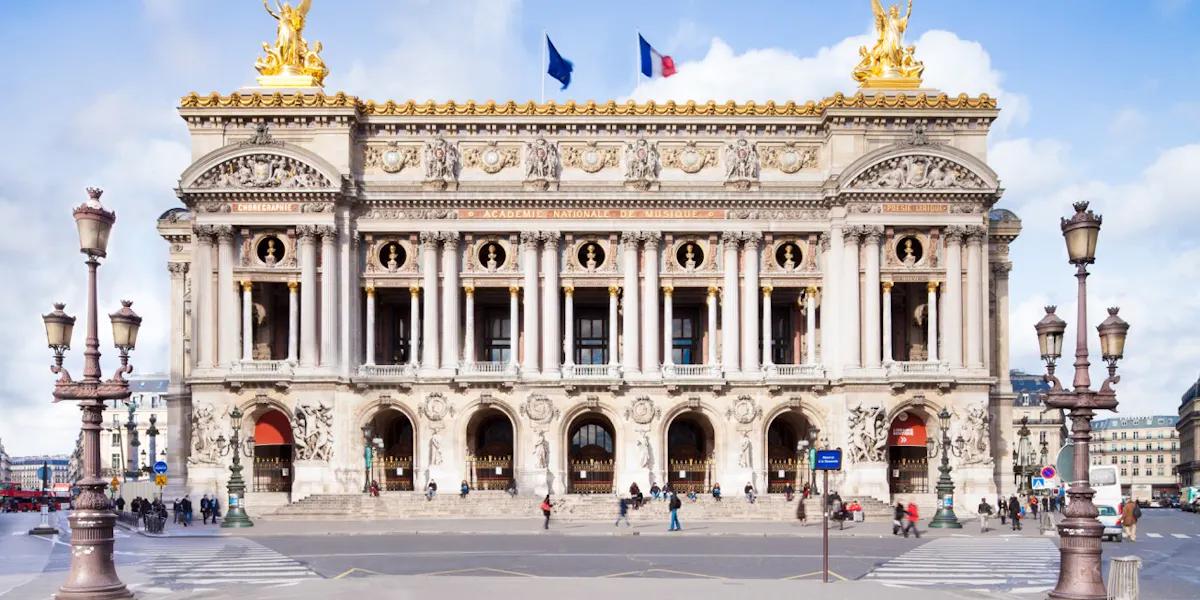
This well stocked library holds a vast collection of items stockpiled from years even before the Palais Garnier was fully constructed. Artefacts mainly pertain to opera and dance, but you will find a fine collection of , paintings, drawings, sketches, costumes, props and 3D models of stage sets. If you’re interested in knowing about the early years of Opera in Paris, a visit to this Library Museum will take you down the history lane.

If you choose to independently tour the Palais Garnier, we’d suggest going for an audio guided tour. The audio guide will help you learn in depth about the building, with anecdotes, documents and lesser known secrets, enriching your experience better. The audio guide points out features that you may have overlooked if you were to be walking without a guide or the audio device, hence ensuring that you get the best out of the Palais Garnier tour. A few things you should know before going for the Self Guided Audio Tour.
- The audio guide device costs an extra 5 Euros ( over and above the entry fee) but is completely worth the money ( and way cheaper than the guided tour).
- The audio guided tour lasts for 1 hour
- Be sure to have 5-7 Euros in cash for the audio guide as the counter accepts only cash. You are also required to leave an official photo id as a deposit while you buy the headset.
- Note, the basic self guided tour does not give you access to the auditorium.
- The Audio Guide is multilingual and available in French, English, Spanish, German, Italian, Portuguese, Russian, Chinese, Japanese and Korean.
Self Guided VIP Palais Garnier Tour
This “Behind the curtain” informative tour takes you through areas usually prohibited to the public. One can walk through the Foyer de la Danse, explore the auditorium, inspect Marc Chagall’s ceiling, the paintings in the Grand Foyer, the façade of the Palais Garnier and chart Palais Garnier’s history through the interactive timeline, all at your own pace.
- The VIP audio tour is offered on an iPad mini.
- The costs are higher than the basic tour. 7 Euros for a single person and 12 Euros if two tickets are bought together. This cost is over and above the entrance fee.
- This tour lasts for 1 hour 30 minutes and is available in French, English and Spanish only.
Buy Palais Garnier Self Guided Tour Tickets and save €5 on your first booking with Headout when you use promo code GOPARIS
These expert guides on guided tours unveil mysteries and give keen insights into the culture and history that led to the construction of the Opera Garnier Paris and are always more than happy to answer your doubts and queries. The guided tour even involves a 20 minute session in the auditorium where you will be seated while listening to stories about the ballet artists, elaborate decorations, French society elites who used to attend the Opera, design of the auditorium etc. Listen out for tales of Phantom of Opera in particular on the guided tour. Peering into his opera box is an all time highlight of the guided tour!.
- There are daily expert English guided Palais Garnier Tours which departs at 11:00 AM and 2:30 PM.
- The guided tour takes about 90 minutes and gives you access to all parts of Opera Garnier - the auditorium, gilded balconies, even up close the stage ( the self audio guided tour lacks access to the auditorium ).
- If the tour group size is big, you will be given headsets in order to listen to the guide clearly.
- Palais Garnier Guided tours in other foreign languages are available and details for its timings and departure can be checked on the official website.
Buy Palais Garnier Expert Guided Tour Tickets and save €5 on your first booking with Headout when you use promo code GOPARIS
All You Need To Know About Visiting Palais Garnier
Palais garnier hours.
• The Palais Garnier is open all days of the week - From September 10th to July 15th - 10:00 AM to 4:30 PM - From July 15th to September 10th - 10:00 AM to 5.30 PM • The Palais Garnier remains closed on January 1st and May 1st • The ticket office closes 30 minutes before the said day's closing time
Getting to Palais Garnier
Palais Garnier is on the corner of Rue Scribe & Rue Auber.
- By Metro - The closest Métro station is Opéra, which you can reach via Lines 3 (pea-green on the official RATP Métro map), 7 (pink), and 8 (lavender).
- By RER - If you're traveling by RER, the nearest RER stop is Auber on Line A.
- By Bus - Routes 20, 21, 22, 27, 29, 42, 52, 53, 66, 68, 81 and 95 stop a short walk away from the Paris Opera.
- You can take a Palais Garnier Tour for free on the 1st Sunday of each month. Note, this also happens to be the most crowded day of the month!
- English tours are on Wednesdays, Saturdays and Sundays at 11:30 AM and 2:30 PM. In July and August, English tours run every day at 11:30 AM and 2:30 PM.
- If you have the Paris Pass, you can take a free English speaking tour on a first-come-first serve either at 11:00 AM or 2:30 PM.
- Since the ticket counter selling tickets for tours and theatre is combined, the lines can be slow moving. For quick entry, we’d suggest purchasing tickets for both tours and theatre online in advance. If this is a last minute plan and you are unable to buy tickets online, there is an automated ticket machines which can help you gain entry quicker.
- Admission to the auditorium may be restricted or forbidden at times for technical or artistic reasons. If you want guaranteed access to the auditorium, opting for the first tour in the morning is suggested. That way, you can avoid any potential rehearsal conflicts.
- For a sedate independent tour of the Palais Garnier, keep aside 2 hours of your day. This is including the stringent security check which will take about 30 minutes on a crowded day.
- If you're interested in seeing an Opera show, you can pre-book your tickets here . Try timing your visit such that you can squeeze in a tour and an opera show.
- The Palais Garnier roof has a honey bee hive and over 300 kgs of honey is harvested every year. You can pick up a tiny bottle from the gift shop as you exit. No better souvenir, we say!
More Paris Guides
Explore more of Paris with our detailed Paris attraction guides.

See more Paris. Save more money.
Save €5 on your first booking with Headout when you use promo code GOPARIS
EXPLORE NOW
Lakshmi Menon
Born to parents bit by the wander bug, Lakshmi calls her love for travel "hereditary and habitual". Perpetually ensconced with a book in her hand and a mug of coffee in the other, she has been to over 15 countries in her 23 years of existence and is currently saving miles and money for her solo trip to Iceland. Always hustling towards the least trodden path, she has encountered some wonderful people during her escapades and if you ever meet her, she won't stop gushing about them.
Be a smart traveler
The first to know about trending destinations, travel deals, tips and all things travel.
- Palais Garnier
- What to see and do
- Museums and monuments
Description
Community facilities, accessibility.
Adjacent to the shopping pantheons, Galeries Lafayette and Printemps , the opera designed by Charles Garnier in 1875 is an architectural feat open to the public.
A lavish setting
Under an opulent, 30-meters-high vault, the spectacular double staircase leads to the Grand Foyer , and to the different floors in the auditorium . As you enter the horseshoe-shaped theatre, prepare to be stunned by the beauty before you. The colossal auditorium is decorated in velvet and gilding, with a bronze and crystal chandelier outfitted with 340 lights , weighing nearly 8 tons , hanging above it all. Glance up, and you will find yourself utterly spellbound by the ceiling painted by Marc Chagall .
Barring show times, which can include classic or contemporary performances , you may also visit the museum-library , the Orchestra Gallery , the Grand Vestibule and most notably, the Grand Foyer . Inspired by the Hall of Mirrors in Versailles , it has a breathtaking view from the Place de l’Opéra all the way to the Louvre . Guided visits and audioguides in several languages are also available.
Opéra Garnier and the Impressionists
One of the oldest and most prestigious classic dance companies in the world, the historic Opéra Garnier dance school still trains future ballet stars . It also inspired several works of art by the Impressionist painter Edgar Degas, a regular at the Opéra , whose famous painting “*The Dance Class*”, and the sculpture “ Little Dancer Aged Fourteen” are both exhibited at the Musée d’Orsay .
Access and contact
- https://www.operadeparis.fr/en
Métro : Opéra (Lines 3, 7 and 8) Chaussée d'Antin - La Fayette (Line 7 and 9) RER A - Auber Bus : lines 20, 21, 22, 27, 29, 42, 52, 53, 66, 68, 81, 95
Days and opening hours
All year round, daily between 10 am and 5 pm. Closed exceptionally on January 1st, May 1st and December 25th. The Palais Garnier is open every day from 10am to 5pm (tickets sold until 4pm), except for daytime performances and exceptional closures. The last entrance is 45 minutes before closing time.
- Full price: 15 € Reduced price: 10 €. Free entry for children < 12 years, Job-seeker, disabled people and accompanying persons.
Spoken languages
Documentation languages (home), single mean time tour.
- https://www.operadeparis.fr/opera-et-vous/en-situation-de-handicap
- [email protected]
- Physical disability
- Deaf / Hard of Hearing
- Visual impairment
- Mental / Cognitive
Pratical informations
- access to the establishment: graspable outside call button The height of the call button is less than 130cm and is positioned on a wall within reach of a wheelchair. " data-tooltip-close-text="Close" data-tooltip-close-title="Close this window" id="label_tooltip" onclick="dataLayer && dataLayer.push({ 'event': 'ClicAccessibilityPopinInfo' });" >
- floor-level pathways Hard, smooth pathways, non-slip and floor-level. " data-tooltip-close-text="Close" data-tooltip-close-title="Close this window" id="label_tooltip" onclick="dataLayer && dataLayer.push({ 'event': 'ClicAccessibilityPopinInfo' });" >
- pathways that change levels are offset by a sloping surface A sloping surface with an incline of less than or equal to 6% is provided to overcome this change of level.The following slope values are tolerated as an exception:- up to 10% over a distance less than or equal to 2m- up to 12% over a distance less than or equal to 0.50mA rest platform is required at the top and bottom of each sloping surface, regardless of its length.In the case of a sloping surface with an incline greater or equal to 5%, a rest platform is required every 10m. " data-tooltip-close-text="Close" data-tooltip-close-title="Close this window" id="label_tooltip" onclick="dataLayer && dataLayer.push({ 'event': 'ClicAccessibilityPopinInfo' });" >
- reserved and adapted parking space located close to the entrance of the site It must be marked out on the ground and indicated by a vertical sign. The parking area must measure a minimum of 3.30. " data-tooltip-close-text="Close" data-tooltip-close-title="Close this window" id="label_tooltip" onclick="dataLayer && dataLayer.push({ 'event': 'ClicAccessibilityPopinInfo' });" >
- parking spaces laid out and connected to the road or building by an accessible pathway Hard, smooth pathways, non-slip and floor-level. " data-tooltip-close-text="Close" data-tooltip-close-title="Close this window" id="label_tooltip" onclick="dataLayer && dataLayer.push({ 'event': 'ClicAccessibilityPopinInfo' });" >
- reception desk easily identifiable and accessible There must be at least one lowered section with enough space (70cm high, 30cm deep and 60cm wide) under the counter to allow for the feet and knees of the seated person. " data-tooltip-close-text="Close" data-tooltip-close-title="Close this window" id="label_tooltip" onclick="dataLayer && dataLayer.push({ 'event': 'ClicAccessibilityPopinInfo' });" >
- free admission for one accompanying person
- free admission on presentation of proof of entitlement
- the accessible entrance is the main entrance Floor-level entrance, usable passing width of the door 77cm. If the entrance has an access ramp (integrated, removable, etc.) the latter must not exceed 6% (over 10m).Manoeuvring space in front of the door. " data-tooltip-close-text="Close" data-tooltip-close-title="Close this window" id="label_tooltip" onclick="dataLayer && dataLayer.push({ 'event': 'ClicAccessibilityPopinInfo' });" >
- the accessible entrance is the secondary entrance (indicated) Floor-level entrance, usable passing width of the door 77cm (or 1.20m with at least one two-way panel of 80cm for doors to premises with over 100. " data-tooltip-close-text="Close" data-tooltip-close-title="Close this window" id="label_tooltip" onclick="dataLayer && dataLayer.push({ 'event': 'ClicAccessibilityPopinInfo' });" >
- staff informed or trained
- specific tariff policy
- manual entrance door
- accessible information plates a maximum of 1m30cm from the floor.tilted information plates.Possibility to get up close. " data-tooltip-close-text="Close" data-tooltip-close-title="Close this window" id="label_tooltip" onclick="dataLayer && dataLayer.push({ 'event': 'ClicAccessibilityPopinInfo' });" >
- all documentation graspable Documentation presented at a height of between 80cm and 130cm.Accessible room cards.. " data-tooltip-close-text="Close" data-tooltip-close-title="Close this window" id="label_tooltip" onclick="dataLayer && dataLayer.push({ 'event': 'ClicAccessibilityPopinInfo' });" >
- performance room with a reserved space
- accessible cloakroom Easily identifiable and accessible, lowered section with enough space under the counter to allow for the feet and knees of the seated person. " data-tooltip-close-text="Close" data-tooltip-close-title="Close this window" id="label_tooltip" onclick="dataLayer && dataLayer.push({ 'event': 'ClicAccessibilityPopinInfo' });" >
- multimedia content access system compensation device for inaccessible areas. " data-tooltip-close-text="Close" data-tooltip-close-title="Close this window" id="label_tooltip" onclick="dataLayer && dataLayer.push({ 'event': 'ClicAccessibilityPopinInfo' });" >
- spaces equipped with reserved spaces and adapted to people in wheelchairs
- floor-level establishment No stairs or steps. " data-tooltip-close-text="Close" data-tooltip-close-title="Close this window" id="label_tooltip" onclick="dataLayer && dataLayer.push({ 'event': 'ClicAccessibilityPopinInfo' });" >
- wheelchair loan
- seated area available
- seated areas available (several spread out across the entire site)
- présence d’un lave main dans les sanitaires adaptés
- accessible communal toilets Height of the toilet seat between 46cm and 50cm, maximum distance between the toilet seat and the support rail 40cm, horizontal side support rail at a height of between 70cm and 80cm, side manoeuvring area (80cm. " data-tooltip-close-text="Close" data-tooltip-close-title="Close this window" id="label_tooltip" onclick="dataLayer && dataLayer.push({ 'event': 'ClicAccessibilityPopinInfo' });" >
- toilets: transfer direction onto the toilet seat to the right Position yourself parallel to the toilet seat, back facing the wall. Do you go to the right or to the left to sit down?. " data-tooltip-close-text="Close" data-tooltip-close-title="Close this window" id="label_tooltip" onclick="dataLayer && dataLayer.push({ 'event': 'ClicAccessibilityPopinInfo' });" >
- toilets: transfer direction onto the toilet seat to the left Position yourself parallel to the toilet seat, back facing the wall. Do you go to the right or to the left to sit down?. " data-tooltip-close-text="Close" data-tooltip-close-title="Close this window" id="label_tooltip" onclick="dataLayer && dataLayer.push({ 'event': 'ClicAccessibilityPopinInfo' });" >
- Communal staircase adapted for secure movement Step height 17cm maximum, contrasting and non-slip step tread (at least 3cm), 1st and last riser contrasting, warning strip (visual and tactile) in descent at a distance of 50cm from the tread of the first step (this distance may be reduced to 28cm from the first step of the staircase), handrail on each side at a height of between 80cm and 100cm which extends horizontally one step’s length before and after the first and last step. 1m width between the handrails. " data-tooltip-close-text="Close" data-tooltip-close-title="Close this window" id="label_tooltip" onclick="dataLayer && dataLayer.push({ 'event': 'ClicAccessibilityPopinInfo' });" >
- adapted elevator Passing width: 80cm, interior width: 100cm, depth: 130cm minimum and controls situated at a height of less than 130cm. " data-tooltip-close-text="Close" data-tooltip-close-title="Close this window" id="label_tooltip" onclick="dataLayer && dataLayer.push({ 'event': 'ClicAccessibilityPopinInfo' });" >
- visual intercom Intercom devices are equipped with a system enabling staff at the establishment to see the visitor. " data-tooltip-close-text="Close" data-tooltip-close-title="Close this window" id="label_tooltip" onclick="dataLayer && dataLayer.push({ 'event': 'ClicAccessibilityPopinInfo' });" >
- adapted access control to the car park Videophone and access control equipped with a magnetic loop. " data-tooltip-close-text="Close" data-tooltip-close-title="Close this window" id="label_tooltip" onclick="dataLayer && dataLayer.push({ 'event': 'ClicAccessibilityPopinInfo' });" >
- acceo: instant speech transcription and visio-interpretation in French sign language (LSF)
- reception/information desk equipped with a hearing assistance system with a magnetic loop
- reservation/contact via SMS and/or email
- reservation possible by webcam
- staff trained in French sign language (LSF)
- uniform signage to help people find their way around
- text/image signage Make it easy to find your way around and combine text & images, large characters and positioning allowing a proximity of 5cm or over. " data-tooltip-close-text="Close" data-tooltip-close-title="Close this window" id="label_tooltip" onclick="dataLayer && dataLayer.push({ 'event': 'ClicAccessibilityPopinInfo' });" >
- performance or tour assistance aids Surtitles.Written materials. " data-tooltip-close-text="Close" data-tooltip-close-title="Close this window" id="label_tooltip" onclick="dataLayer && dataLayer.push({ 'event': 'ClicAccessibilityPopinInfo' });" >
- visual alarm with flashing light in isolated spaces
- intercom equipped with a hearing assistance system with a magnetic loop
- audiovisuals are in French sign language (LSF)
- subtitled audiovisuals
- visioguide with overlay in French sign language (LSF)
- subtitled visioguide
- adapted elevator Display of floor levels and installation of a magnetic loop. " data-tooltip-close-text="Close" data-tooltip-close-title="Close this window" id="label_tooltip" onclick="dataLayer && dataLayer.push({ 'event': 'ClicAccessibilityPopinInfo' });" >
- audioguides equipped with a volume control device
- audioguides equipped with induction loops
- independent visit possible
- guided tour in French sign language (LSF)
- guided tour in international sign language (ISL)
- guided tours with lip reading
- guided tours with an amplifying device
- guided tours with a magnetic loop device
- the dangers identified have been addressed Secure and closed establishment (staff present on site) with no direct access to a dangerous environment with no indication (e.g.: lake, swimming pool, busy road). " data-tooltip-close-text="Close" data-tooltip-close-title="Close this window" id="label_tooltip" onclick="dataLayer && dataLayer.push({ 'event': 'ClicAccessibilityPopinInfo' });" >
- brochures/documentations classified by topic Simple classification by geographic position, type of site, etc. " data-tooltip-close-text="Close" data-tooltip-close-title="Close this window" id="label_tooltip" onclick="dataLayer && dataLayer.push({ 'event': 'ClicAccessibilityPopinInfo' });" >
- simplified adapted documentation (illustration through images, photos, drawings)
- adapted signage Make it easy to find your way around and combine text & images. " data-tooltip-close-text="Close" data-tooltip-close-title="Close this window" id="label_tooltip" onclick="dataLayer && dataLayer.push({ 'event': 'ClicAccessibilityPopinInfo' });" >
- adapted activities
- educational workshops
- adapted room cards
- specific tours
- adapted opening hours (morning performances)
- children's programme
- childcare service
- family tariffs/free admission for children
- secure and closed establishment
- large lockers or left luggage lockers for pushchairs
- possibility to leave pushchairs at the cloakroom
- baby carrier loan
- pushchair loan
- toilet facilities suitable for children (toilet seat and washbasin height)
- changing table
- children's/family applications for the tour
- audioguides with a children's circuit
- children's visit booklets/games
- pushchairs accepted for the tour
- visioguides with a children's circuit
- Pathways that change levels are offset by a sloping surface
- pets accepted on site and during guided tours
- reception/information desk equipped with a sound amplification system
- free admission for persons aged over 60
- Offer adapted to seniors
- documentation in enlarged characters
- magnifying glass loan
- cane wheelchair loan
- horizontal support rail
- diagonal support rail to enable the seated person to raise themselves up easily
- communal staircase adapted for secure movement Handrail on both sides. " data-tooltip-close-text="Close" data-tooltip-close-title="Close this window" id="label_tooltip" onclick="dataLayer && dataLayer.push({ 'event': 'ClicAccessibilityPopinInfo' });" >
- private staircase adapted for secure movement Handrail on both sides. " data-tooltip-close-text="Close" data-tooltip-close-title="Close this window" id="label_tooltip" onclick="dataLayer && dataLayer.push({ 'event': 'ClicAccessibilityPopinInfo' });" >
- stairs compensated for by a lift or an elevator
- Legible information plates Possibility to get up close (5cm to 25cm).Sufficient character size and contrast.Legible font type (arial and verdana).Reflection-free. " data-tooltip-close-text="Close" data-tooltip-close-title="Close this window" id="label_tooltip" onclick="dataLayer && dataLayer.push({ 'event': 'ClicAccessibilityPopinInfo' });" >
- Specific accessible information plates (large characters)
- Copyright image:
- Jean-Baptiste Gurliat/Ville de Paris
Expired session
Opera Garnier – 5 Incredible Things to See Inside the Palais Garnier!
The Opera Garnier is one of the best known symbols of Paris along with the Eiffel Tower and others. But did you know the interior is even more stunning than the outside?
Let’s explore together the 5 incredible things to see inside the Palais Garnier. After that, I’m sure you’ll book your visit in a heartbeat!
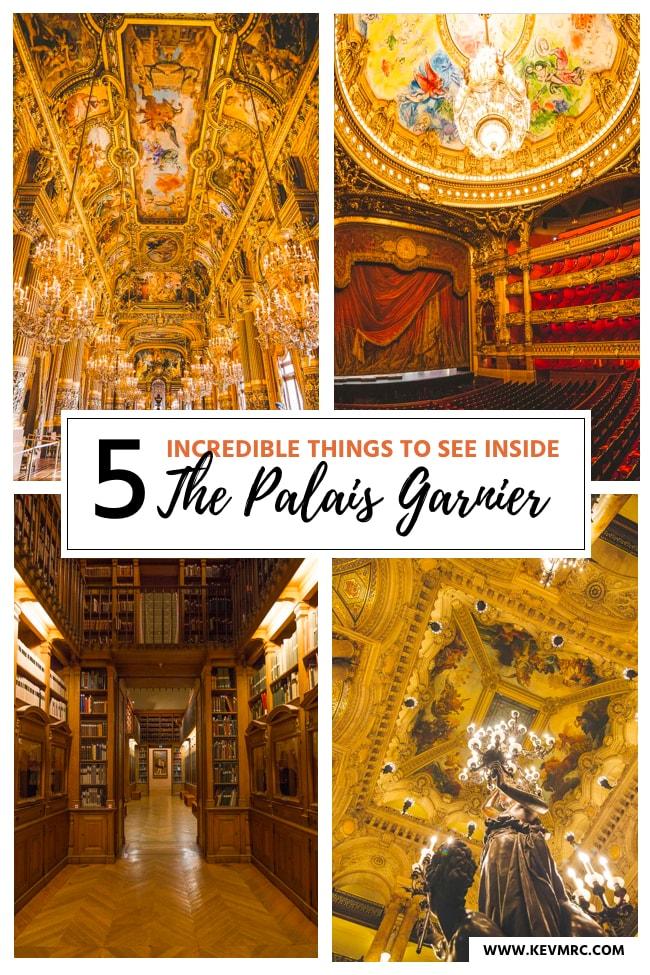
The Opera Garnier, also named Paris Opera, or Palais Garnier, is a Second-Empire Opera built in 1875 by Charles Garnier, under Emperor Napoleon III.
The building is massive: 56 meters high (184 feet), 155 meters long (508 feet) and 101 meters wide (332 feet). Most people know the Opera Garnier building; its external appearance. However, the inside of the Palais Garnier is so incredible it must be included in your Paris itinerary .
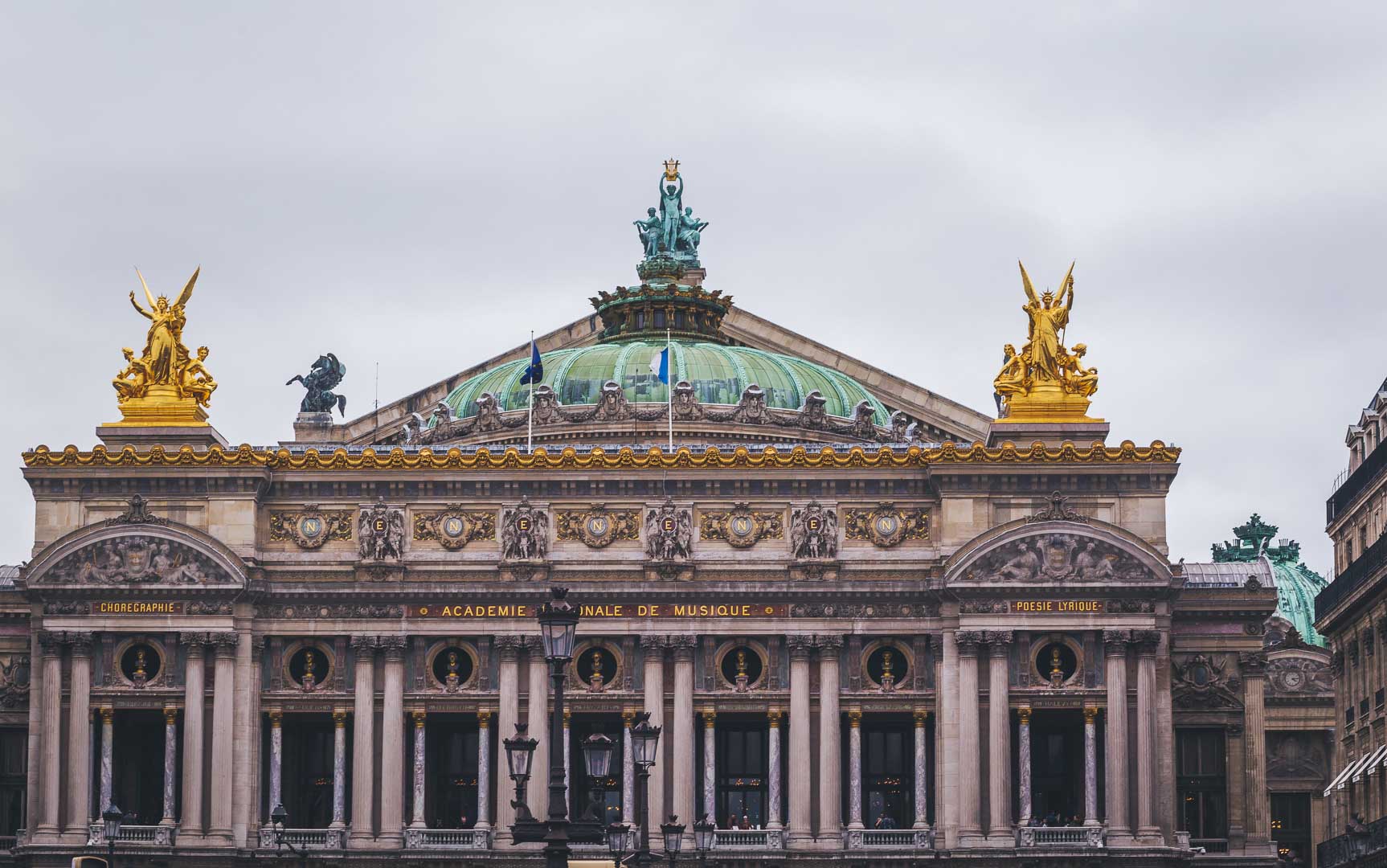
In this comprehensive guide about the Opera Garnier, you’ll find everything you need to know for your visit, from deciding if you want to visit, to helping you make the most out of your visit.
TABLE OF CONTENTS
Where is the Opera Garnier?
Interesting facts about the palais garnier, 5 incredible things to see in the opera garnier in paris, opera garnier tickets + how to save time, opera garnier opening hours, special tips for your visit to the opera de paris, what to visit after the palais garnier.
The Opera Garnier is located in the 9th arrondissement of Paris, next to Paris Saint-Lazare.
It’s a 10 minutes walk from the famous Place Vendôme and Notre-Dame de Lorette , and a 15 minutes walk from the Louvre ( discover the must-sees in the Louvre museum ) and the Palais Royal .
To visit the Opera, you don’t enter through the main entrance. The entrance is on the left side. The exact address for the entrance is:
8 rue Scribe, 75009 Paris
How to get to the Opera Garnier?
To get to the opera by train, you can either take:
- the RER A to “Auber”
- the metro lines 3, 7 and 8 to “Opéra”
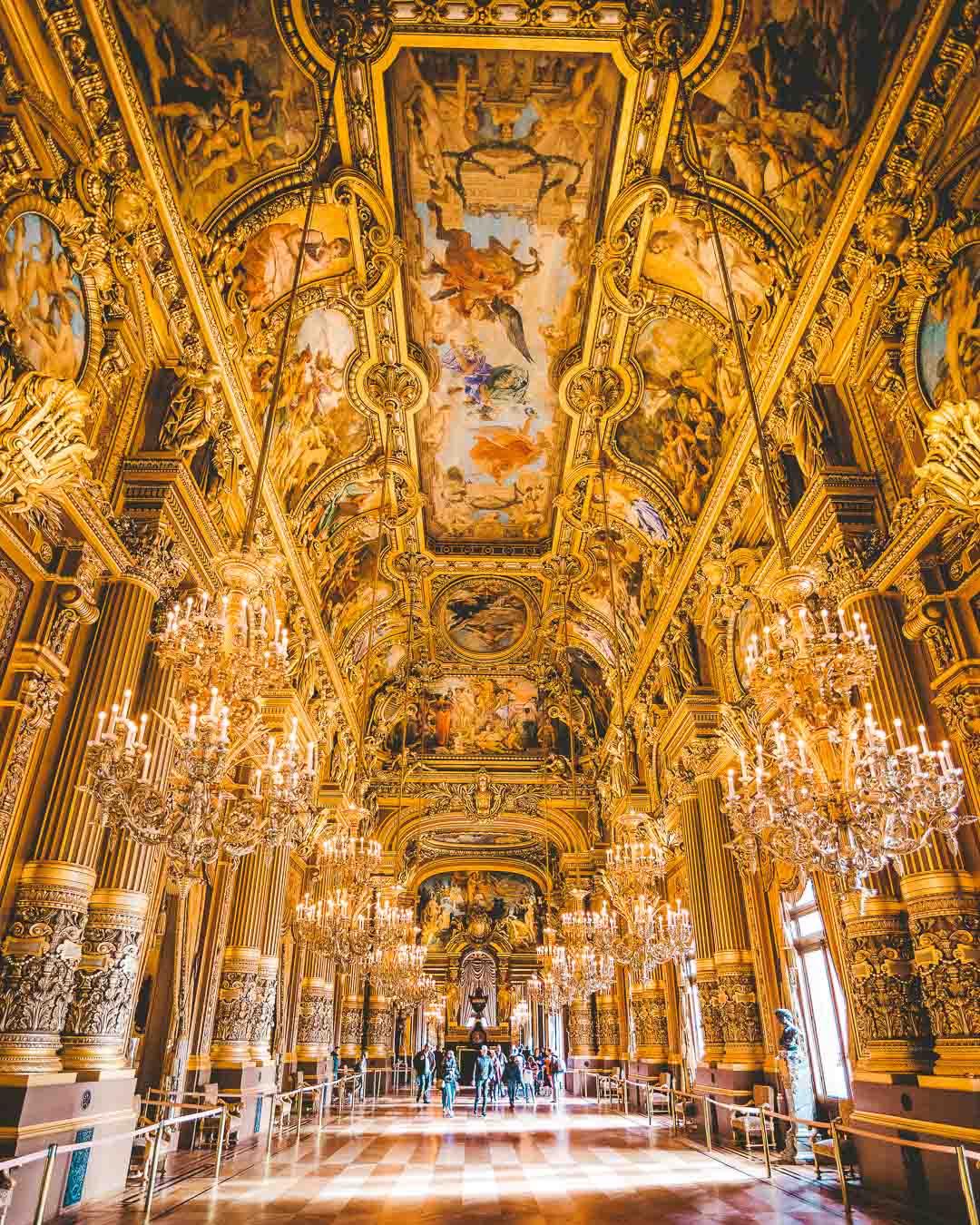
I can’t talk about a building such as the Opera without mentioning its history. The Palais Garnier’s history is pretty rich, but I know you didn’t come here to learn in lengths about the history of the place. I’ll keep it short, with these bite-sized history facts:
- the Opera Garnier was designed by Charles Garnier, who won the international design competition, attended by 171 architects
- the Palais Garnier was commissioned by the emperor Napoleon III
- the construction began in 1861, and took 15 years, finishing in 1875
- it’s one of the largest theaters in the world, with a seating capacity of 1,979 people
- the Opera is the inspiration for the novel The Phantom of the Opera by Gaston Leroux
- there is a huge underground water tank below the Opera
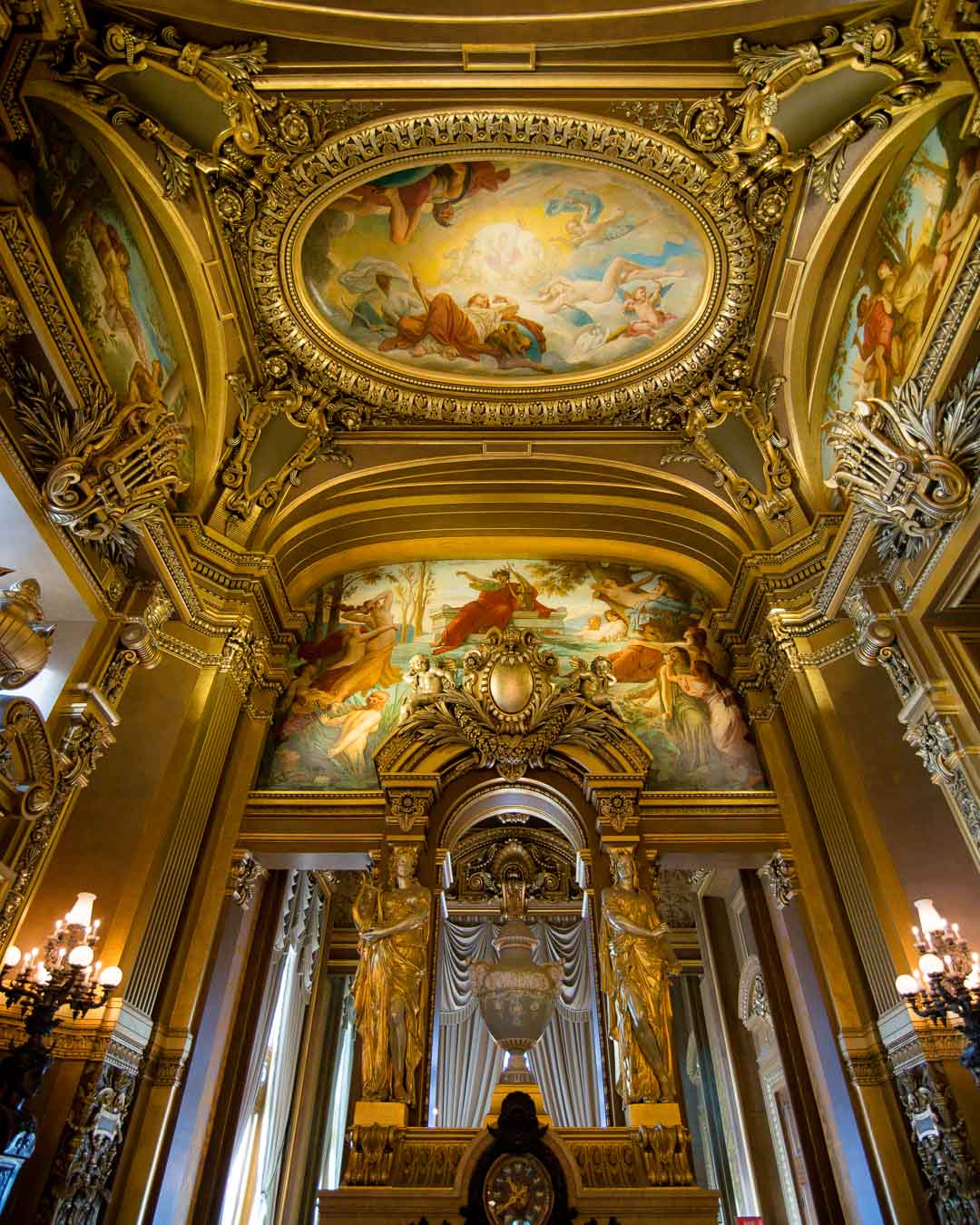
The Opera Garnier is a stunning building. From the outside, it looks wonderful, with all the decorations on the facade, the paintings, and golden statues.
You can find below the details of everything you can find on the main facade of the Palais Garnier
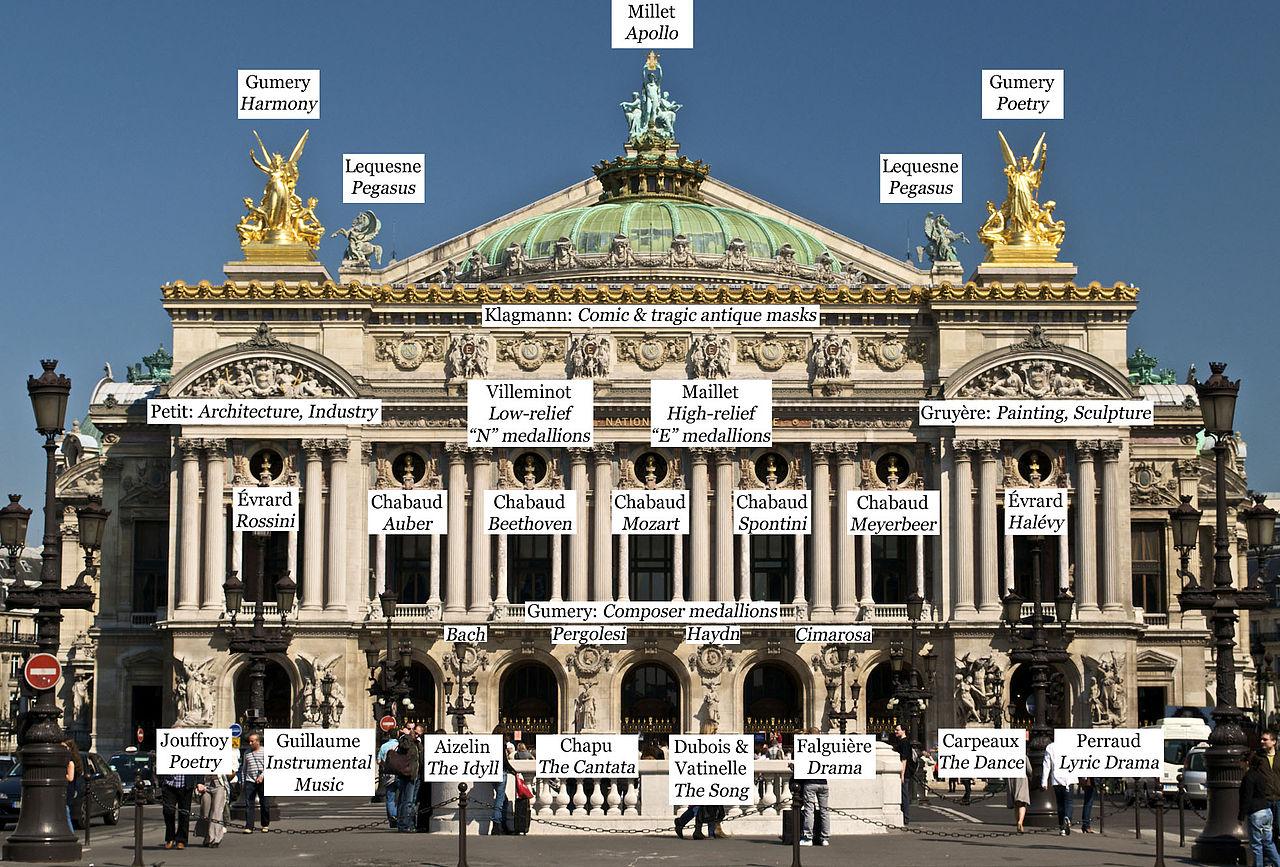
Photo by Peter Rivera under CC BY 2.0
However many don’t know that you can go inside the Opera! And let me tell you that the inside is absolutely sumptuous. Not sure you should enter the Opera? Here are 5 incredible things you can see inside, to help you make up your mind:
- Le Grand Escalier
The Auditorium
Le grand foyer.
- The Library
Let’s discover in more details each of the 5 things.
1- Le Grand Escalier – The Grand Staircase
The first thing you’ll see when entering the Opera Garnier is the monumental staircase.
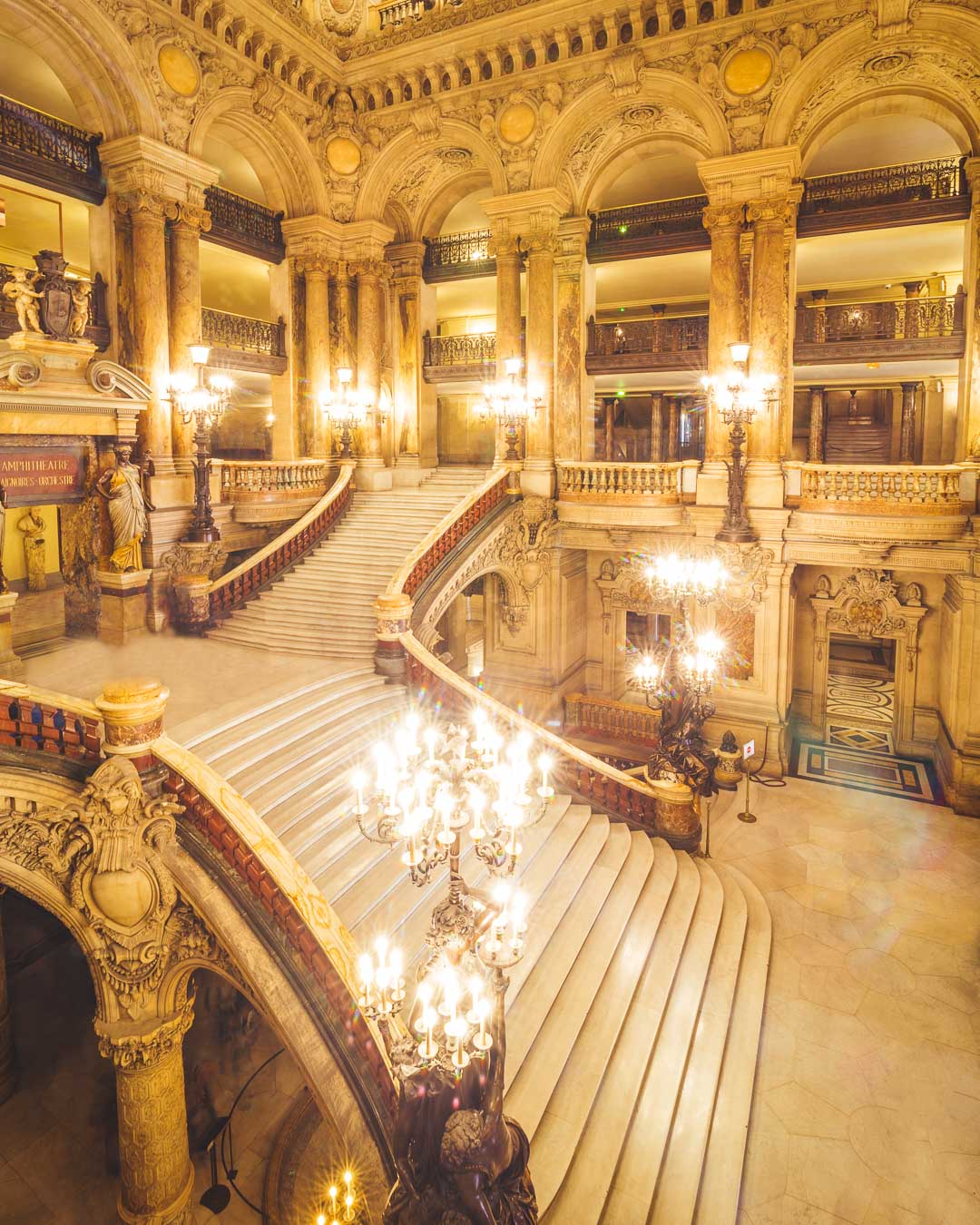
Named Le Grand Escalier (the Grand Staircase), it’s truly imposing. There is one main row of stairs, that leads to the representation room (the Auditorium).
Then, the staircase is divided into 2 row of stairs, that lead up to the balcony, and to the main hall (le Grand Foyer).
The Grand Staircase is built out of white marble.
In addition to the staircase itself, you’ll notice the two delicate statues acting as torchères, holding the lights.
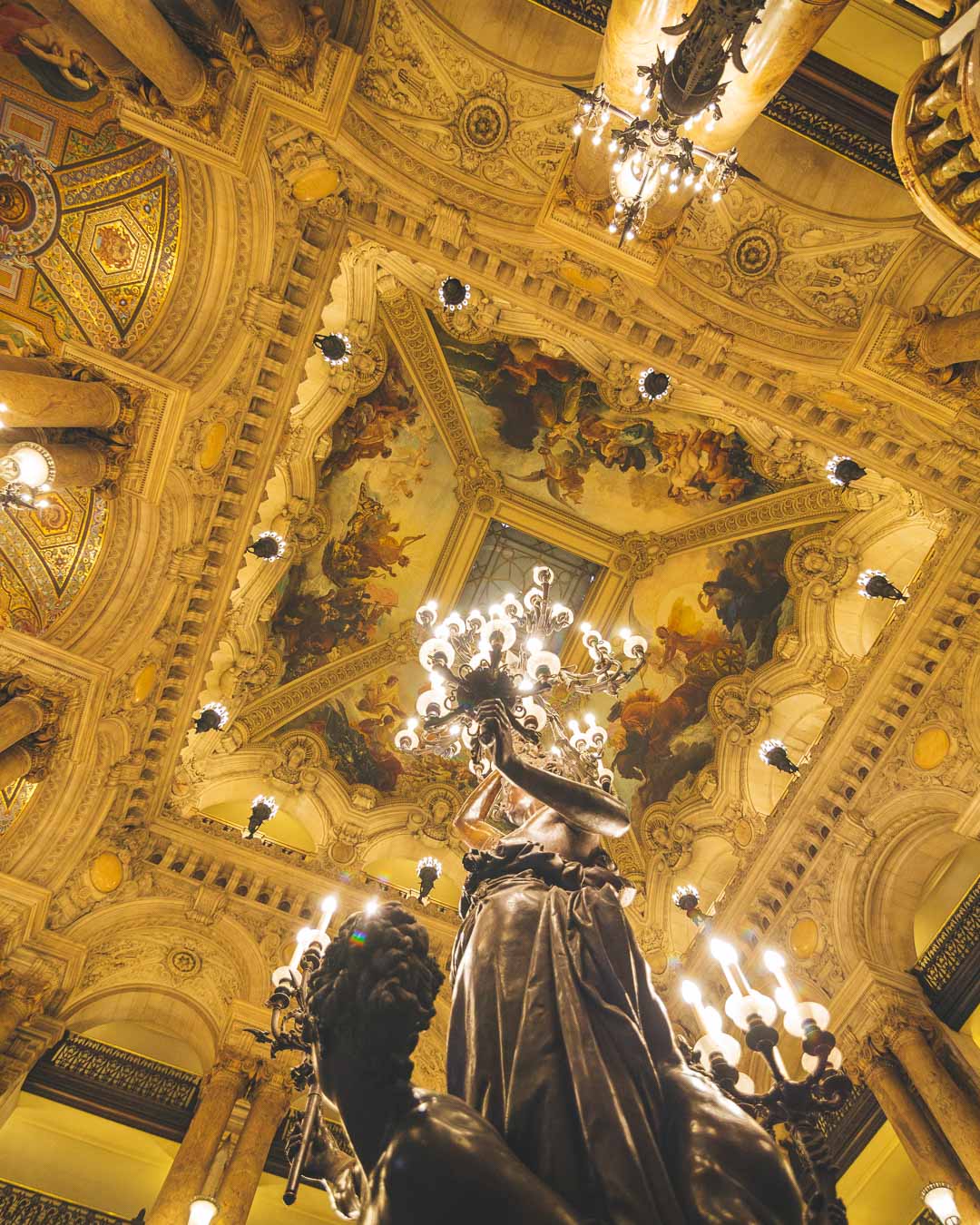
The ceiling of the Grand Escalier is also pretty impressive by itself, 30 meters (98 feet) above the ground.
The ceiling is made of 4 beautiful paintings, by Isidore Pils :
- The Triumph of Apollo
- Minerva Fighting Brutality Watched by the Gods of Olympus
- The Enchantment of Music Deploying its Charms
- The City of Paris Receiving the Plan of the New Opera
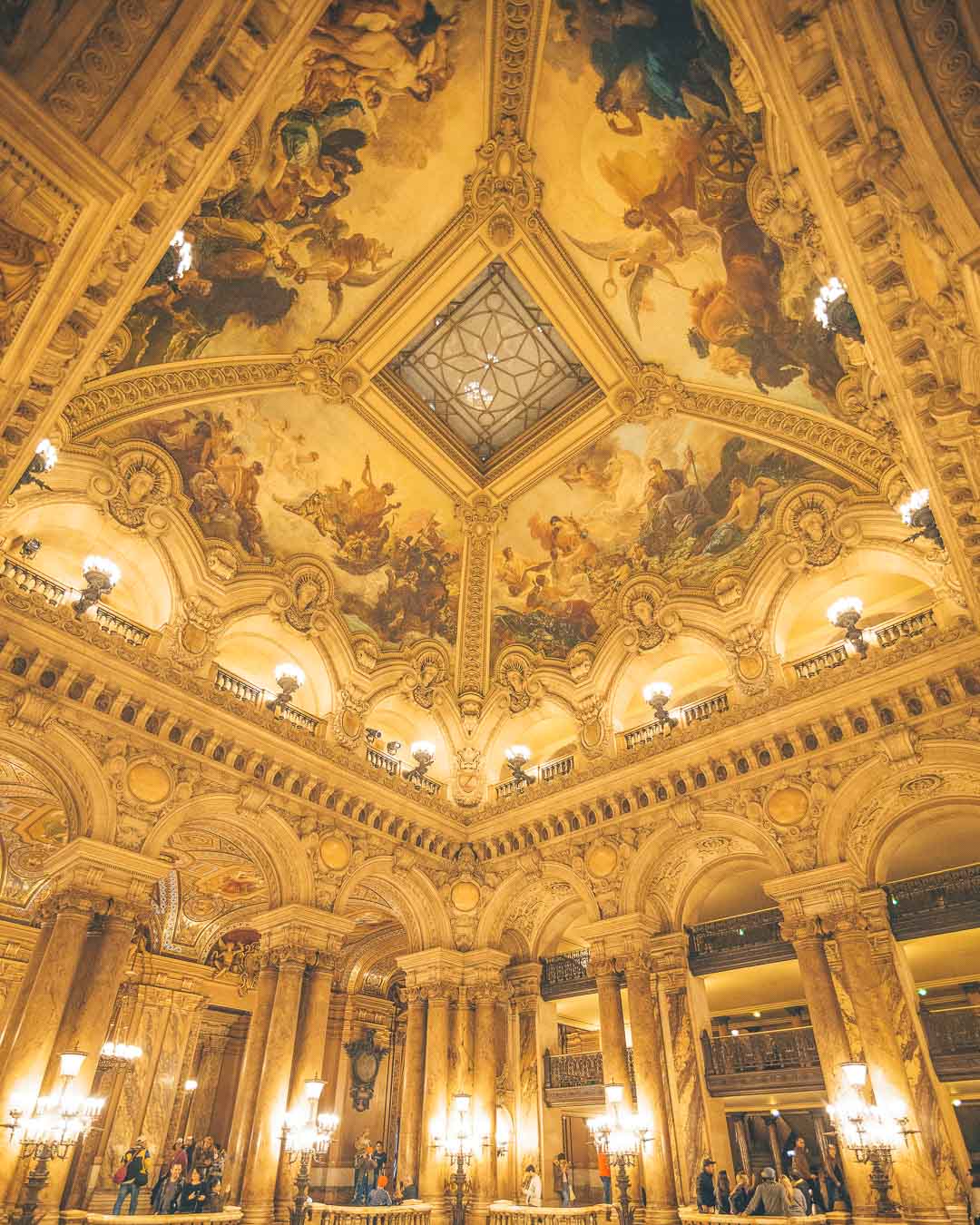
You’ll discover the second interesting thing to see in the Opera Garnier right after the first flight of stairs of the Grand Staircase. By pushing the small wooden doors, you’ll enter the Auditorium, the main stage of the Opera Garnier.
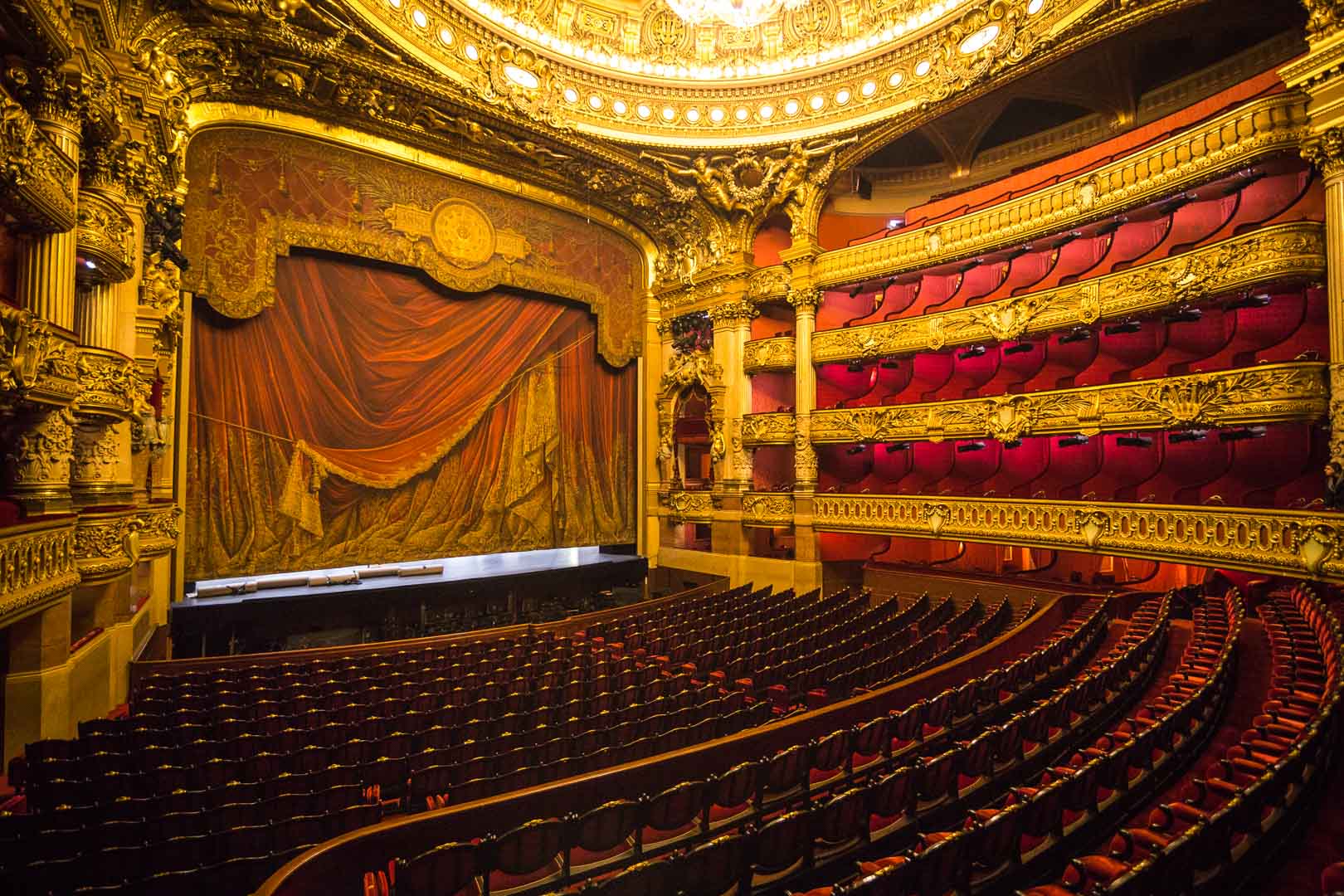
The Auditorium is one of the largest in the world: it can host 1,979 people, and more than 450 artists on the stage.
More than the sheer size of the Auditorium, what really struck me was how luxurious it is. Everything is covered in red velvet, marble, and gold leaves.
The Opera Garnier curtain on the stage was painted in trompe-l’oeil style to represent a draped curtain.
Did you know? The Auditorium was made for people to see the stage, but also to see the other people. It was a popular thing to do back in the days: you came to look at people.
Just as the Grand Escalier, the Auditorium is impressive when you look up, starting with the chandelier. The chandelier, made of bronze and crystal, weighs no less than 7 tons, and is 8 meters high by 5 meters wide (26×16 feet).
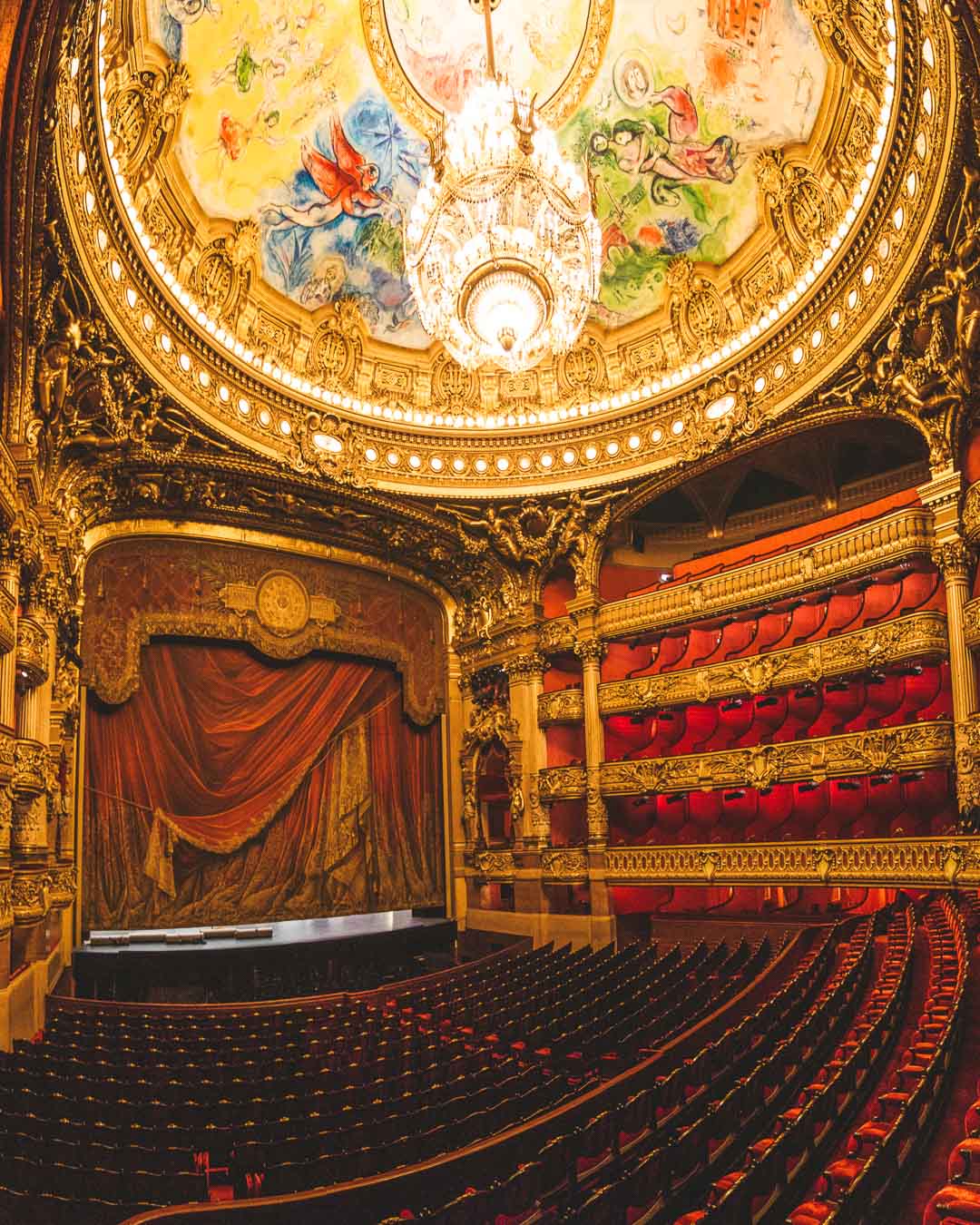
There is a famous story around the Chandelier: one of the counterweight snapped and fell through the roof, killing one of the spectators. The story inspired the Fantôme de l’Opéra novel.
Above the chandelier, you can see the beautiful ceiling, painted by Marc Chagall in 1964, as asked by André Malraux, Minister of Cultural Affairs.
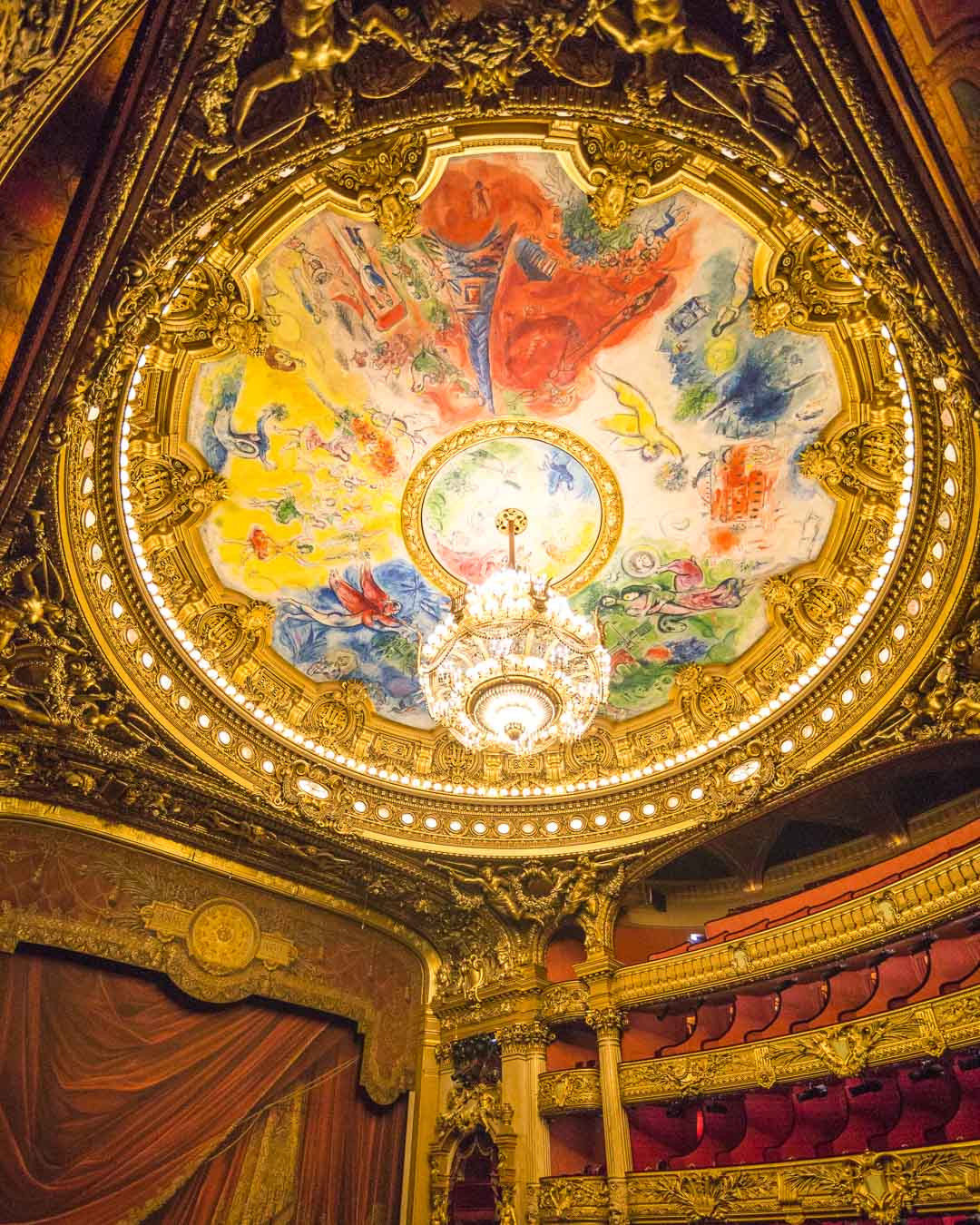
It’s deemed by many as an insult to the overall style of the Opera Garnier, as it clashes with the neo-classical art that you can find in the Palais Garnier.
The third interesting thing to see inside the Opera Garnier is probably my favorite. The Grand Foyer is a massive hall, similar to the ones you can find in Renaissance-style buildings (Château de Versailles or Musée du Louvre for example).

The first thing that struck me is that, as everything in the Palais Garnier, the Grand Foyer is massive. 18 meters high (60 feet), 154 meters long (505 feet) and 13 meters wide (42 feet). Yup, that’s massive!
The hall is made even more impressive with the huge mirrors on one side, and the huge windows on the other. It’s absolutely grand with the daylight coming in through the high windows and lighting up the interior.
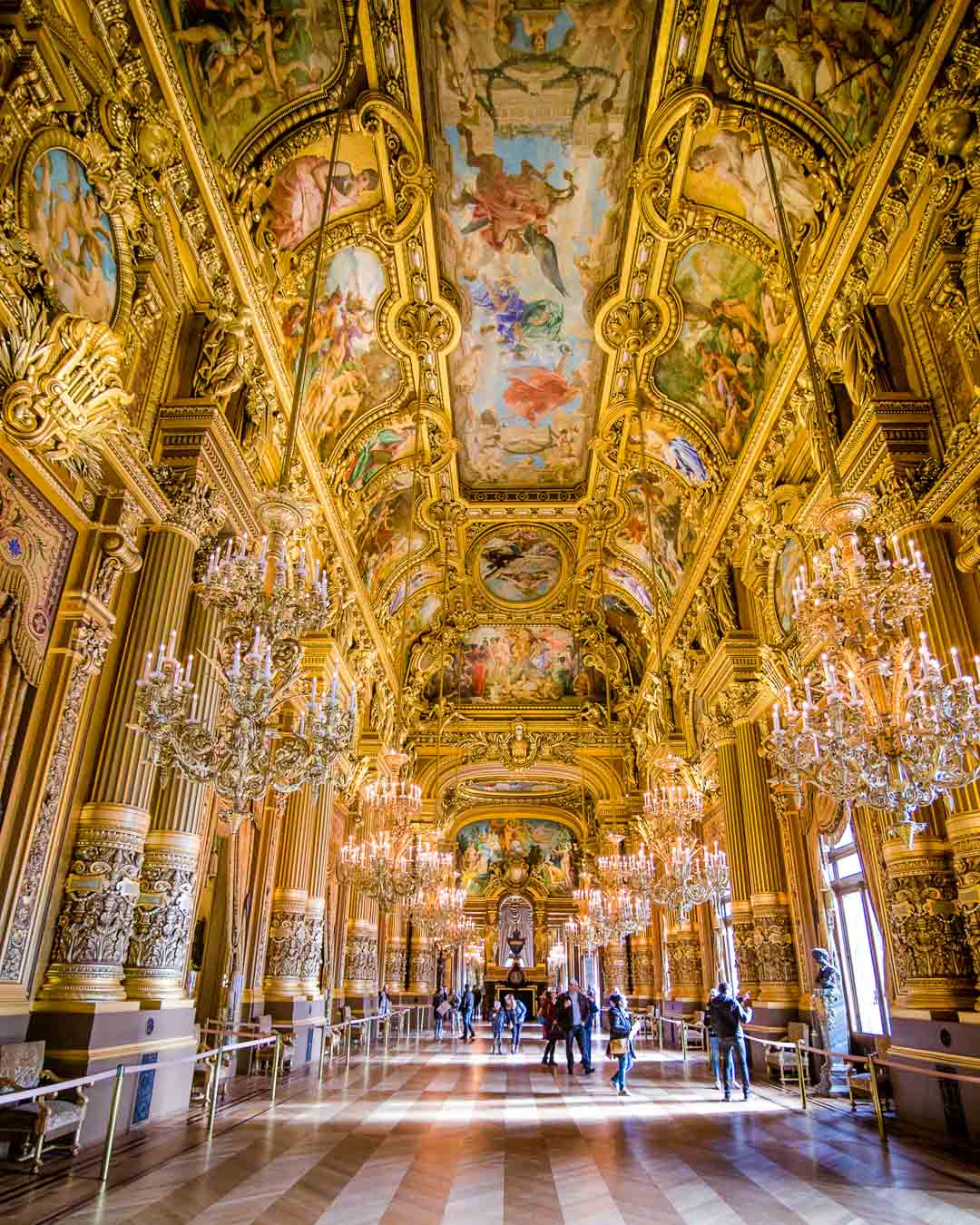
Do you know what else is spectacular in the Grand Foyer? Well, you’ve probably guessed it by now: the ceiling!
Just like everything else in the Opera Garnier, the Grand Foyer ceiling is a real treat to look at.
On the sides of the ceiling, there are 20 statues, representing the qualities that every lyrical artist needs to possess.
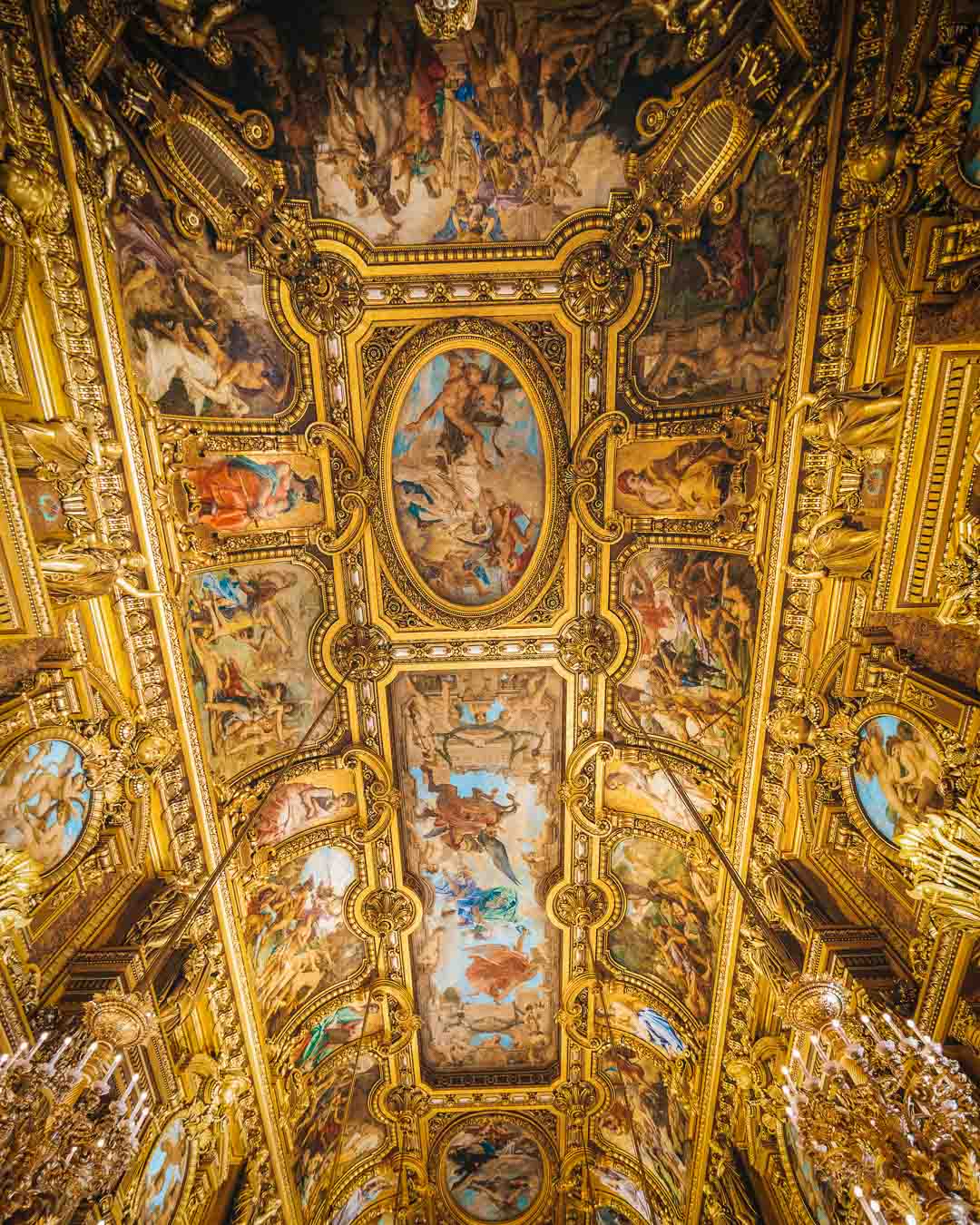
The ceiling is made of a lot of different paintings, by Paul-Jacques-Aimé Baudry. They picture the main events of the history of music, comedy and tragedy.
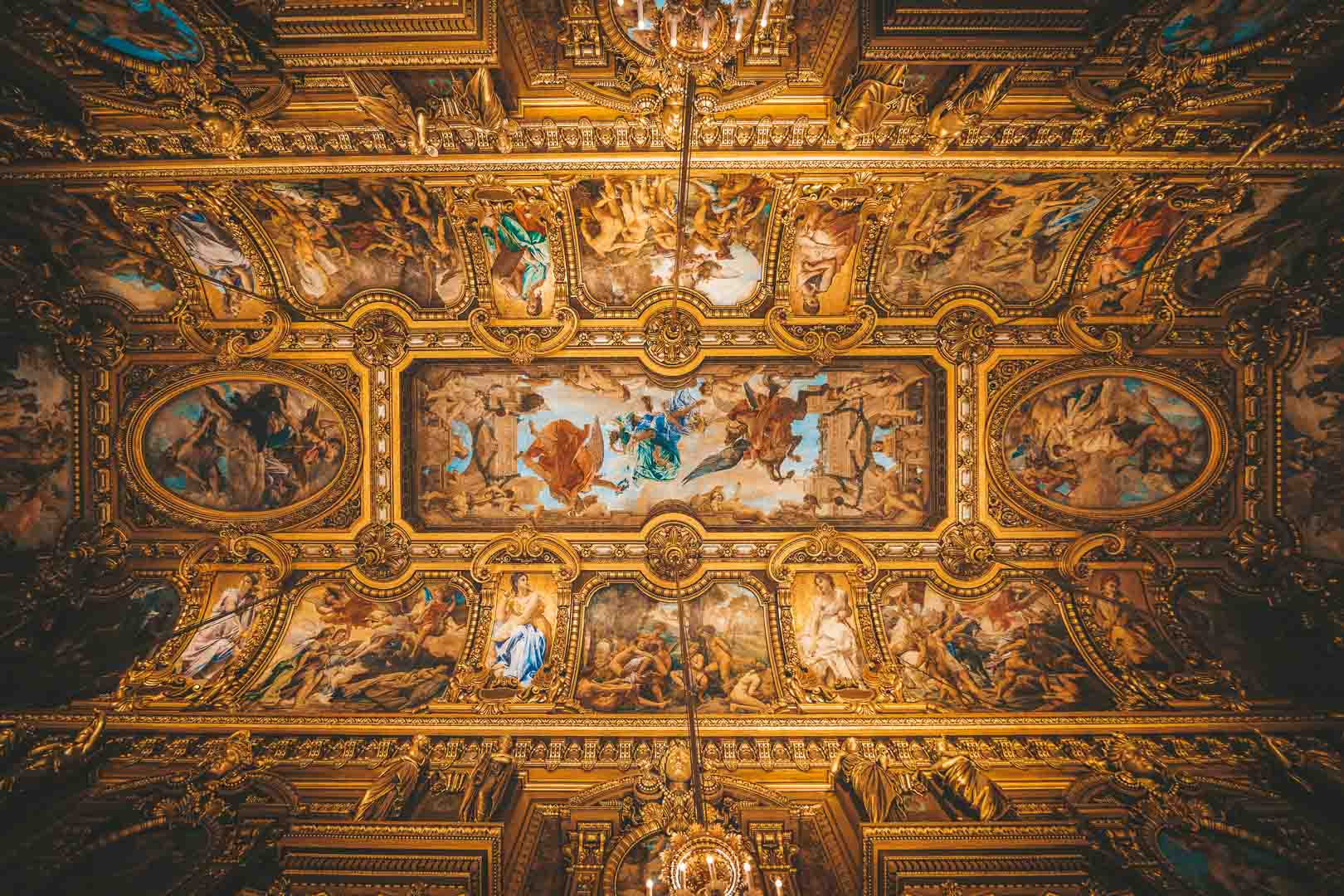
Did you know? The lyre is the main element of decoration in the Grand Foyer. How many lyres can you count?
At each end, the hall leads to 2 salons: the Salon de la Lune (Moon Salon) at the western end, and the Salon du Soleil (Sun Salon) at the eastern end.
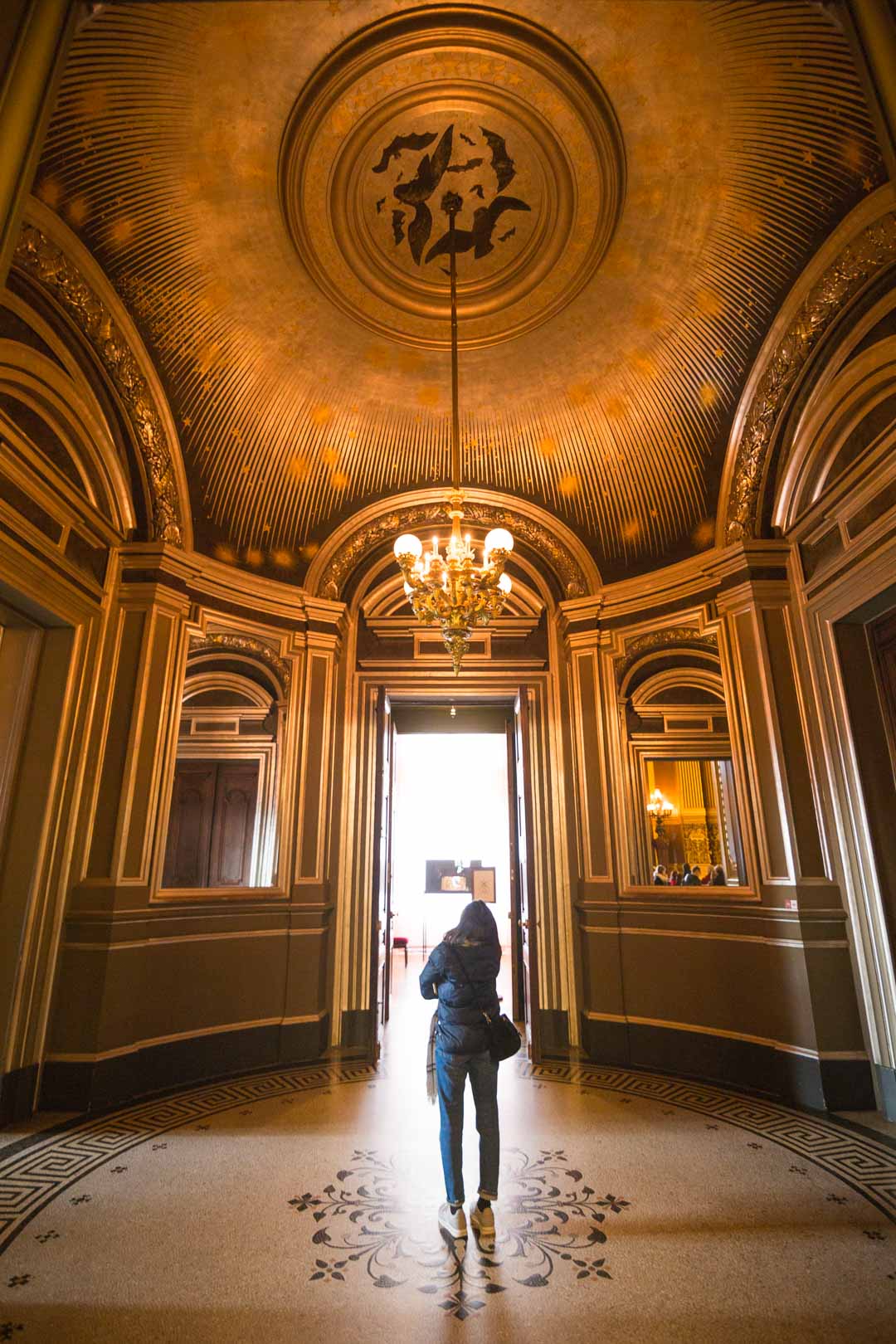
The Paris Opera Library
The 4th incredible thing to see inside the Opera Garnier might not be what you typically expect to find when you think about the Paris Opera. The Opera Garnier has a superb library, the kind that you only see in movies.
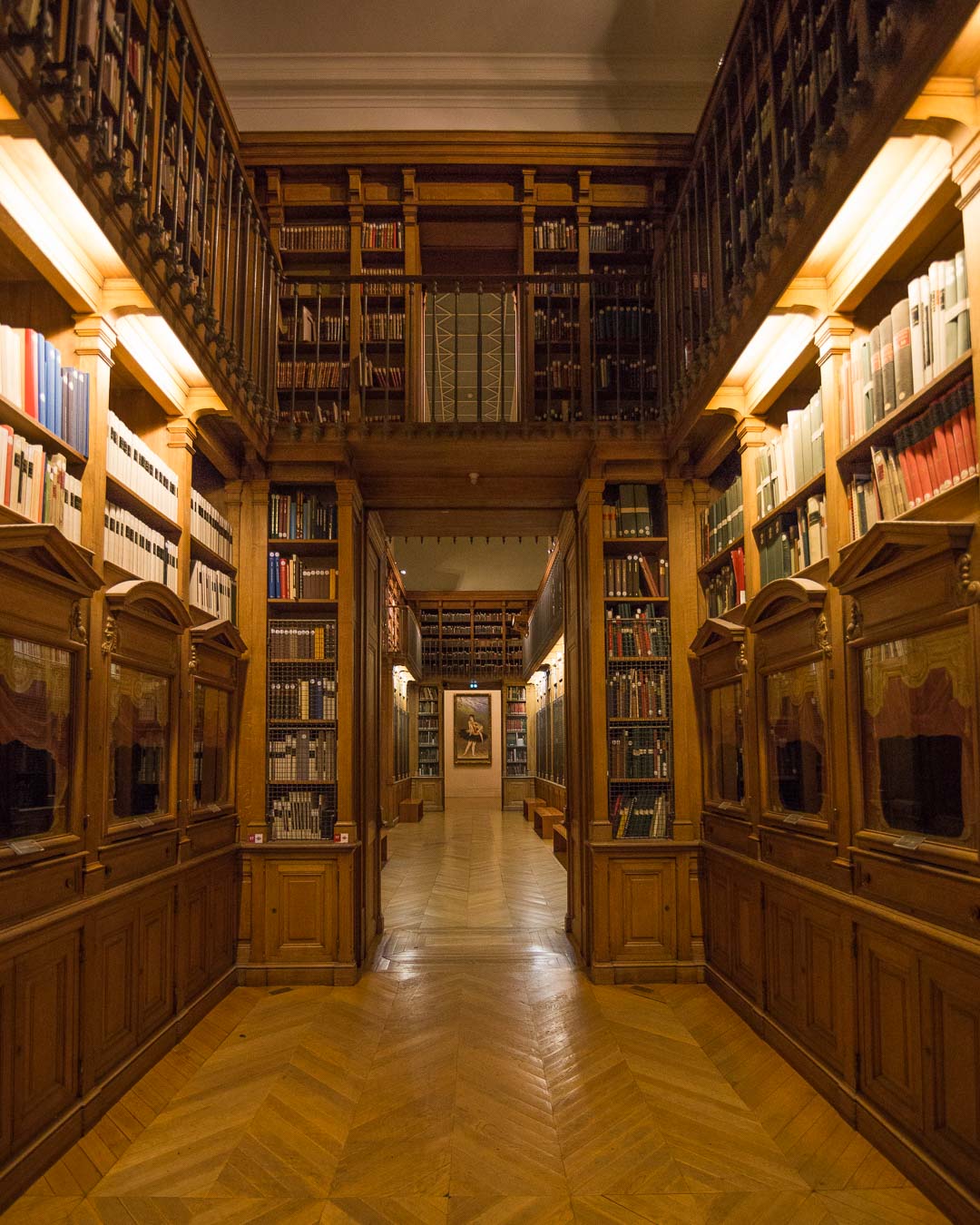
The library is located in another part of the Palais Garnier, named the Rotonde de l’Empereur. This was the private entrance for Emperor Napoleon III. When Napoleon died in 1873, the space was converted into a conservation space, to protect all of the documents held in the library.
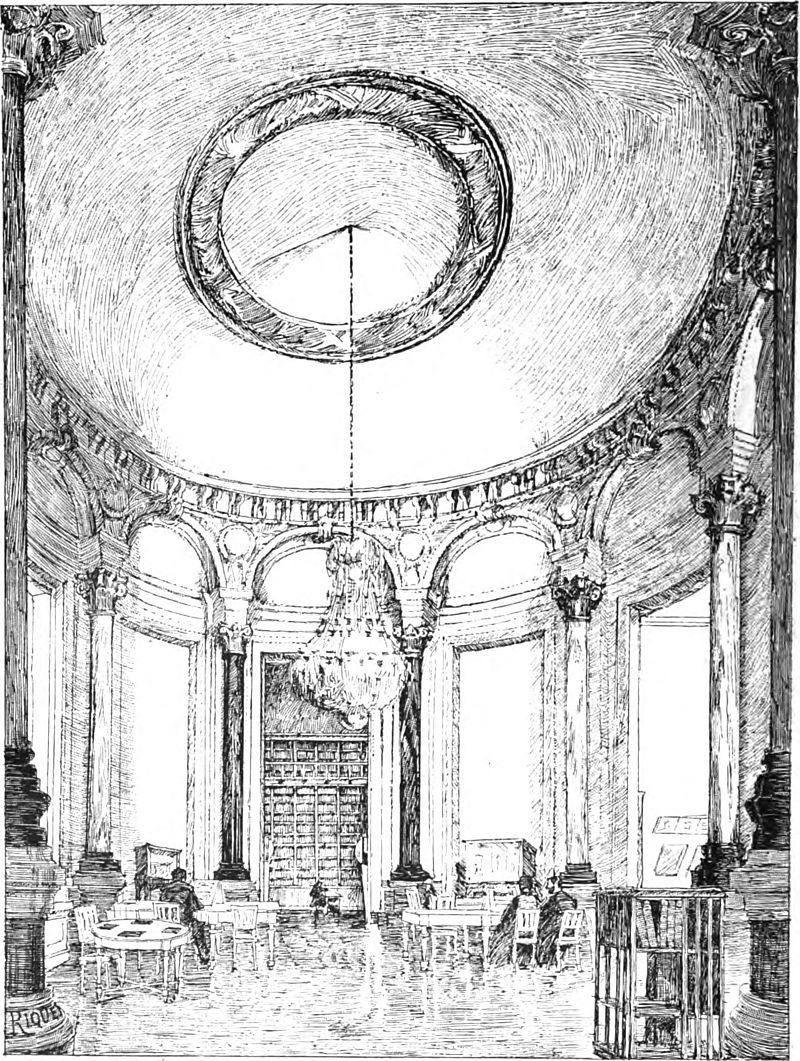
The 3 images above are the three rooms of the Paris Opera Library. The first one is the Lecture Room, the second one is an additional room of the library, and the third is the main hall of the library.
The first and second room are now closed to the public. If you visit the Palais Garnier today, you will only see the third room, the main hall of the library (which is still pretty impressive!). The two other rooms are only accessible by researchers.
Did you know? There are more than 600,000 documents in the Paris Opera Library. Books, newspapers, letters, photographs, …
The Paris Opera Museum
The 5th and last incredible thing to see in the Opera Garnier is also something you wouldn’t expect to find inside the Opera: the Paris Opera Museum.
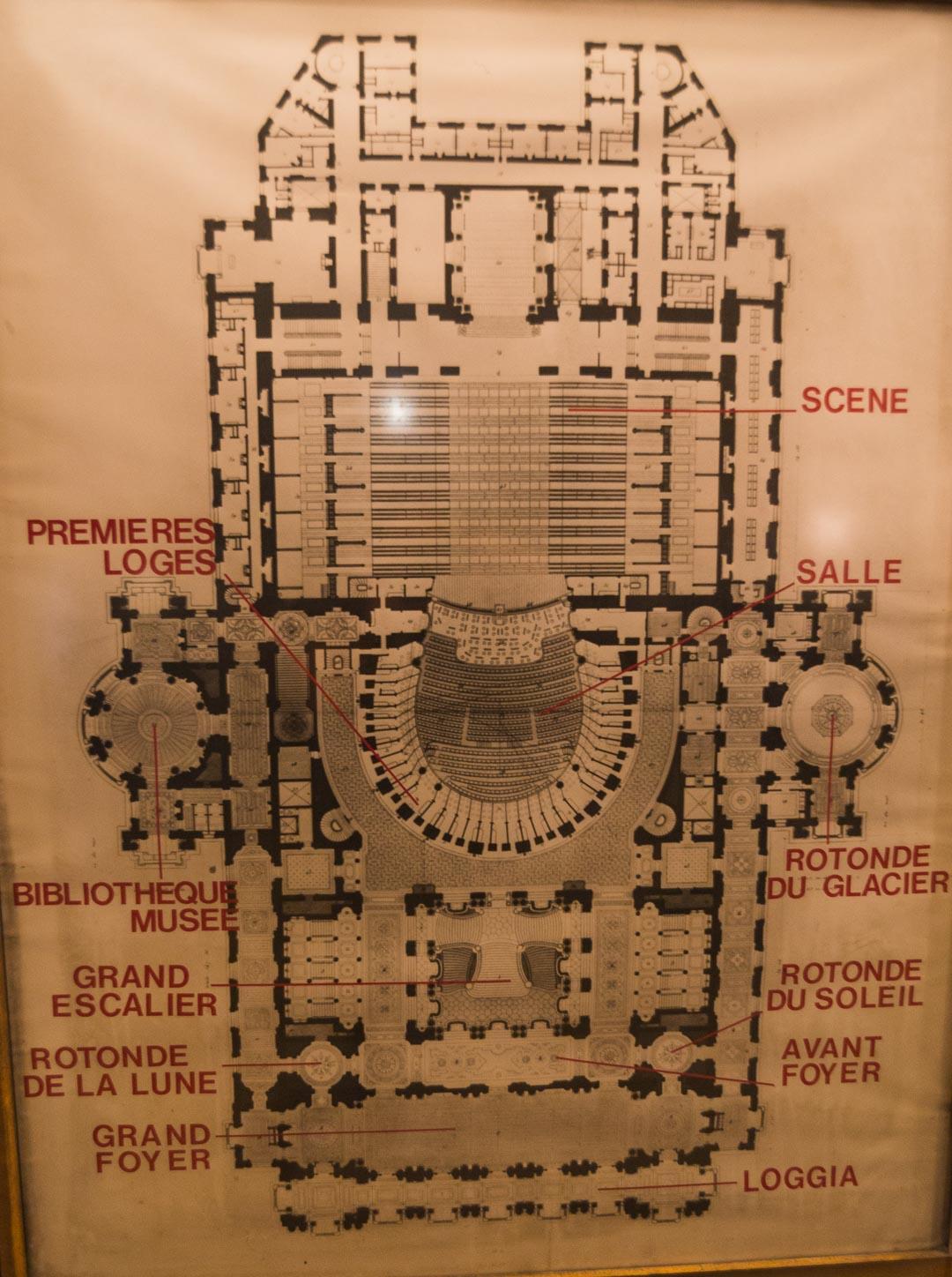
If you have the slightest interest in history or arts, you’ll absolutely enjoy the museum. The museum is rather small, with only 5 rooms, but it holds more than 3 centuries of the Opera Garnier.
Among the 8,500 objects in the museum collection, you’ll be able to see costumes used in representations, with the corresponding jewelry.
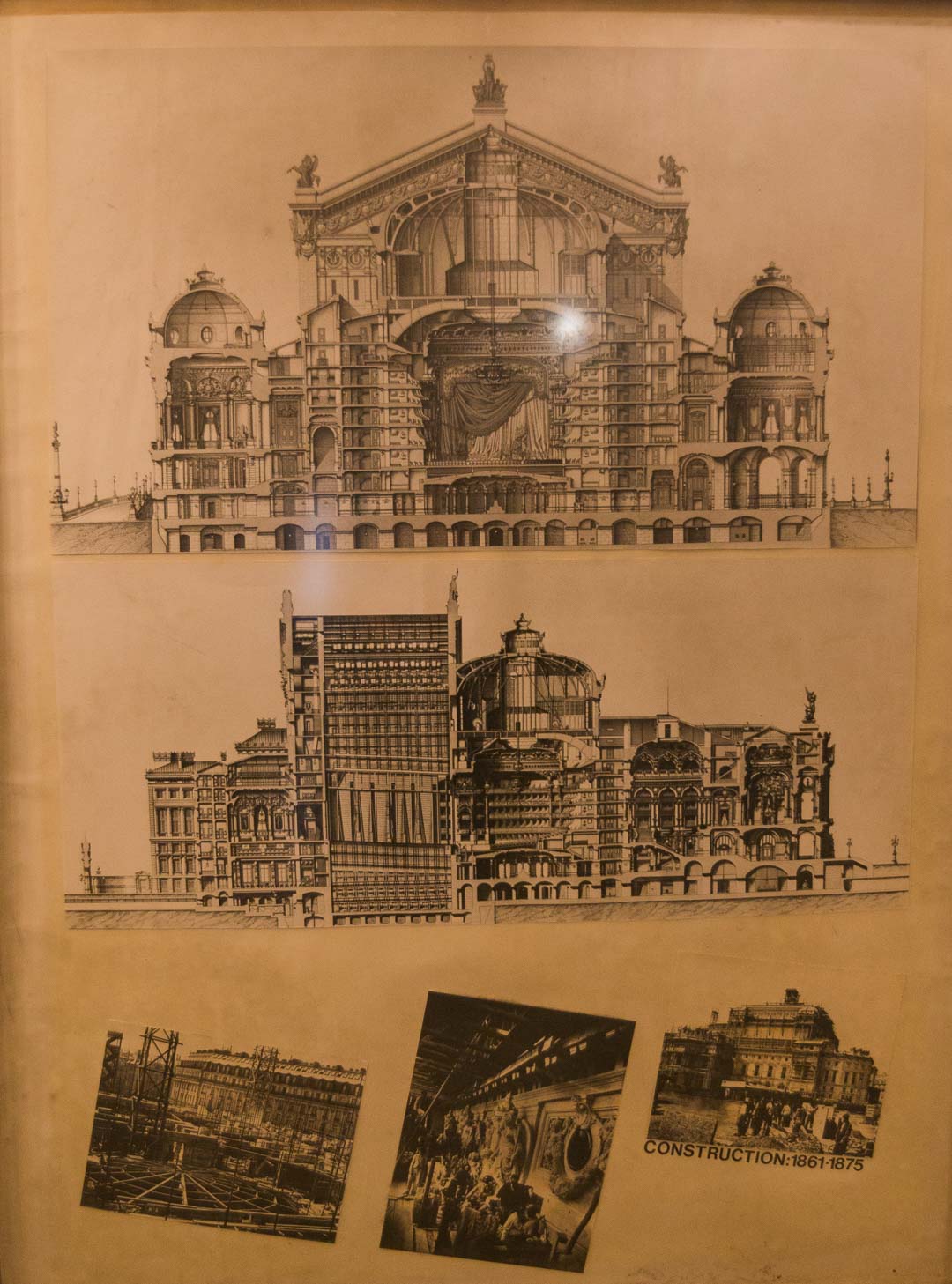
You’ll also see beautiful paintings, such as a painting of one of the painter, painting while wearing a full suit (so classy!).
One other piece that I really liked in the museum was the first version of the Auditorium ceiling, at a smaller scale.
That concludes the list of the 5 incredible things you can find inside the Opera Garnier! Keep reading for more information about the Paris Opera to help you plan your visit, such as opening times, booking information, prices, tips, and what to visit next.
To visit the Opera Garnier, you’ll have to purchase a ticket.
Unlike many other monuments in Paris, there is no free admission for youth under 26 years old.
The tickets for visiting the Opera will cost:
- free for children under 12 years old
- 7€ for 12-25 years old
- 11€ for adults
You can buy your tickets directly at the Opera. After going through security, you can go to the ticket booth and buy your tickets there.
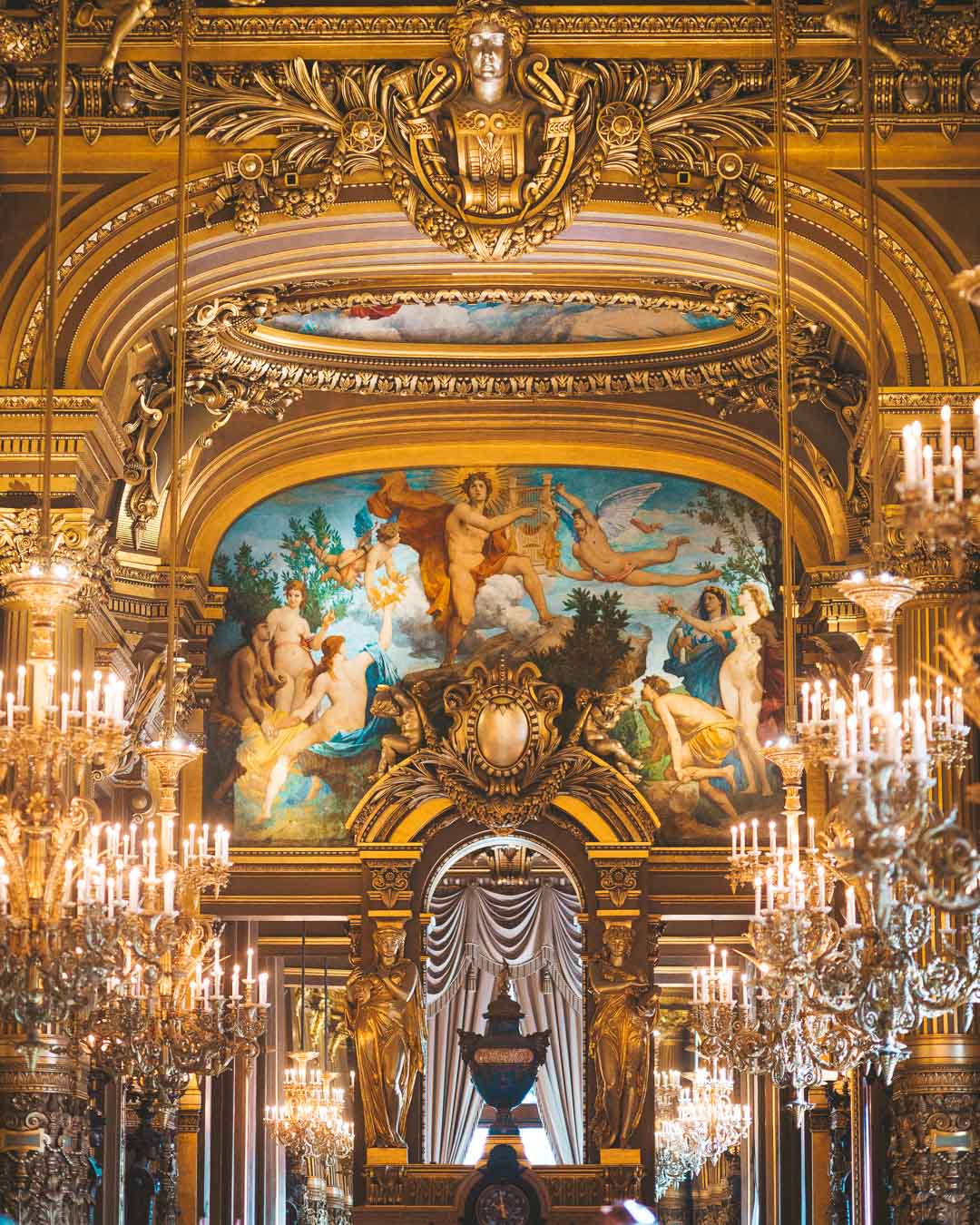
My tip for your visit to the Opera Garnier is to book your tickets online prior to the visit: this way, you’ll avoid having to queue up to buy your ticket, and save a ton of time.
To book your ticket online, click here: Book Opera Garnier ticket
The Opera is open every day, from 10am to 5pm. Last entrance is at 4:30pm
Be careful! The Opera has 29 special days in the year:
- it’s closed 10 days in the year
- it closes at 1pm 15 days a year
- and is closed until 2pm 4 days a year
You can find out the exact days here: Opera Garnier closing days
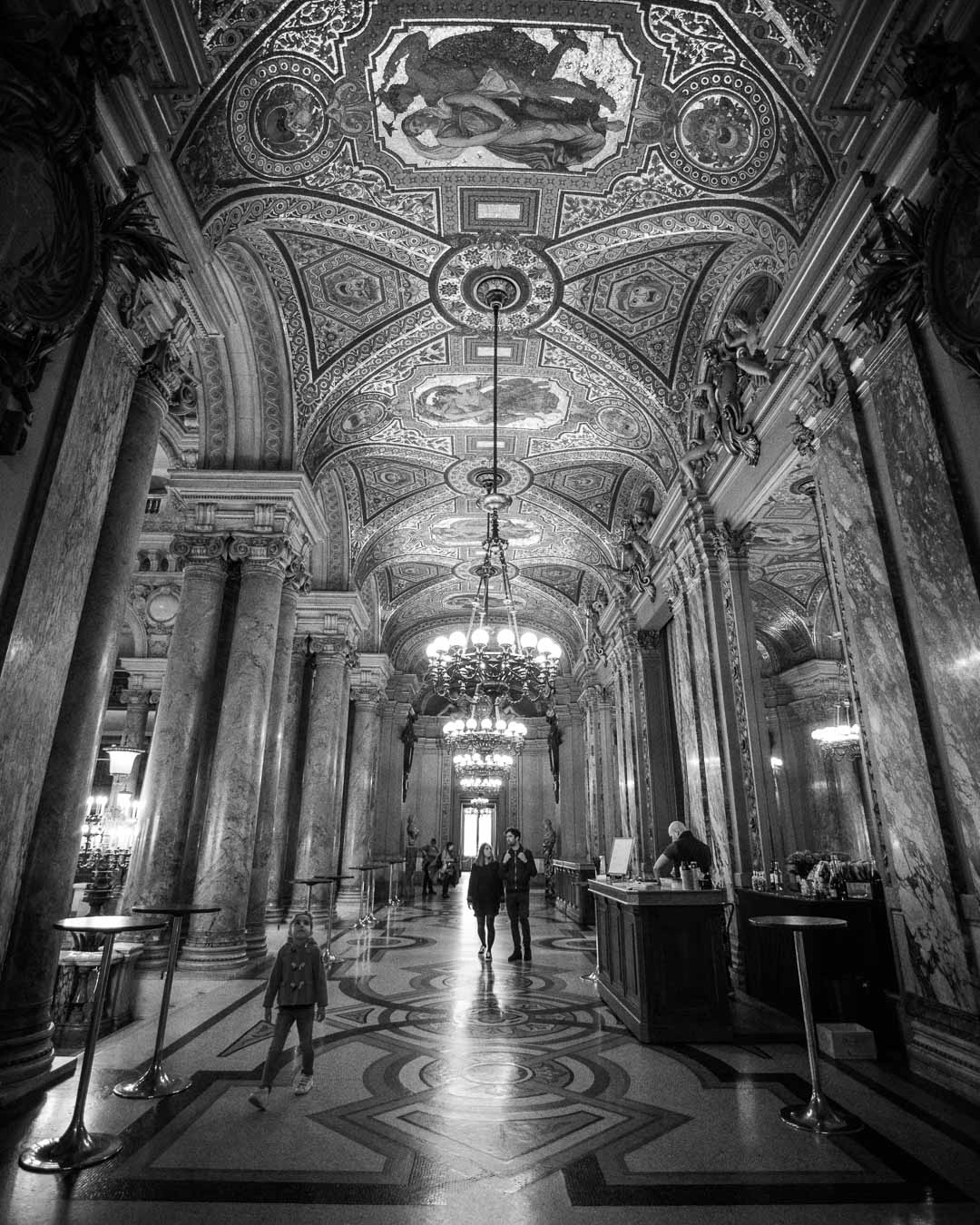
Are you planning to visit the Opera Garnier soon? Well, then you can find below some tips to best prepare your visit, and to make sure you have a wonderful time there 🙂
- book your tickets online: save yourself the hassle of having to queue inside the Opera to buy your tickets. Simply book your tickets online, and you’ll be good to go
- research closing days : before booking your tickets, make sure that the Opera will be open on the day you’re planning to visit. Check above the Opera Garnier opening hours and the closing days to make sure you won’t go all the way in front of the Opera only to learn that it’s in fact closed
- look up ! The ceilings of the Opera are beautifully decorated, and the chandelier are breathtaking; so remember to look up during your visit
You need in average 1 hour in the Opera, to fully visit every part. After you’ll visit, you’ll probably have a lot of time to visit more attractions and try fun things in Paris .
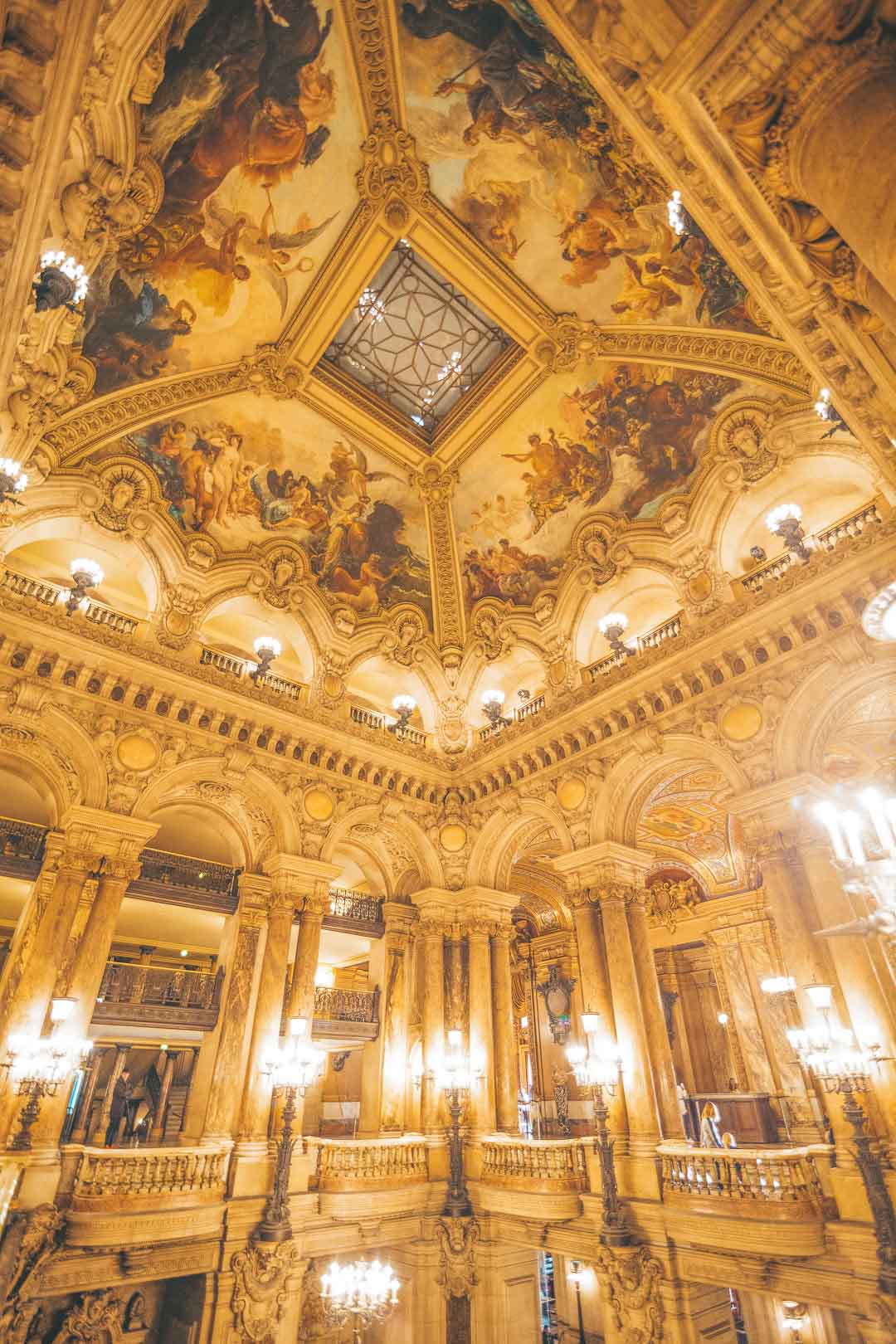
In the same area, there are plenty of incredible things to see.
For rainy days, or if you want to go inside, you can go to:
- Galeries Lafayette – 5 minutes walk
- Eglise de la Madeleine – 10 minutes walk
- Eglise Notre-Dame de Lorette – 12 minutes walk
For sunny days, or if you’d rather be outside, you can explore:
- Place Vendôme – 10 minutes walk
- Palais-Royal – 13 minutes walk
- Jardin des Tuileries – 15 minutes walk
So there you have them, the 5 incredible things to see inside the Opera Garnier in Paris! I hope you found this guide helpful, and that you’ll enjoy your visit to the Opera Garnier.
Do you have any questions about your visit to the Opera Garnier? Or to any other place? Ask me in the comments, I always make sure to reply!
If you take any photos during your visit and post them to Instagram, tag them with #kevmrctravel so that I can see them!
Travel Tools
Use any of our recommended links below to book your trip. You pay the same, and we earn a small fee; a great way to support us!
- Find the Best Hotels
- Find a Rental Car
- Insure Your Trip
- Book Your Activities

Pin this to Pinterest!
Enjoyed this guide? Then help a fellow traveler and pin it! They'll most definitely love you for it, 100% guarantee.
Pin It Now Follow Me on Pinterest
Hey, I'm Kevin

I'm a professional photographer, with over a decade of experience in the travel industry. I worked with countless travel brands, and my travel advice has been featured in major publications such as CNN, Forbes & the New York Magazine. But the best travel advice is definitely found here on my website! I'm all about adventure travel, hiking and exploring the outdoors - even if I often find myself exploring cities with my wife Nesrine. If you have any questions, leave a comment on this post or reach out by email at: [email protected]
Come say hi on social!
Countries I've visited
Recommended Reading
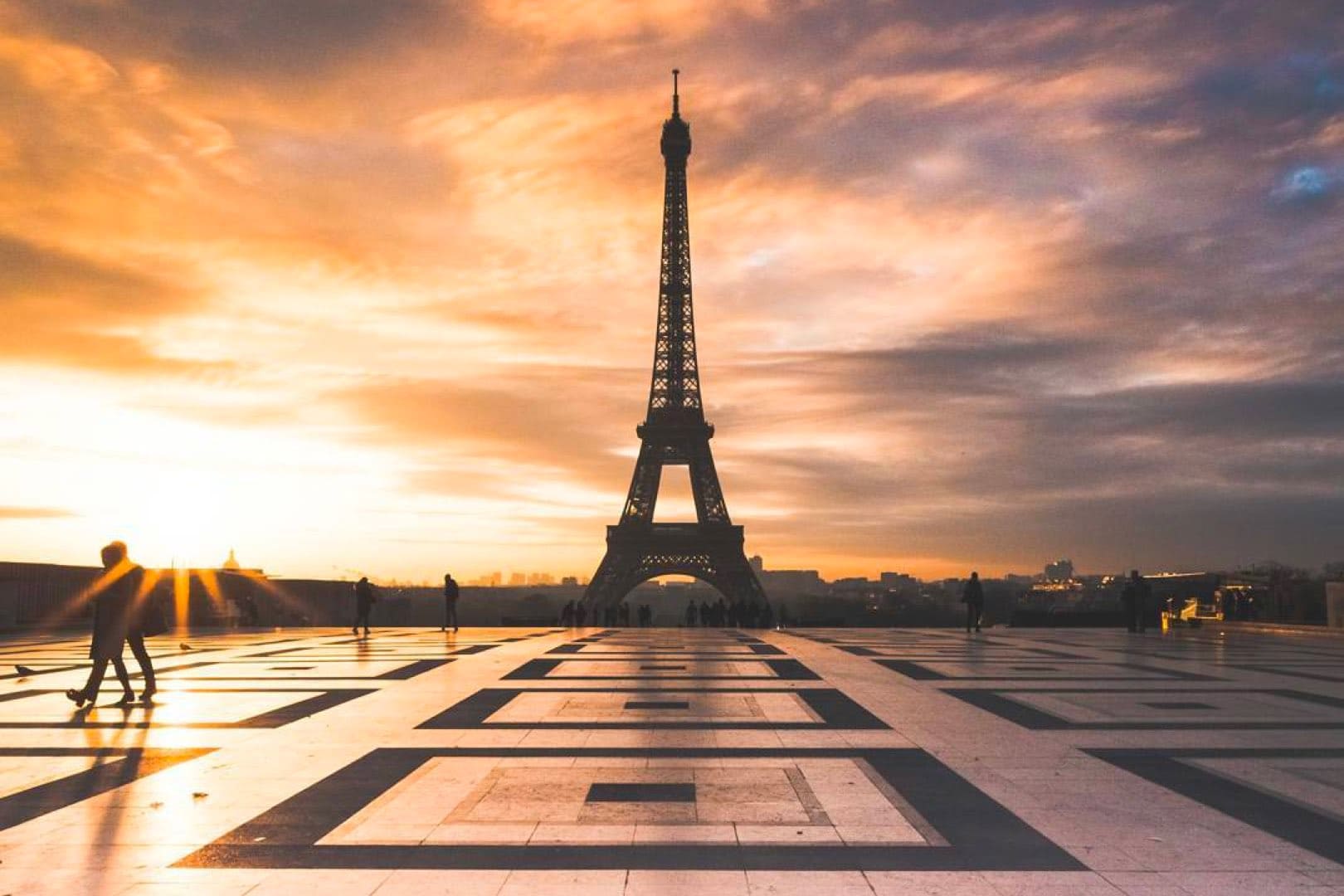
No, I didn’t know that inside was so beautiful. I’ve admired the opera house passing by because there are so many things to see in Paris and we didn’t have that many days. We nearly booked tickets but it was sold out. Looking at your beautiful photos it’s like I’ve now been a bit inside. I do hope that life will give you your dream.
Leave a Reply Cancel reply
Your email address will not be published. Required fields are marked *
Notify me when new comments are added.

Opéra et Grands Boulevards : notre guide complet pour visiter le quartier haussmannien de Paris
Pour découvrir l’un des secteurs les plus animés de Paris, direction l’Opéra et les Grands Boulevards, un quartier emblématique du Paris haussmannien. Architecture majestueuse, shopping de luxe et soirée au théâtre… Cette visite promet des moments inoubliables !
Que voir et que faire autour de l’Opéra et sur les Grands Boulevards ?
Admirer l’opéra garnier, l’emblème du paris haussmannien.
C’est un monument qui s’admire avec les yeux et les oreilles ! Représentant grandiose du style Second Empire à Paris, le palais Garnier a été édifié par Charles Garnier entre 1860 et 1876, à l’époque où le baron Haussmann transformait la capitale française, à la demande de l’empereur Napoléon III. Aujourd’hui, on peut découvrir l’édifice au cours d’une visite guidée, dans le cadre d’un jeu immersif sur les traces d’Arsène Lupin ou lors d’un spectacle – ballet, concert, récital ou opéra. À ses abords, les beaux monuments haussmanniens ne manquent pas, à l’image de l’Athénée Théâtre Louis-Jouvet, dans le square de l’Opéra-Louis Jouvet, ou de l’imposant Centorial, rue du Quatre-Septembre.
Palais Garnier
Place de l’Opéra
75009 Paris
operadeparis.fr
S’offrir une virée shopping dans les Grands Magasins
À quelques pas de l’Opéra, on plonge dans le grand temple du shopping parisien . Sur le boulevard Haussmann, les Galeries Lafayette et le Printemps sont deux incontournables. À l’image de leurs coupoles respectives, véritables vitraux de lumière composés à la fin du XIX e siècle, leur architecture Art Nouveau est déjà un spectacle en soi. Avant de se perdre dans les rayons de mode, de beauté et de gastronomie, on grimpe jusqu’au rooftop des Galeries Lafayette, au 8 e étage de l’édifice : la vue panoramique sur Paris y est à couper le souffle.
Les Galeries Lafayette Haussmann
40 boulevard Haussmann
haussmann.galerieslafayette.com
Le Printemps Haussmann
64 boulevard Haussmann
printemps.com
Flâner dans les passages couverts
Là encore, c’est un incontournable parisien. Aménagés dès la fin du XVIII e siècle dans le centre de Paris et situés en majorité dans les 2 e et 9 e arrondissements, les passages couverts sont toujours aussi séduisants, avec leurs hautes verrières, leurs boutiques aux mille curiosités et leur décor au charme désuet. Les passages des Panoramas et Jouffroy, vers les Grands Boulevards, et les élégantes galeries Vivienne et Colbert, du côté du Palais Royal, figurent parmi les immanquables.
Faire le plein d’art et de culture sur les Grands Boulevards
De jolies façades, quelques musées, des théâtres et salles de spectacles à n’en plus finir… Entre les boulevards des Capucines et Bonne-Nouvelle, le quartier est un véritable vivier culturel. En famille, on visite le musée Grévin, où l’on peut poser avec des célébrités en cire, avant de pousser la porte du Grand Rex, un cinéma mythique à l’architecture Art Déco et à la programmation familiale ( blockbusters , films d’animation, ciné-concerts). Côté scène vivante, l’offre est pléthorique : de l’Opéra-Comique au théâtre des Variétés en passant par l’Olympia et le théâtre Édouard VII, les lieux ne manquent pas pour assister à une comédie musicale, une pièce de théâtre ou un concert.
Où manger et où dormir autour de l’Opéra et sur les Grands Boulevards ? Nos hôtels et restaurants coups de cœur
Aux lyonnais.
Ici, on rend aux Lyonnais leur statut de capitale française de la gastronomie ! Quenelle, boudin noir, poularde de Bresse… À la tête de cette table centenaire depuis 2023, la cheffe Victoria Boller revisite avec modernité les spécialités de la région lyonnaise.
32 rue Saint-Marc
75002 Paris
auxlyonnais.com
Circonstances
L’objectif de ce bistrot situé tout près du métro Grands Boulevards est simple : concocter une cuisine traditionnelle qui évolue selon le marché, se nourrit d’influences venues d’Asie et se déguste, le soir, en assiettes à partager. On adore !
174 rue Montmartre
circonstances.fr
Hotel Pulitzer Paris
Chic, cosy , au caractère typiquement parisien : voilà comment définir l’hôtel Pulitzer, situé dans un bel immeuble haussmannien du quartier de l'Opéra. Coup de cœur pour Les Petites Mansardes, les chambres pour une personne qui donnent sur les toits du Paris.
23 rue du Faubourg Montmartre
Paris, 75009
hotelpulitzer.com
Hôtel des Grands Boulevards
Installé dans un bel hôtel particulier du XVIII e siècle, l’Hôtel des Grands Boulevards glisse, dans un superbe décor moderne, quelques touches « grand siècle » inattendues (lit à baldaquin, heurtoirs anciens, marbre). Aux beaux jours, dans le restaurant-patio ou sur le bar- rooftop , on déguste une délicieuse cuisine franco-italienne signée Giovanni Passerini.
17 boulevard Poissonnière
Paris, 75002
grandsboulevardshotel.com

© Jean-Pierre Delagarde / OnP
Theaters and Workshops Palais Garnier
Theaters and Workshops : Palais Garnier
Designed by architect Charles Garnier in 1875, the Palais Garnier hosts a prestigious auditorium and various public areas (grand foyer, rotonde des abonnés, lounges), as well as a museum-library and different rehearsal studios and workshops.
The Italian-style auditorium, with its ceiling painted in 1964 by Marc Chagall, can welcome 2054 spectators. With nearly 480,000 visitors each year, it is one of Paris' most visited monuments. It has been listed as a historical monument since 1923.
Visit the Palais Garnier
Discover the treasures and secrets of this 19 th -century theatre architecture’s masterpiece.
Discover the different areas
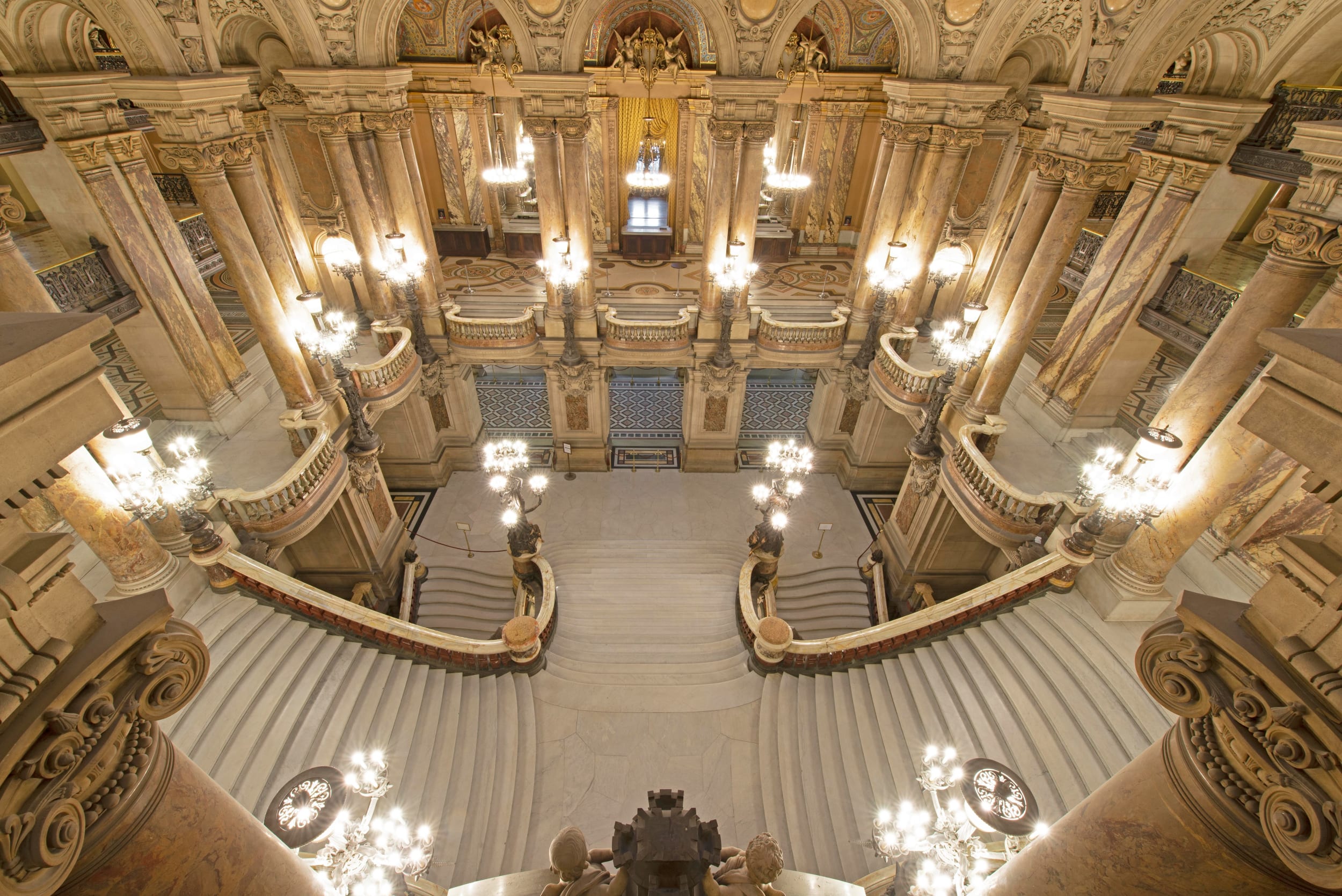
THE GRAND STAIRCASE
The grand staircase alone is a showplace, where everyone can see and be seen from the balconies.
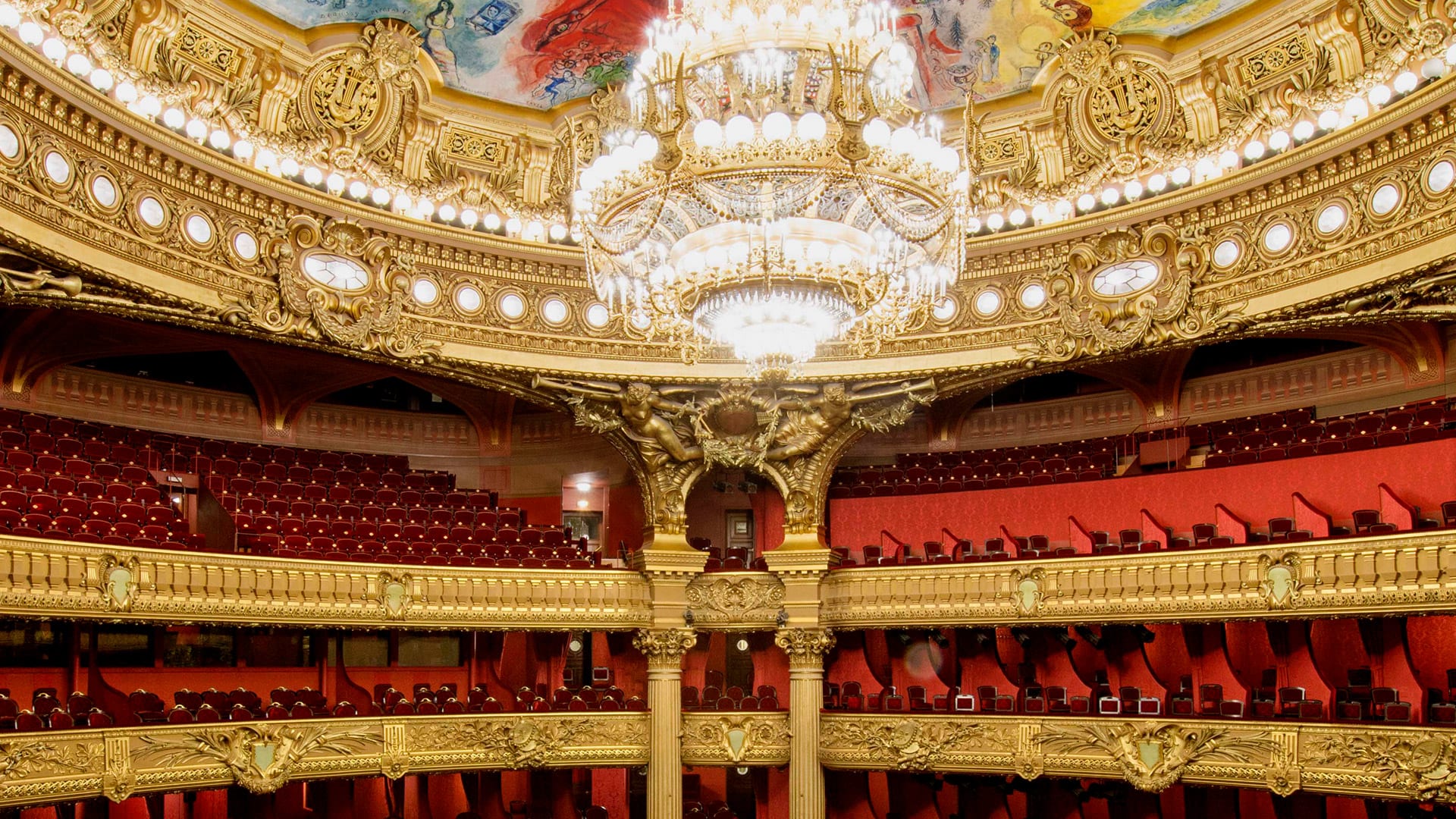
THE AUDITORIUM
Charles Garnier selected a red velvet fabric to cover the seats and the walls of the boxes, a material known to highlight a woman’s complexion.
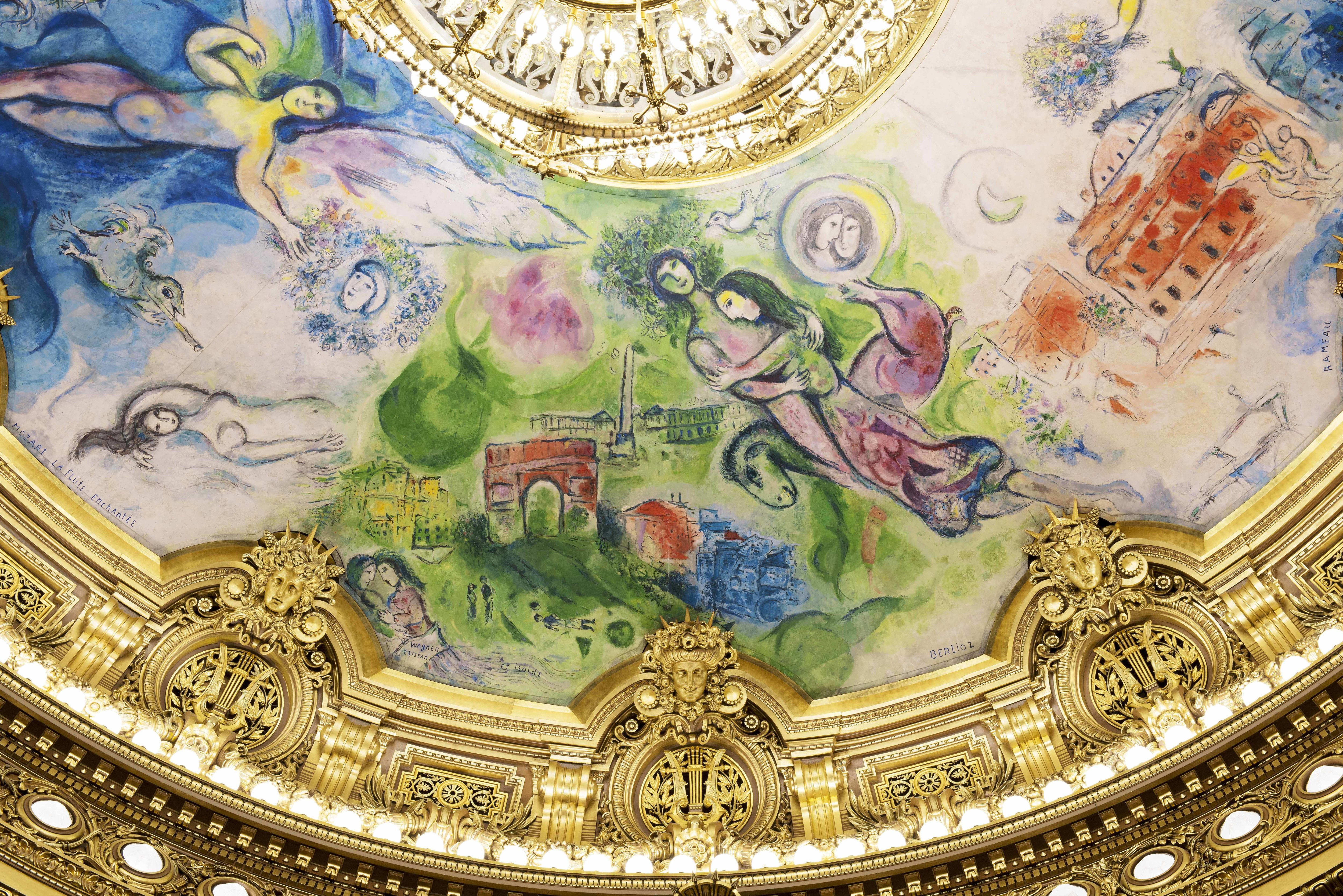
MARC CHAGALL’S CEILING
Marc Chagall’s huge canvas is a tribute to famous musicians, opera or ballet composers.
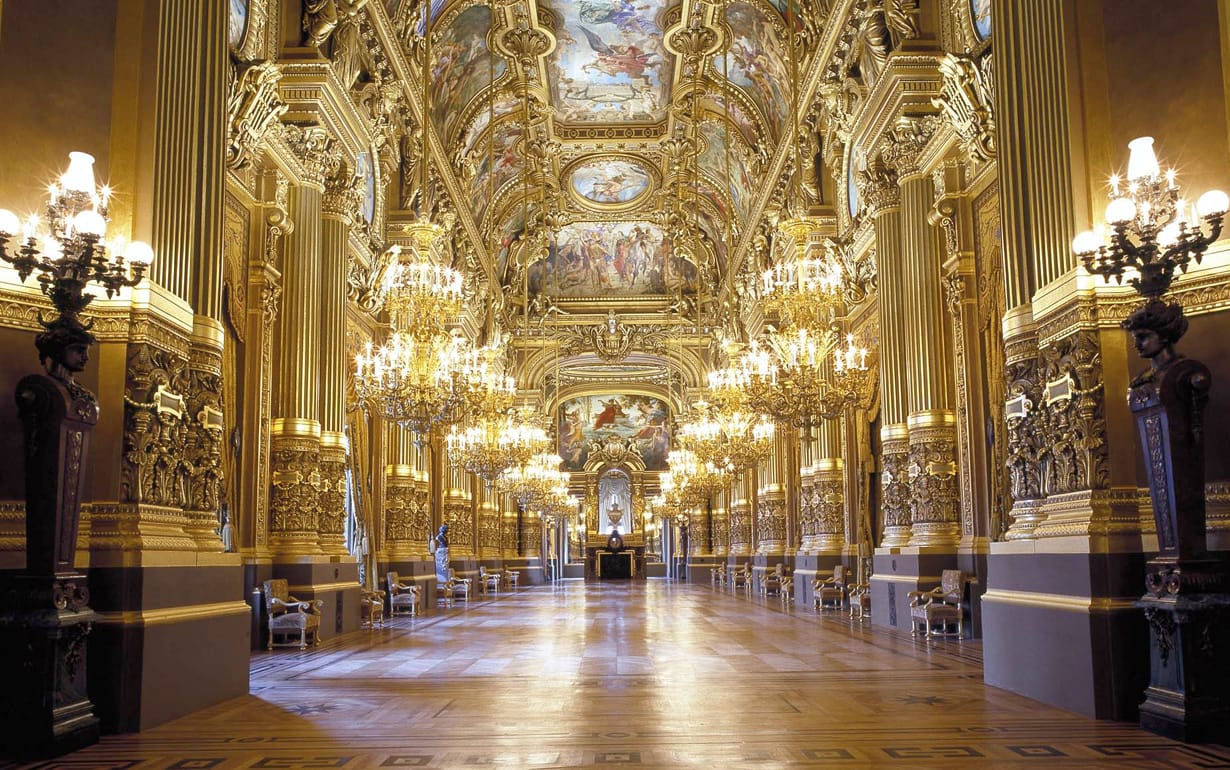
THE GRAND FOYER
This wide room was imagined as a space to walk around and meet other spectators during the intermissions.
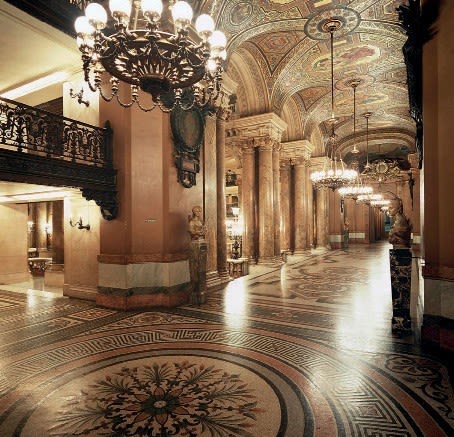
THE AVANT-FOYER
The avant-foyer is a long gallery whose ceiling is covered with golden mosaics. Sculptures represent the different trades that took part in the construction and decoration of the Garnier Opera.
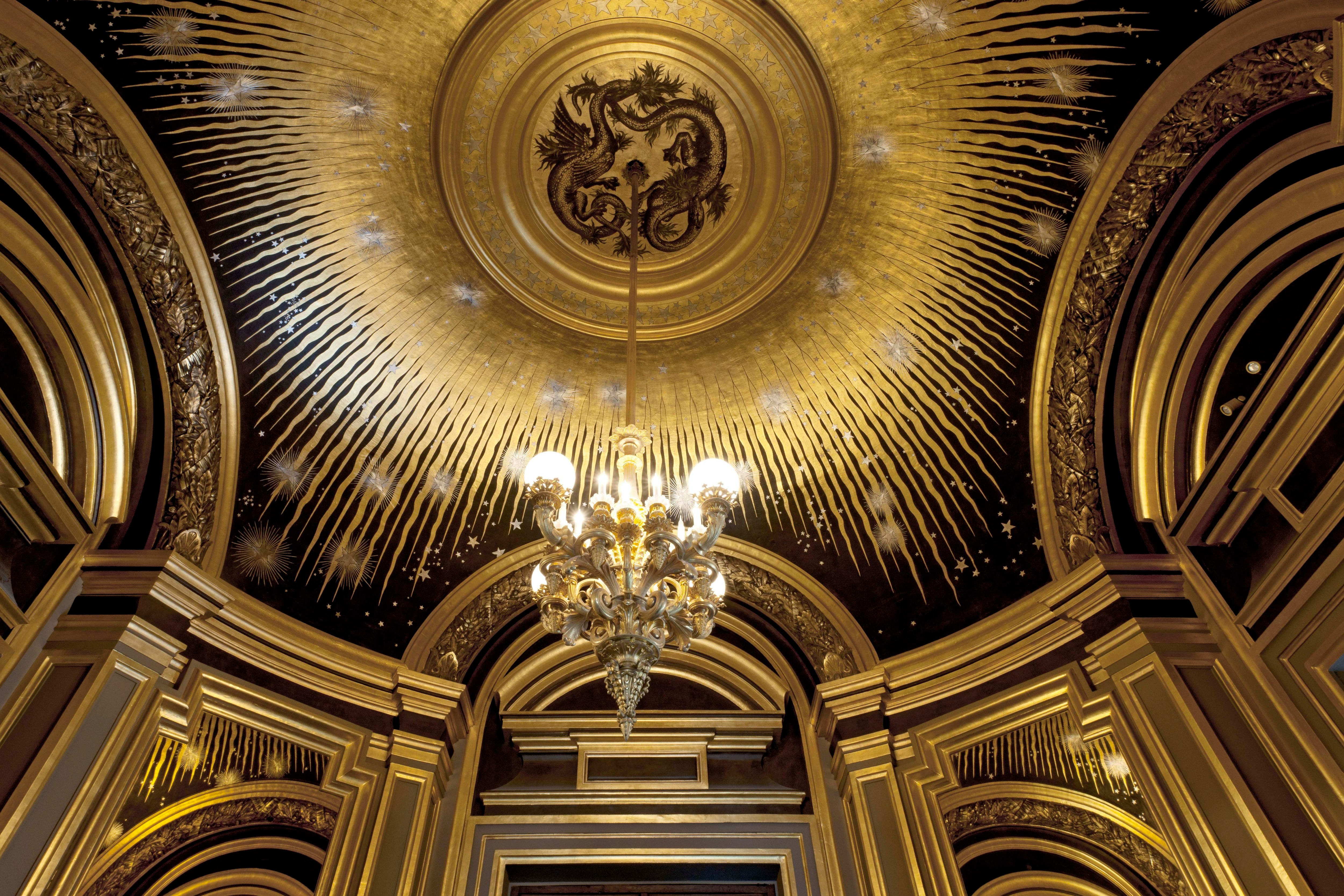
THE SALON DU SOLEIL
The “Sun Lounge” is black and gold. On the ceiling are featured a dragon and a salamander.
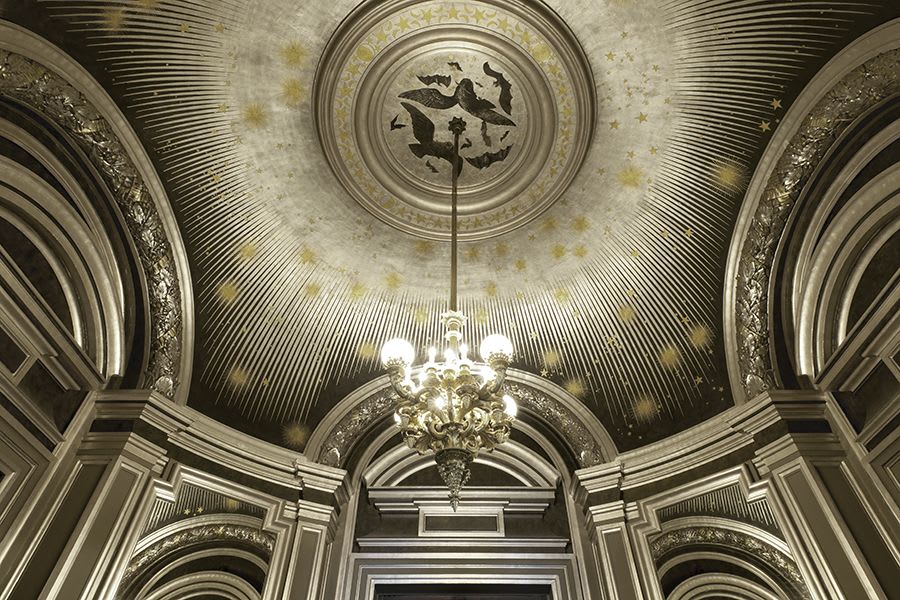
THE SALON DE LA LUNE
The “Moon Lounge” is black and silver. On its domed ceiling are painted nocturnal animals (owls and bats).
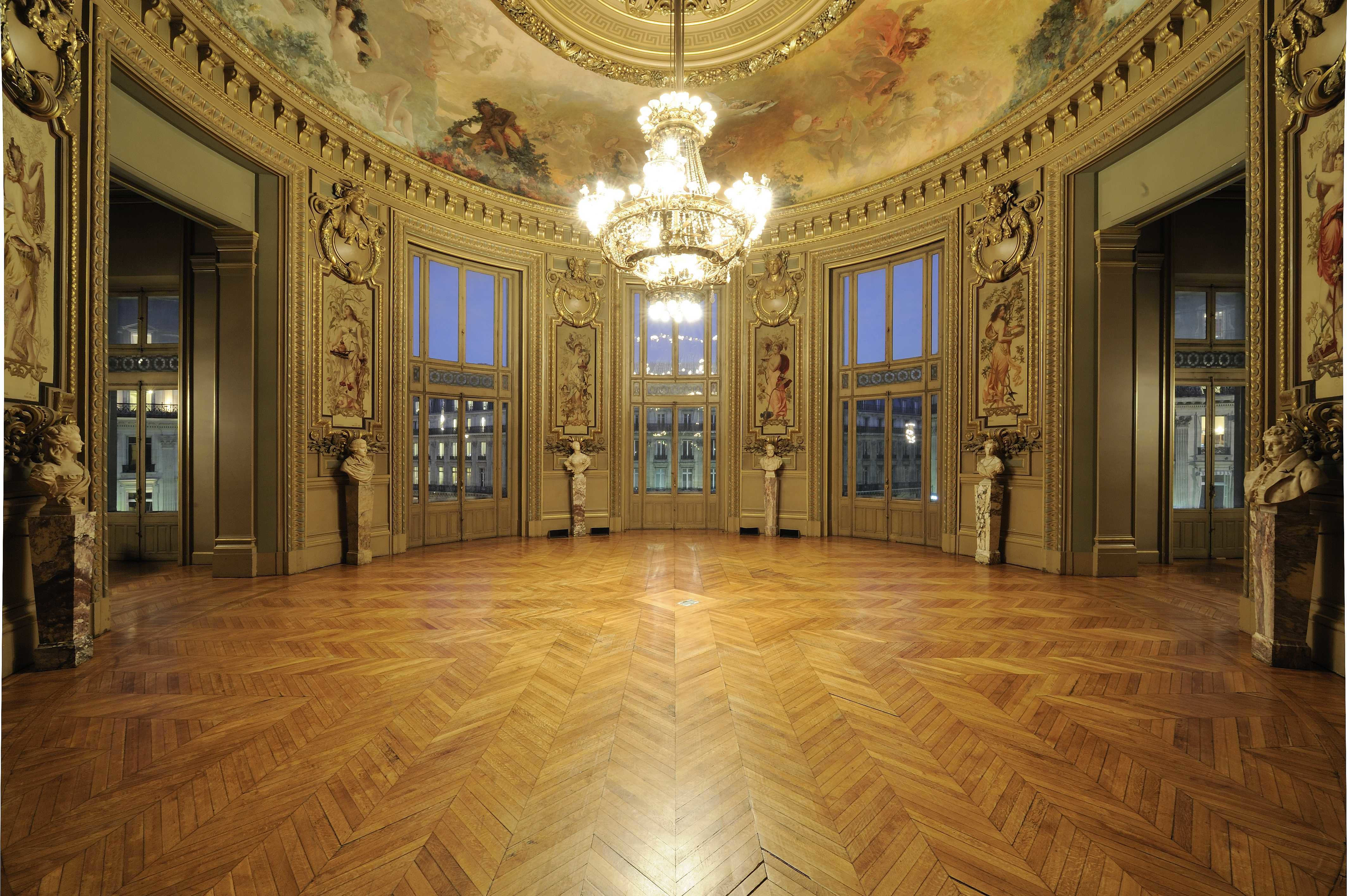
THE SALON DU GLACIER
Completed after the opening of the Palais Garnier, this lounge evokes the style of the Belle Époque. During intermissions, spectators could enjoy various refreshing drinks and pastries.
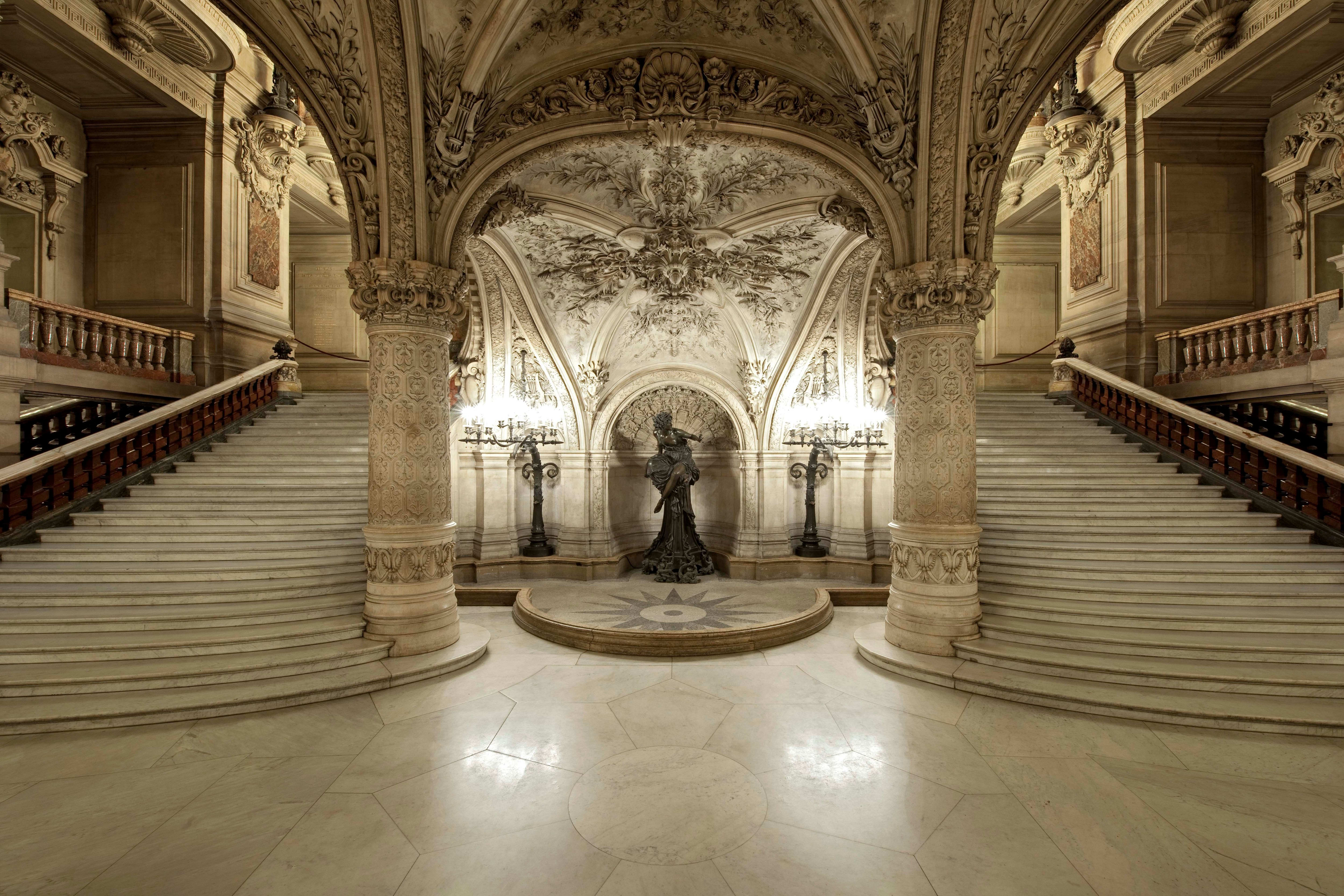
THE BASSIN DE LA PYTHIE
Once you have passed the “Rotonde des abonnés”, the bassin de la Pythie will lead you to the grand staircase and sumptuous 30-metre-high nave.
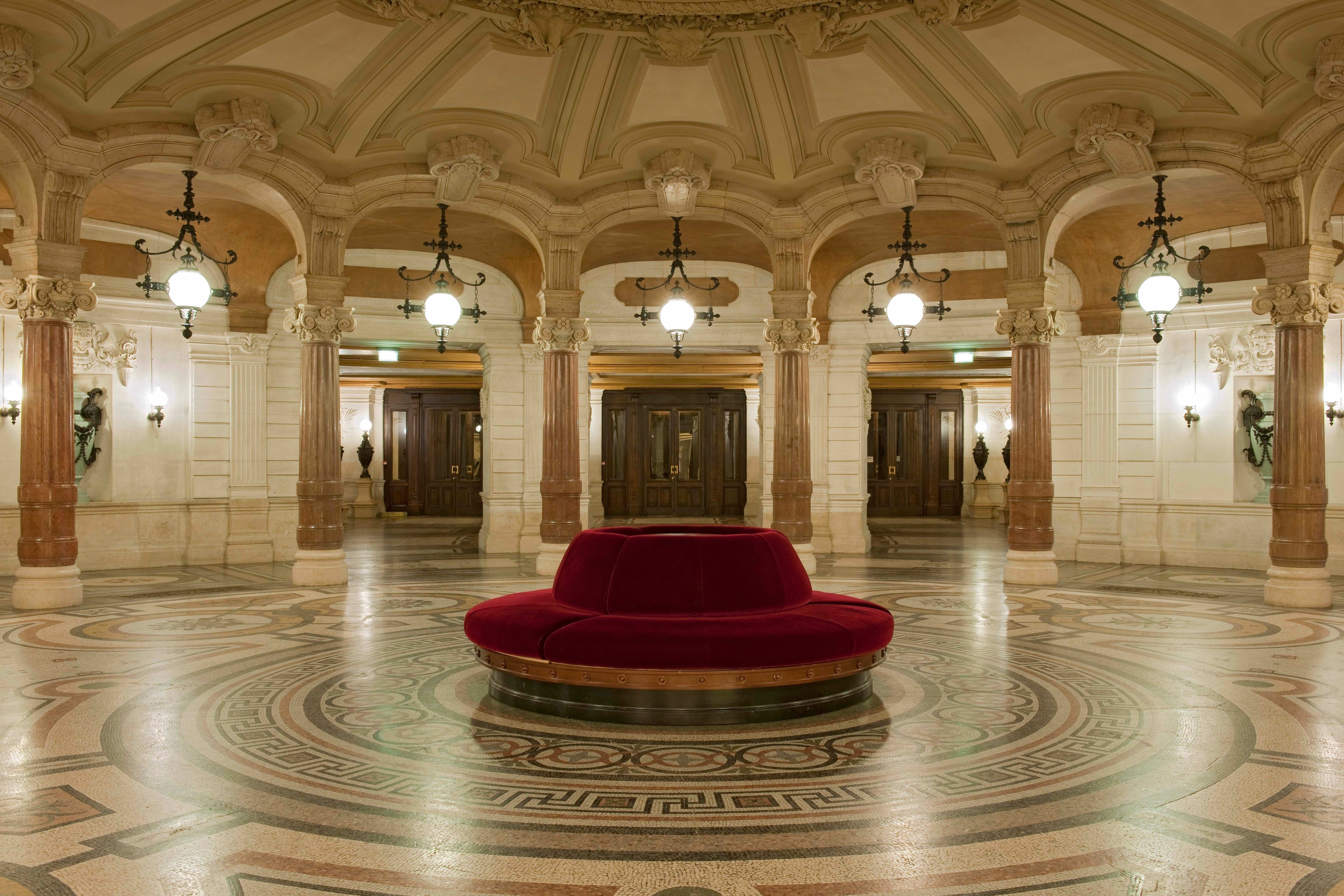
THE ROTONDE DES ABONNÉS
This circular lobby was formerly reserved for members, who would access it through the entrance on the Eastern side of the building, now hosts the Opéra Restaurant.
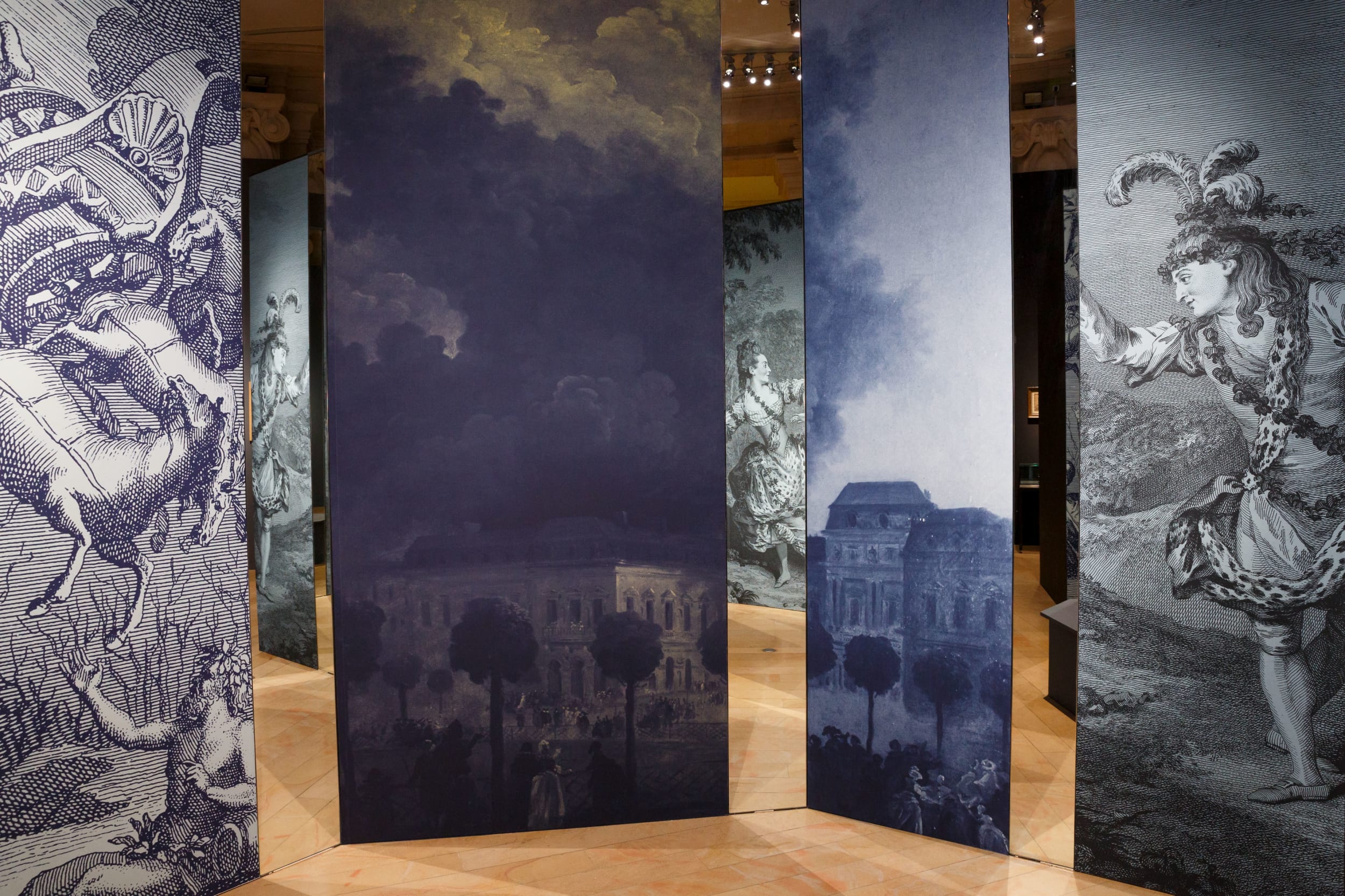
THE LIBRARY-MUSEUM OF THE OPERA
The collections of the Library-Museum of the Opera have been preserving the memory of the theatre for three centuries. The gallery of the museum permanently showcases paintings, drawings, photographs and models of decorations in volume.
The construction works
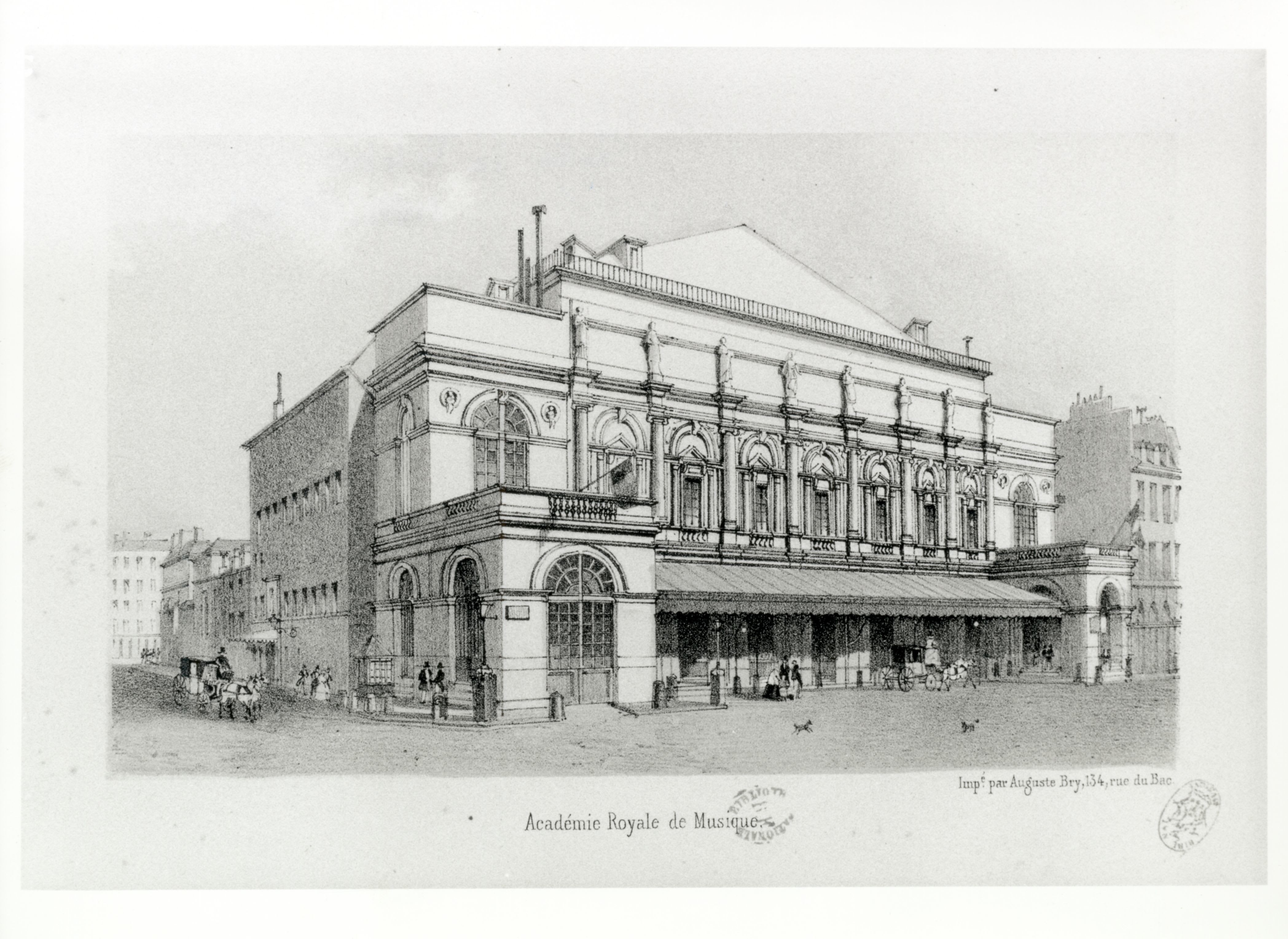
14 JANUARY 1858
Attack on the Emperor
While Napoleon III was on his way to the Opéra, then located on the street Le Peletier, Italian anarchists working for Felice Orsini threw bombs into the crowd. The very next day, the Emperor decided to build a new opera house.
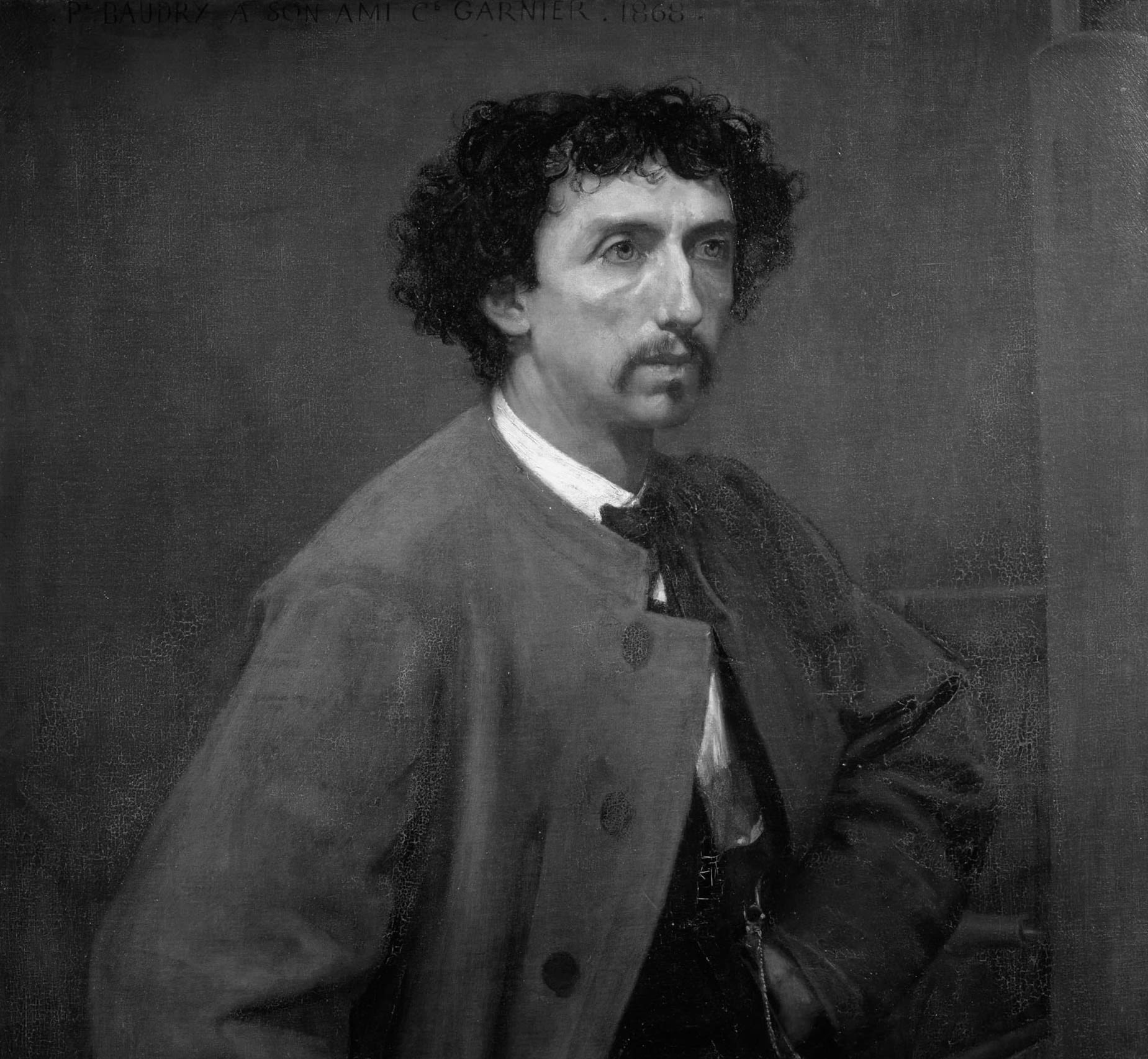
An international competition is organised
An international competition was organised for the construction of the Imperial Academy of Music and Dance. 171 architects entered the competition. Among all the candidates, the unknown Charles Garnier who was then 35 won the competition on 30 May 1861.
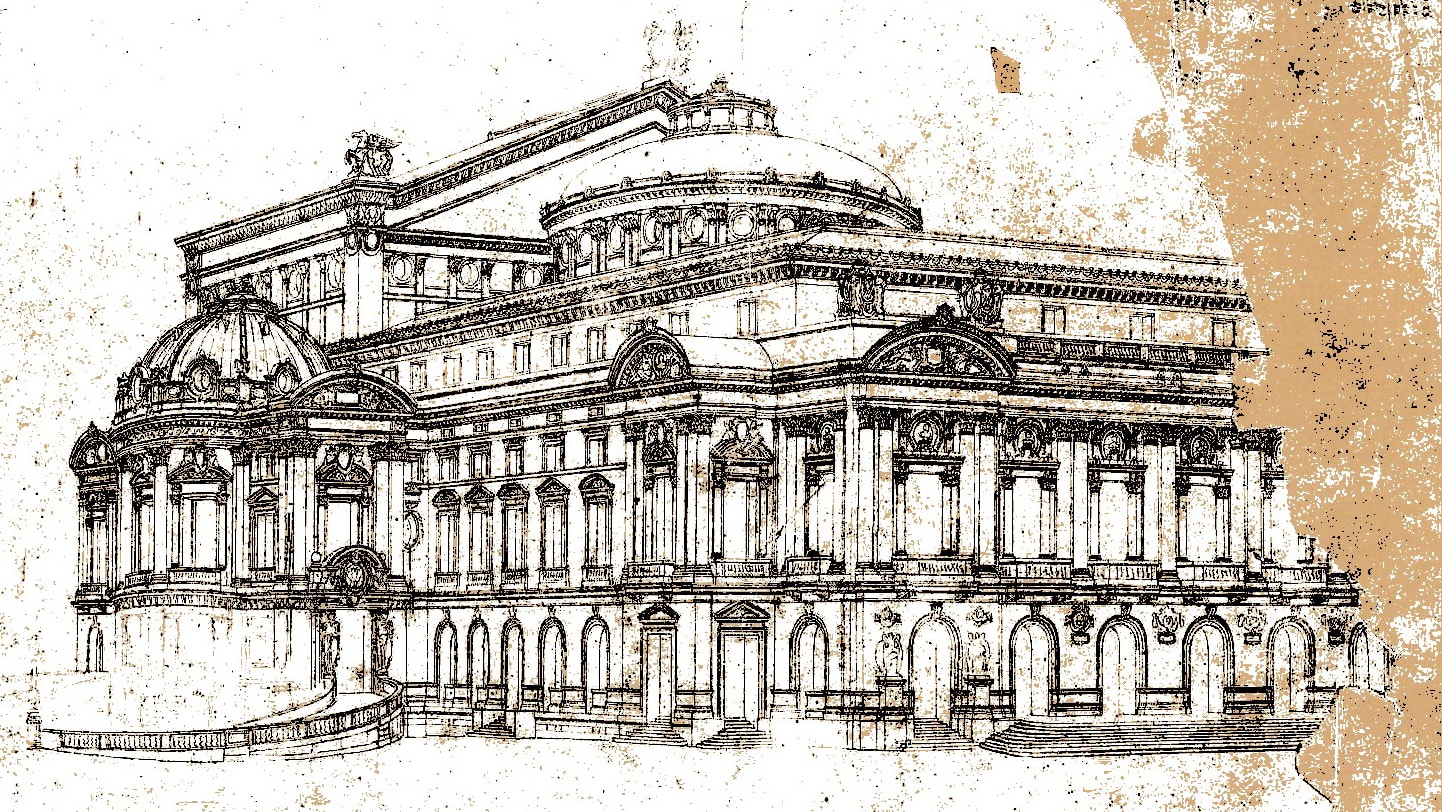
In the spring, Charles Garnier had the groundwater drained by steam pumps, which ran day and night for five months. On 21 July, the first stone was laid by the Minister of Fine Arts.
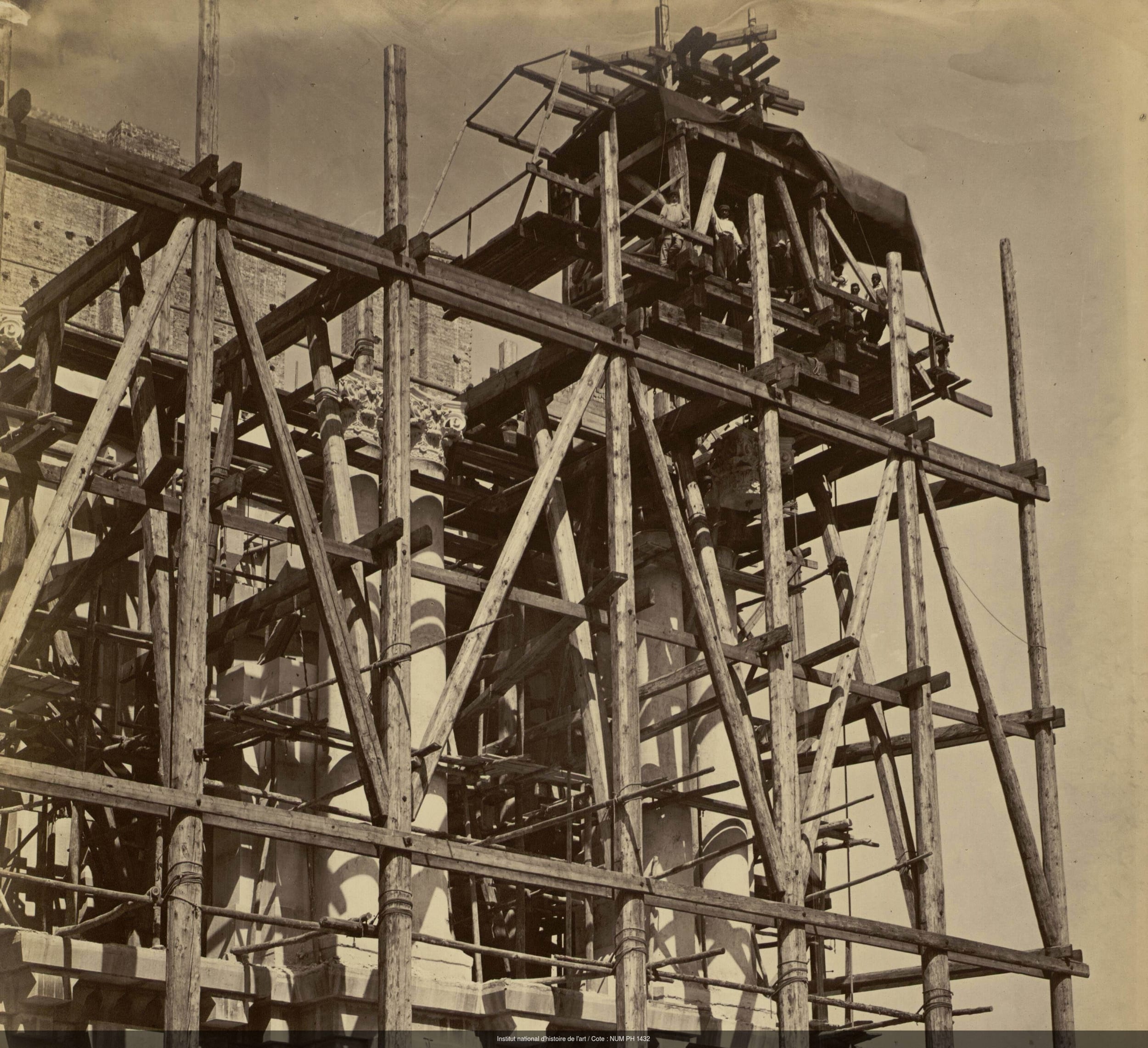
The foundations, vaults and cellars were erected. By the end of the year, the building had reached the first floor.
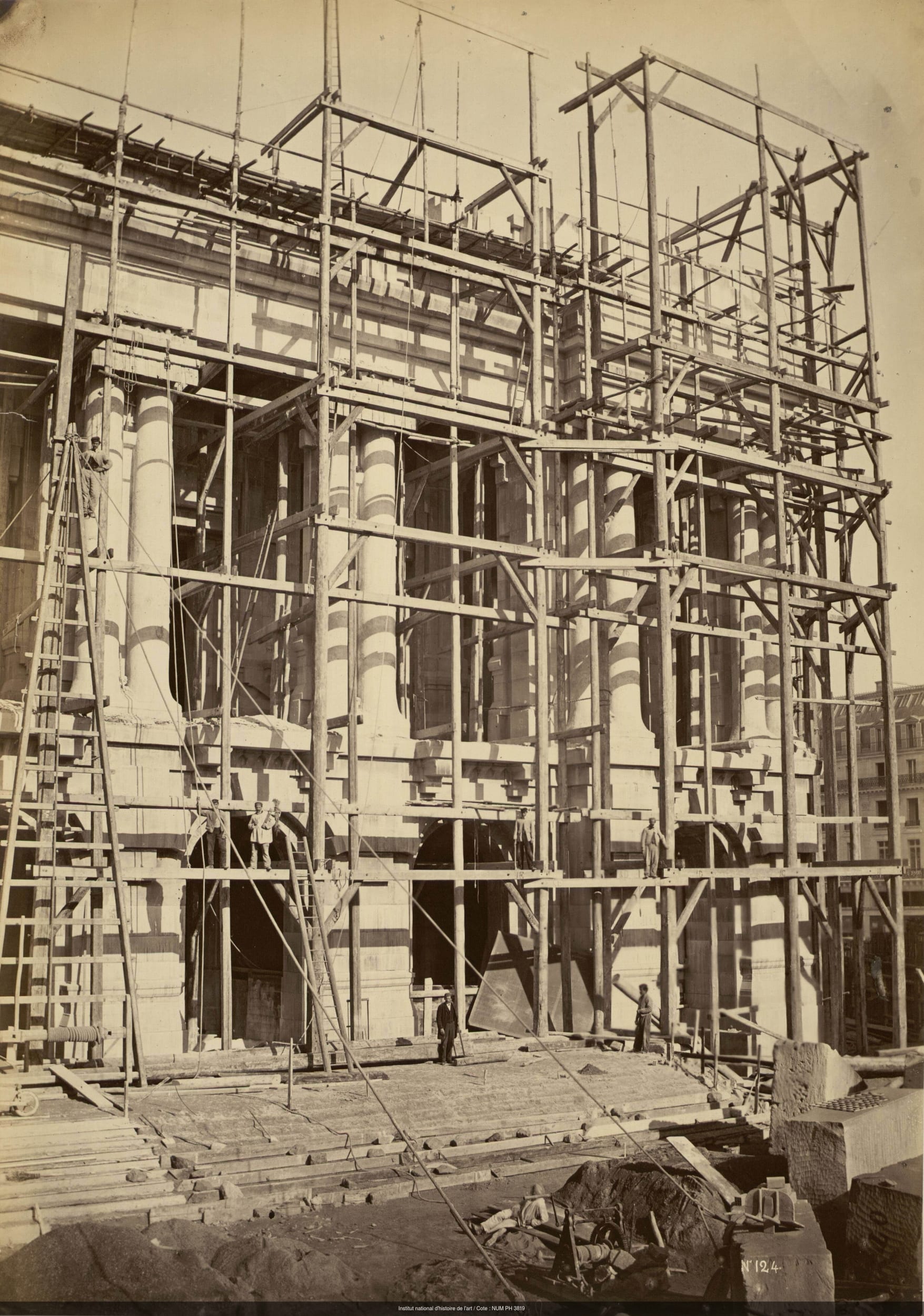
In December 1864, most of the works for the vaults, the vestibules of the main staircase and the walls of the secondary staircases were completed. The monolithic columns were placed on the façade, topped by capitals and friezes. In 1865, the building had reached half its final height.
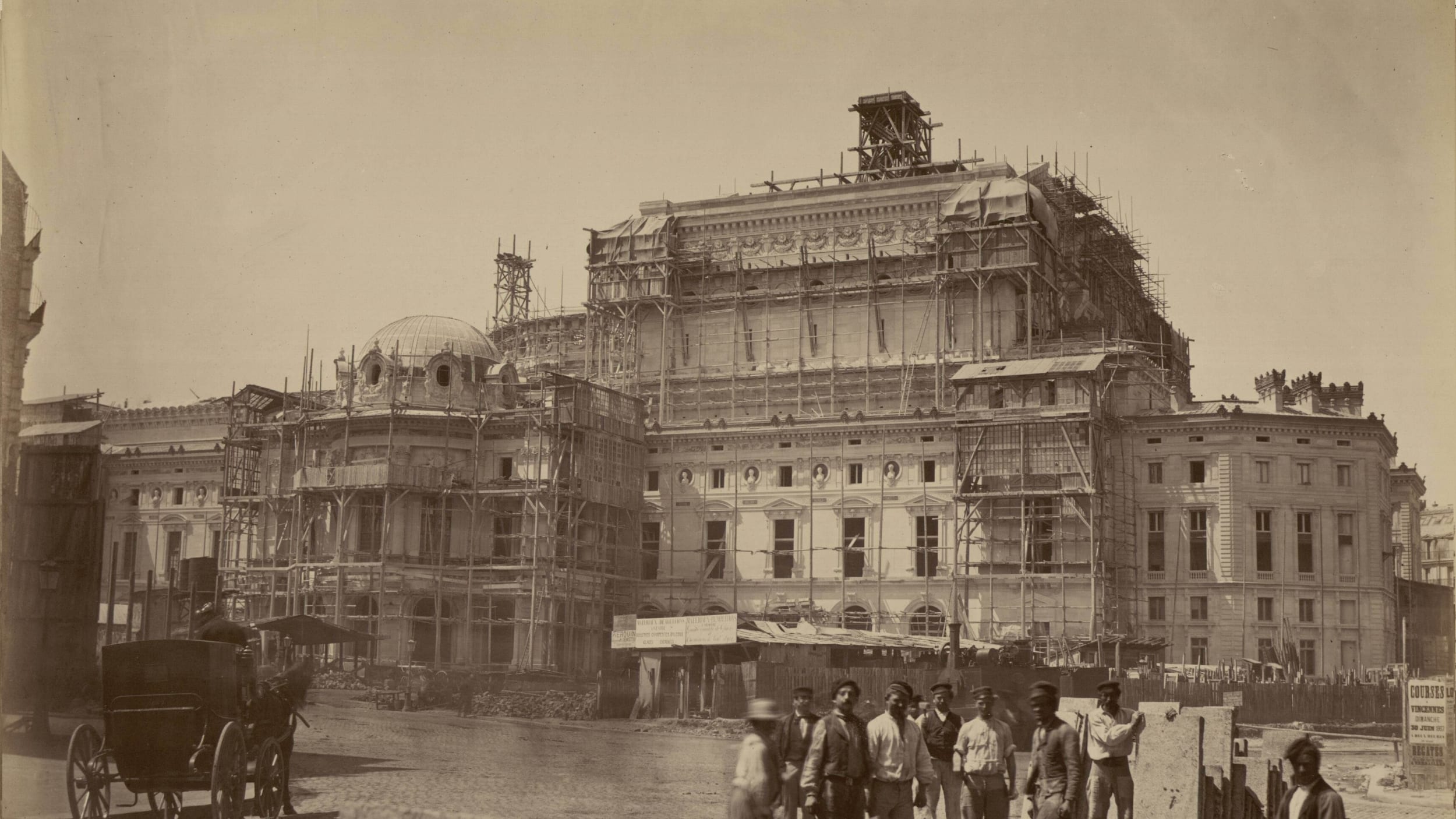
Charles Garnier built the stage and drew up plans for the machinery and gas lighting. Carpenters, painters and glaziers arrived on site as sculptors began their work on the façade.
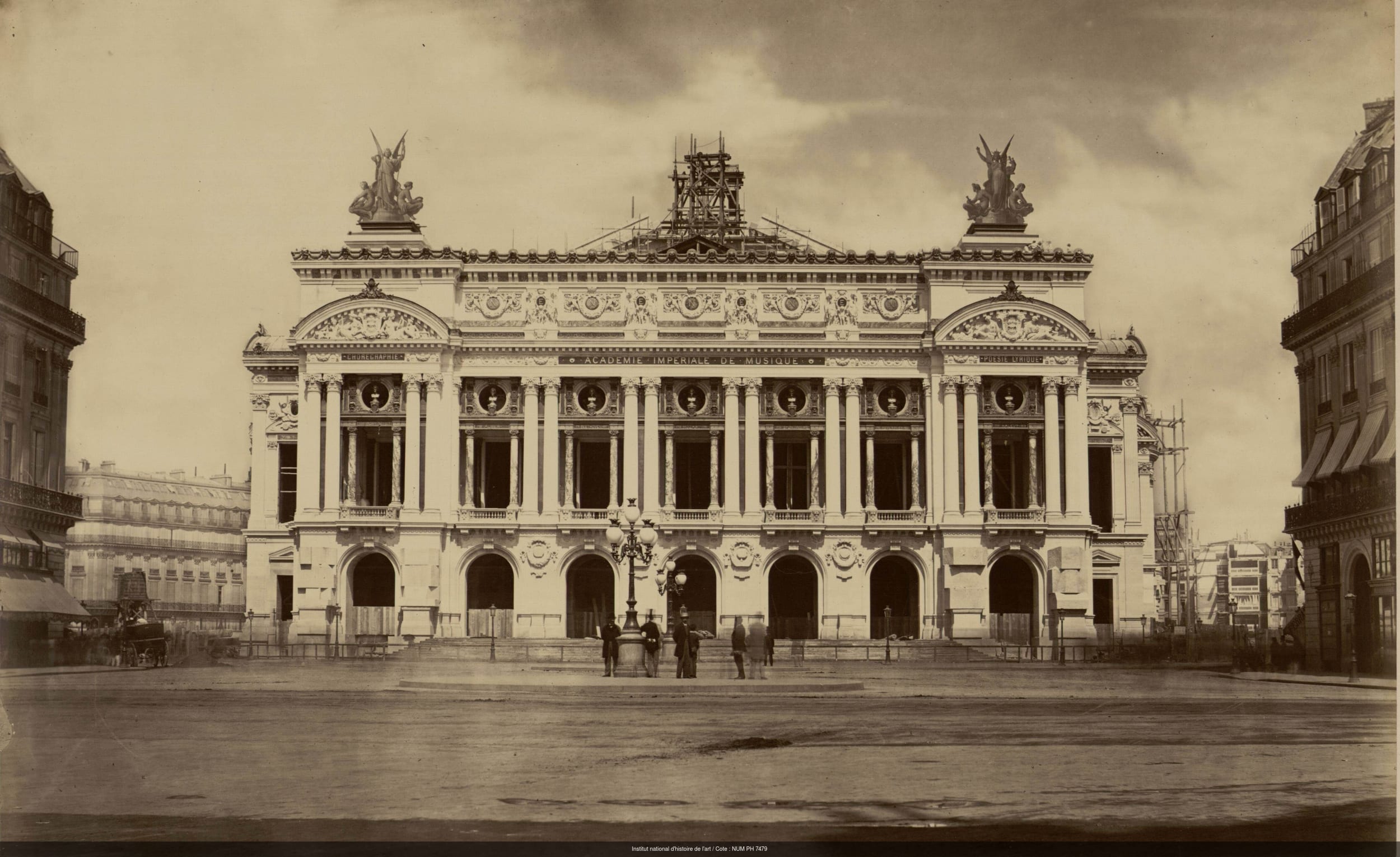
The structural work was completed and the scaffolding taken down. In August, the façade was unveiled to the public.
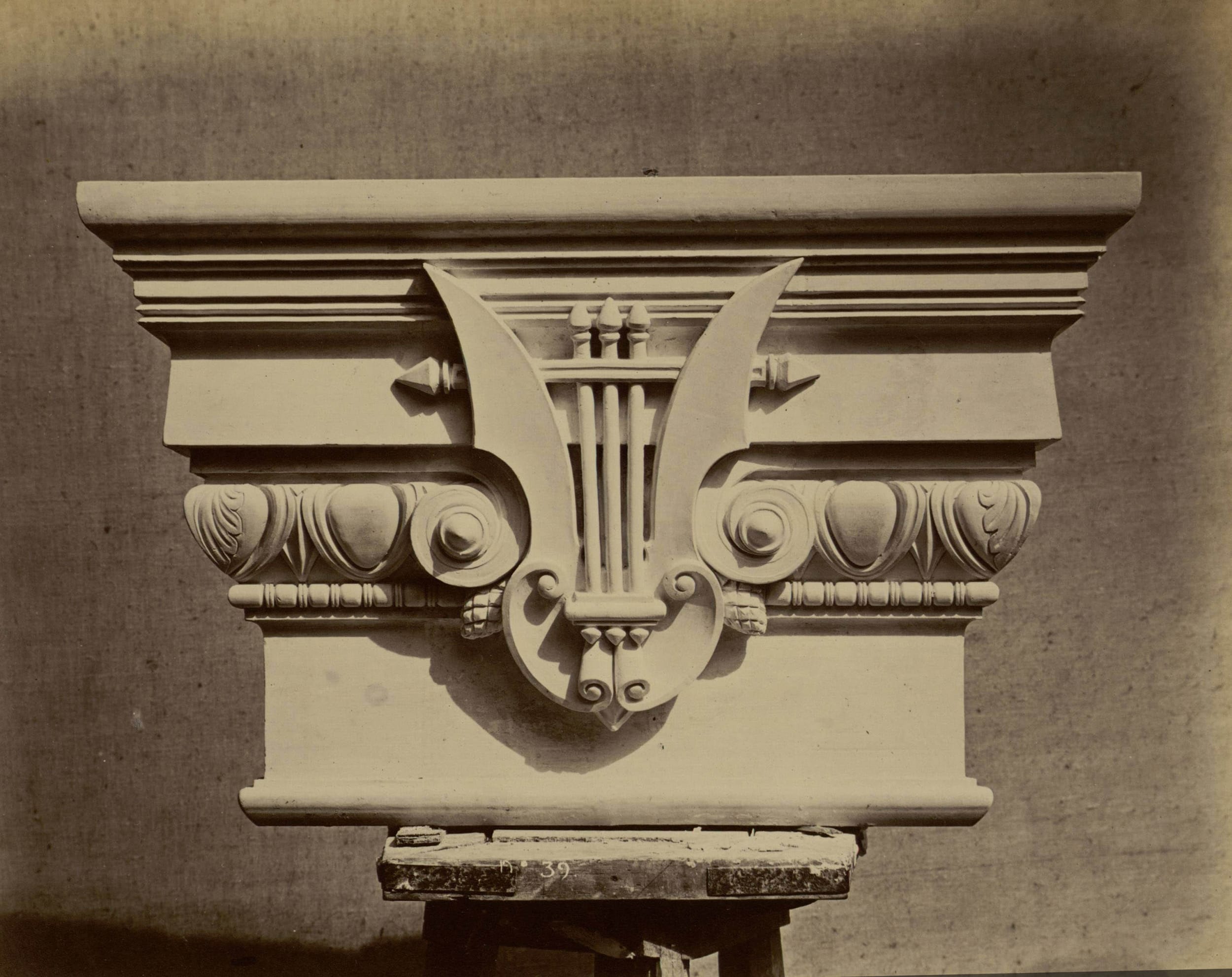
Decorative work began. The Opera was entrusted to the teams of painters and sculptors.
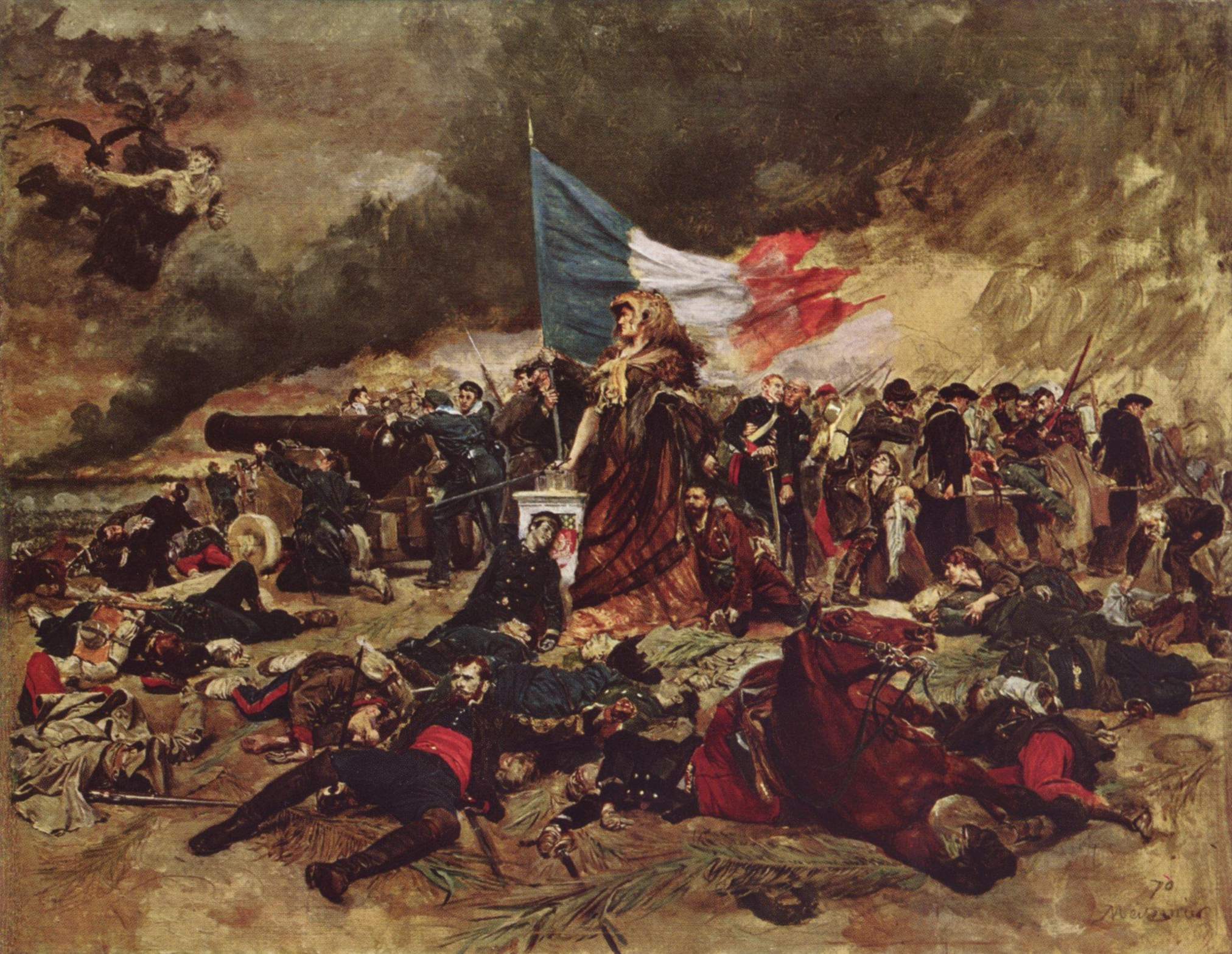
The Siege of Paris forced Charles Garnier to interrupt the construction. The Opera was requisitioned and transformed into a hospital and then military supply shops. When Napoleon III was overthrown, Charles Garnier was asked to remove the Emperor's emblems and numbers from the building.
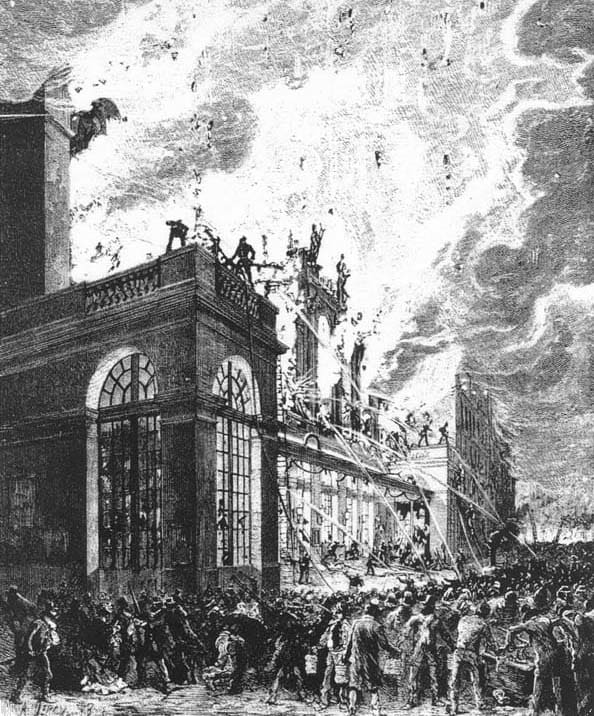
In 1871, the Opera was occupied by the Fédérés. Some restoration work was carried out in 1872, before the construction could resume. During the night of 28 to 29 October, the Opera on the street Le Peletier was destroyed by fire. Work on the new Opera was accelerated.
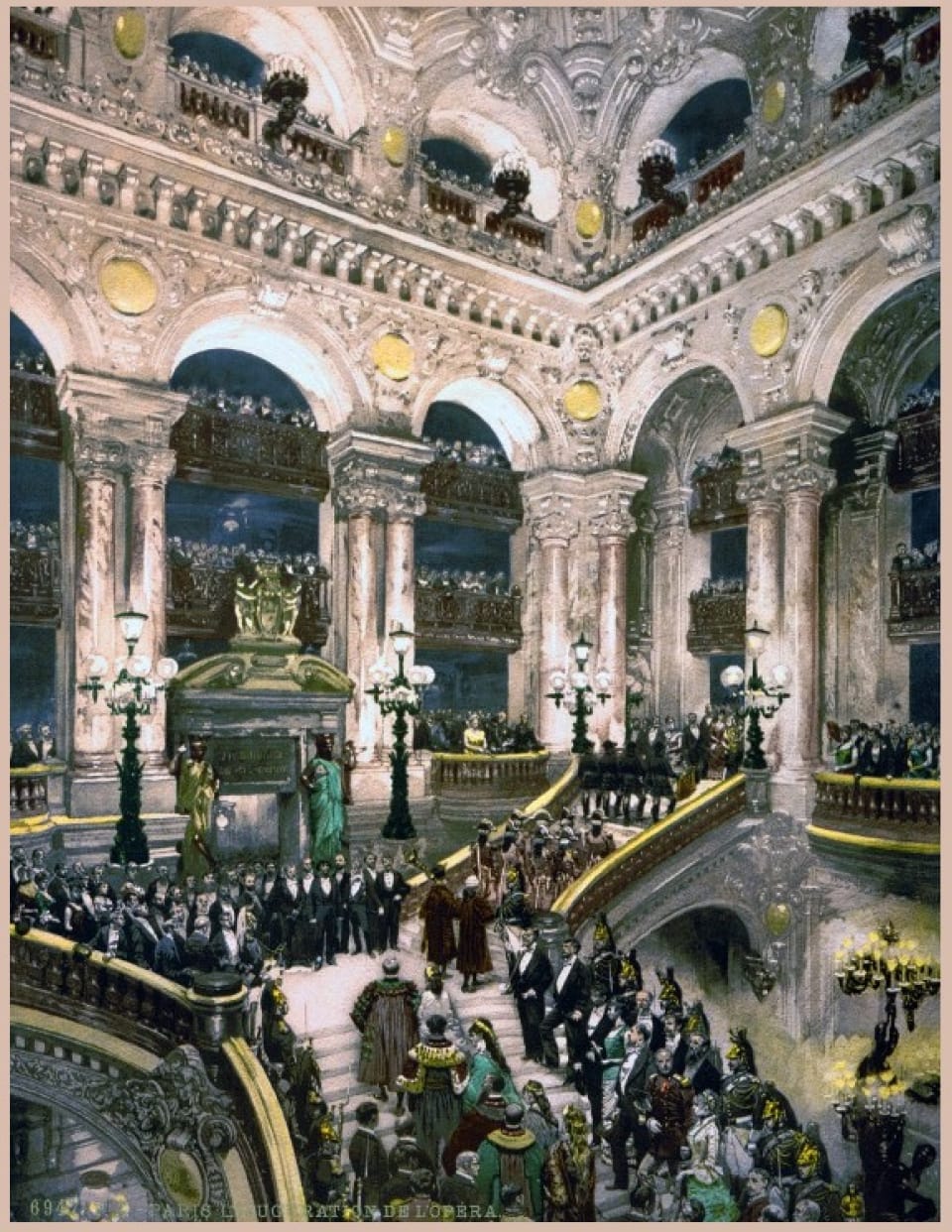
On 5 January, the new Paris Opera was inaugurated a year ahead of schedule (though the Emperor's entrance, the gallery and the salon du glacier remained unfinished). Costs amounted to just over thirty-five million gold francs.
Le grand escalier
La salle de spectacle © Brodbeck & de Barbuat / OnP
Le grand foyer © Jean-Pierre Delagarde / OnP
Le grand foyer © Brodbeck & de Barbuat / OnP
Gala, Défilé du Ballet, Palais Garnier © Agathe Poupeney / OnP
Vue de la salle de spectacle depuis le Foyer de la danse © Brodbeck & de Barbuat / OnP
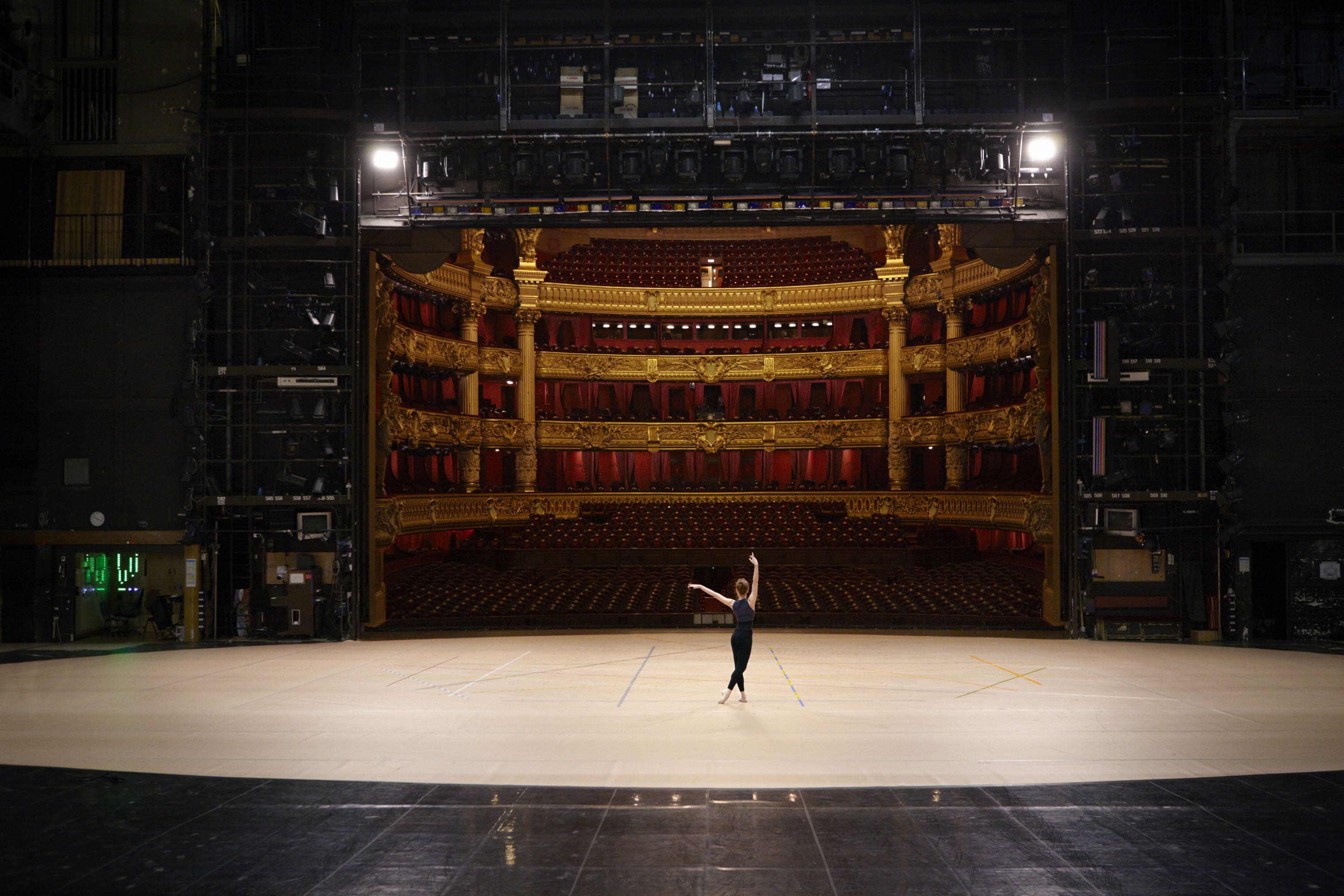
VIRTUAL TOUR
Discover this masterpiece of 19th-century theatre architecture as if you were there in person.
Charles Garnier
Discover the history of the architect of the Palais Garnier.
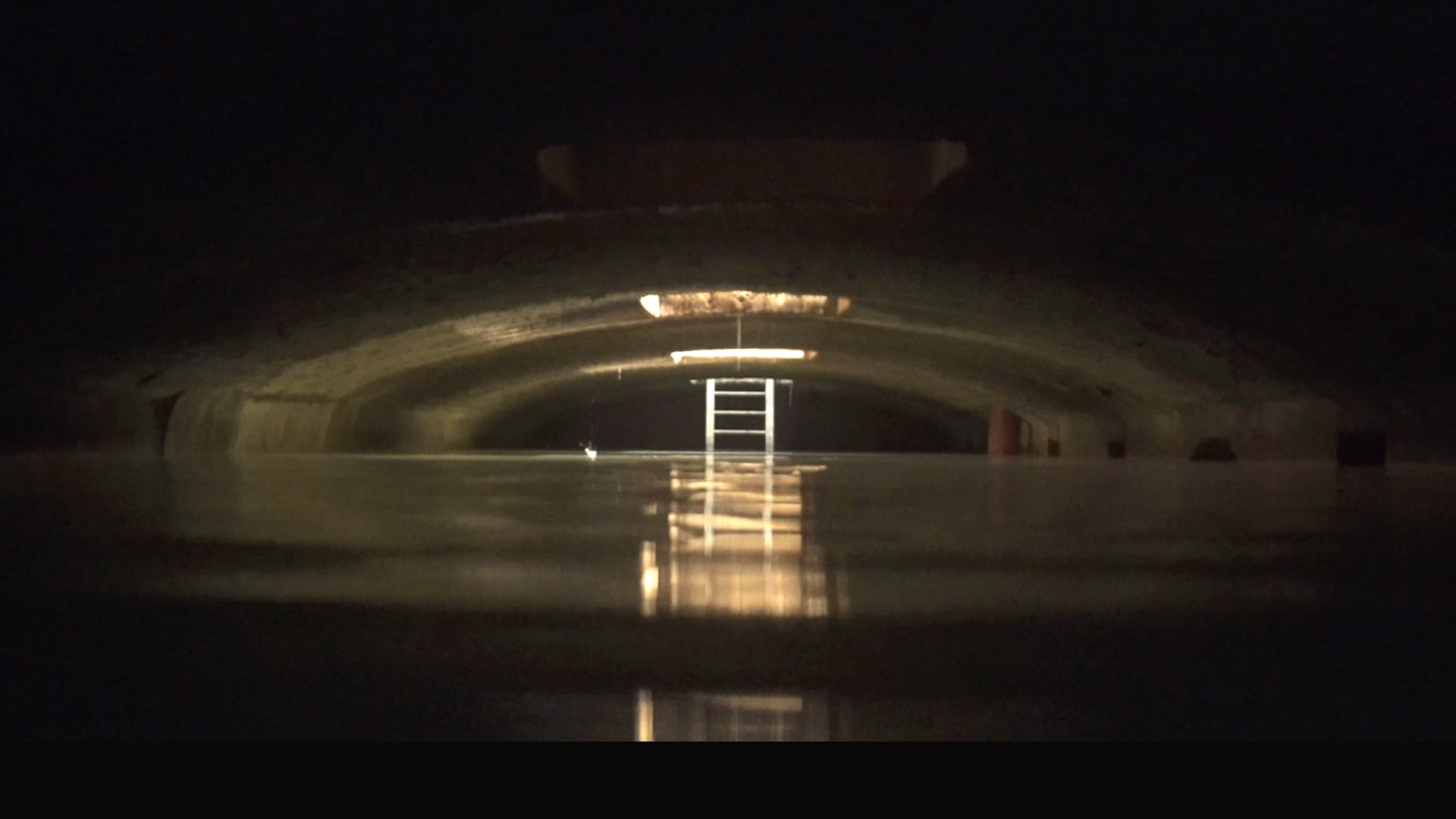
In the depths of the Palais Garnier
Is there really a lake?
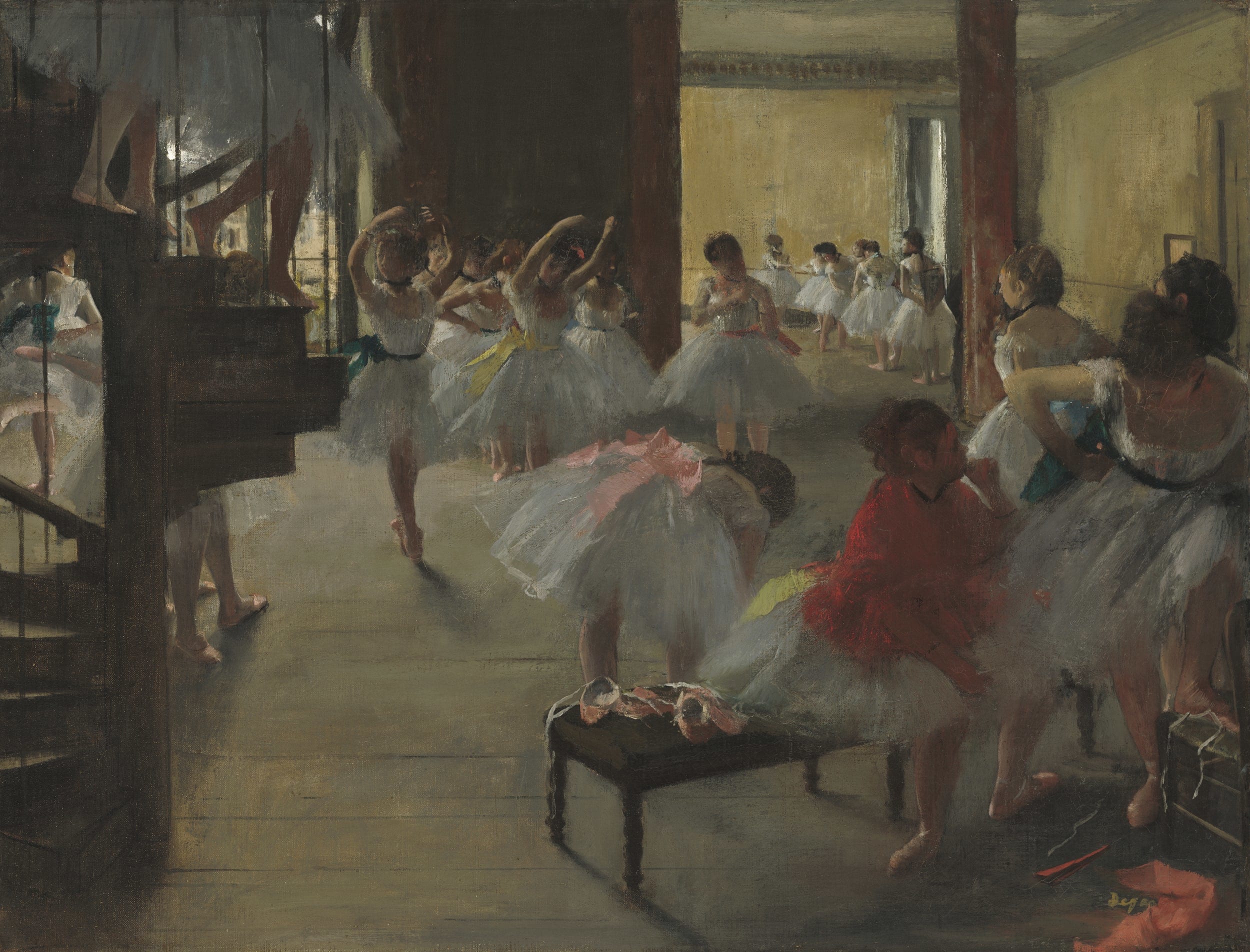
Degas at the Opera
Interview with Henri Loyrette on the occasion of the exhibition at the Musée d'Orsay.
Immerse in the Paris Opera universe
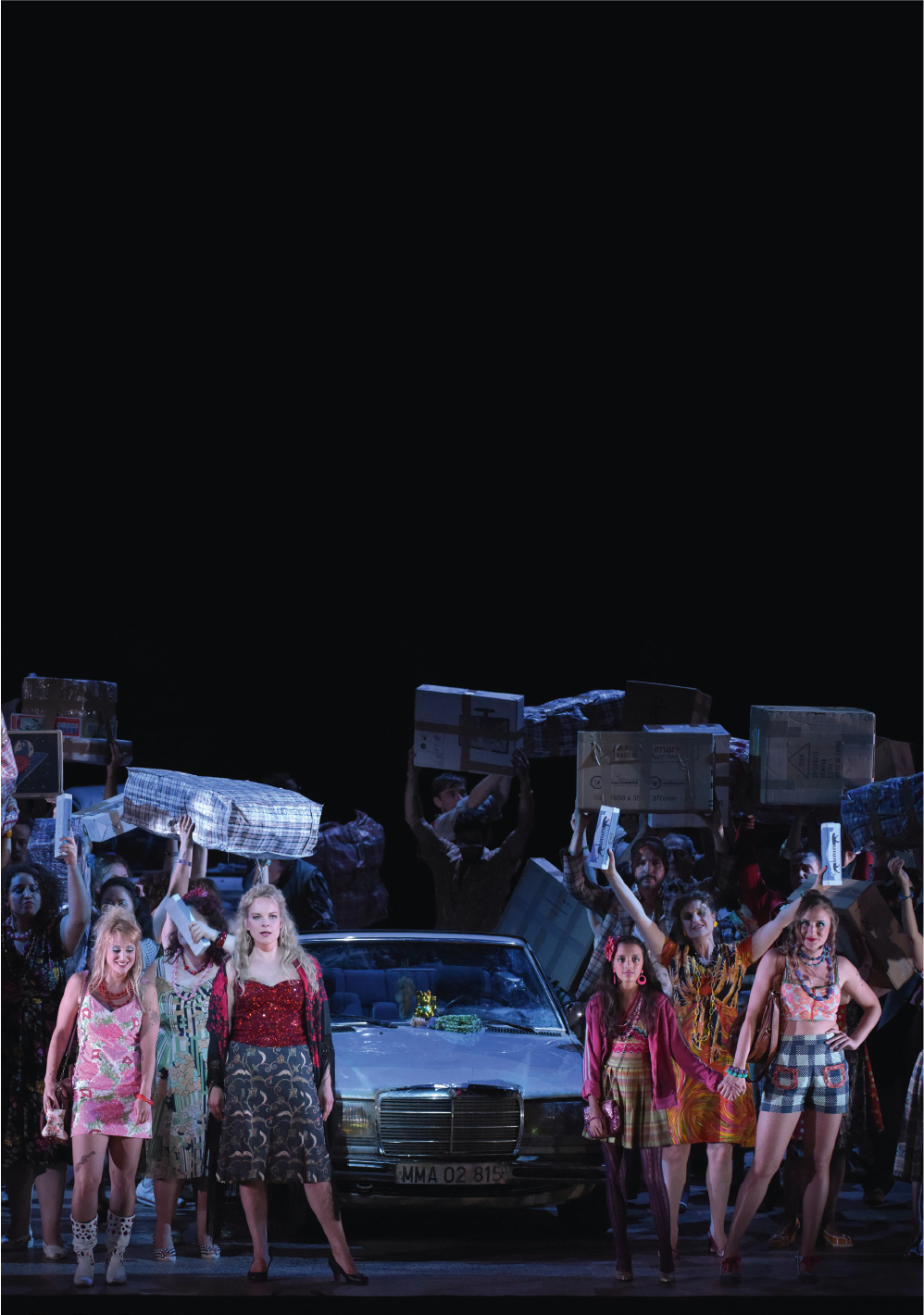
Business Space
Patronage and sponsorship.
- Your support
- The projects
- Your level of engagement
- The benefits you want to enjoy
Your public relations operations
- Premium tickets
- Business club
Rental of spaces and filming
- Rental of space Garnier
- Rental of space Bastille
Licensing program, advertising space and cultural engineering
- Licensing program
- Advertising space
- Cultural engineering
- The “Children dreams” Morning
- The Opening Gala and the “Gala des grandes voix”
Place de l’Opéra 75009 Paris
Place de la Bastille 75012 Paris

Download the application for free Opéra de Paris

Back to top

COMMENTS
The Palais Garnier offers a safe access to persons with reduced mobility, in wheelchair or with visual disabilities (except places for temporary exhibitions). Information and Booking. +33 1 40 01 18 50 (from Monday to Friday, 10am to 1pm and 2pm to 5pm). accessibilité@operadeparis.fr.
L'Opéra national de Paris vous propose de découvrir, lors d'une visite autonome, les richesses des espaces publics du Palais Garnier, chef d'œuvre de l'architecture théâtrale du XIXe siècle. Ce billet d'entrée vous donne également accès aux expositions temporaires s'il y a lieu. La réservation est fortement conseillée ...
Palais Garnier. 19,978 reviews. #8 of 3,569 things to do in Paris. Architectural BuildingsTheaters. Open now. 12:00 AM - 11:59 PM. Write a review. About. This opulent 19th-century opera house is known for its magnificent interiors and the amazing performances by the Paris Opera Ballet.
The Palais Garnier is located in Paris's relatively central 9th arrondissement, more or less directly north of the Tuileries Gardens and the adjoining Louvre Museum. ... Visitors can tour the main premises of the Opera Garnier during the day and visit the site's museum, either on an individual basis or as part of a guided tour. Opening Hours .
Palais Garnier became the center of Paris cultural life during the Belle-Époque period of the late 19th and early 20th centuries. It continued on as France's most prestigious opera house right through the World Wars and into the 1960s. ... The interior is just as breathtaking, and it's a must-visit place — particularly to attend a ...
The opera house is a must visit attraction in the 9th arrondissement. A creation of Charles Garnier, it was part of Napoleon's great makeover of Paris. It's highly decorative, a mix of Beaux-Arts symmetry and Baroque and Renaissance elements. facade of the Opera Garnier. Visiting Paris' Opera Garnier is a dual-purpose immersive experience.
Visit Palais Garnier, Paris' Opera House. The Palais Garnier Opera House (Opera Garnier) is one of the most unique places in Paris, France.A visit to the Paris Opera House for a show or a guided tour is one of the best things to do in Paris, so you cannot miss it!The Palais Garnier is located in Paris 9, not far from the Grands Boulevards or Place Vendôme.
It's an opera house, museum, library, and architectural marvel. With nearly 480,000 visitors each year, the Palais Garnier is one of Paris' most visited monuments. It has been listed as a historical monument since 1923. Whether you want to enjoy the architecture from the outside alone, take a tour indoors, or splurge on a show, this is an ...
For pure grandeur, nothing is quite like a visit to the Palais Garnier - the Opera House of Paris, located at Place de l'Opera in the 9th Arrondissement.. Even if taking in a ballet or opera performance is not on your agenda, you can still experience this magnificent building that is a homage to French decorative architecture of the late 19th‐century.
A visit to the Palais Garnier can be undertaken independently or with a guide. Multimedia audio guides (on smartphone or iPad) are available to the public to learn more about the building and unravel its secrets. Ideal for exploring the opera house in greater depth: anecdotes, details and documents from the era make a visit even more enriching ...
Palais Garnier, Opéra Bastille. On-line ticket sales. Plan your visit
From$16.34. Paris. Opéra Garnier: Entry + Arsène Lupin Immersive Game. Discover the new immersive game in the heart of the Palais Garnier! 4.5(158) From$30.50. Paris. Perfume Making Workshop & Guided Visit of Fragonard Perfume Museum. Take a guided tour of Fragonard Perfume Museum and join a perfume making worksop.
Combined tickets. Visit of the Opéra Garnier and Sightseeing Cruise on the Seine. Exclusive offer: Save €4.70. E-ticket for Opera Garnier. Cruise on the Seine (departure from Pont de l'Alma, duration 1h10) €26.30 €31. Select. Opera Garnier and Sainte-Chapelle in Paris. Exclusive offer: Save €1.40.
With an entrance ticket, you can visit this magnificent Italian-style opera house. Find out all you need to know before you come. Palais Garnier: mirroring the artistic soul of Paris. Designed by Charles Garnier and inaugurated in 1875, the Opéra Garnier, also known as the Palais Garnier, is housed in a magnificent building. It is a historic ...
The Palais Garnier (French: [palɛ ɡaʁnje] ⓘ, Garnier Palace), also known as Opéra Garnier (French: [ɔpeʁa ɡaʁnje] ⓘ, Garnier Opera), is a historic 1,979-seat opera house at the Place de l'Opéra in the 9th arrondissement of Paris, France.It was built for the Paris Opera from 1861 to 1875 at the behest of Emperor Napoleon III. Initially referred to as le nouvel Opéra de Paris (the ...
For a little back story, the Palais Garnier is a master piece of 19th century theater art architecture. It is without a doubt one of the most beautiful architectural structures in Paris, and one of the most beautiful theatres in Europe. There are 1,979 seats inside the opera house at the Place de l'Opéra. While it is still operational today ...
Palais Garnier, also known as the Opera Garnier Paris or simply the Paris Opera is an architectural jewel in Paris with a fascinating history and prime status in Paris's ballet and classical music milieu. An ode to Parisian architecture, the Palais Garnier is an enchanting inspiration for many and undeniably one of the most distinguished and grand opera houses in the world.
Days and opening hours. All year round, daily between 10 am and 5 pm. Closed exceptionally on January 1st, May 1st and December 25th. The Palais Garnier is open every day from 10am to 5pm (tickets sold until 4pm), except for daytime performances and exceptional closures. The last entrance is 45 minutes before closing time.
The Opera Garnier, also named Paris Opera, or Palais Garnier, is a Second-Empire Opera built in 1875 by Charles Garnier, under Emperor Napoleon III. The building is massive: 56 meters high (184 feet), 155 meters long (508 feet) and 101 meters wide (332 feet). Most people know the Opera Garnier building; its external appearance.
Palais Garnier. Place de l'Opéra. 75009 Paris. operadeparis.fr. S'offrir une virée shopping dans les Grands Magasins. À quelques pas de l'Opéra, on plonge dans le grand temple du ...
Theaters and Workshops : Palais Garnier. Designed by architect Charles Garnier in 1875, the Palais Garnier hosts a prestigious auditorium and various public areas (grand foyer, rotonde des abonnés, lounges), as well as a museum-library and different rehearsal studios and workshops. The Italian-style auditorium, with its ceiling painted in 1964 ...